Entrepreneurship Leadership and Innovation: Amazon Case Study
VerifiedAdded on 2023/04/21
|69
|17483
|255
AI Summary
The aim of the study is to analyze the real meaning of entrepreneurship and its relation to innovation and creativity for Amazon. The study focuses on the case study of Jeff Bezos and the success of Amazon. It examines the challenges and benefits of entrepreneurship, leadership principles, and the connection between entrepreneurship and innovation. The research aims to understand the criteria for successful entrepreneurship and the role of creativity and innovation in achieving success.
Contribute Materials
Your contribution can guide someone’s learning journey. Share your
documents today.
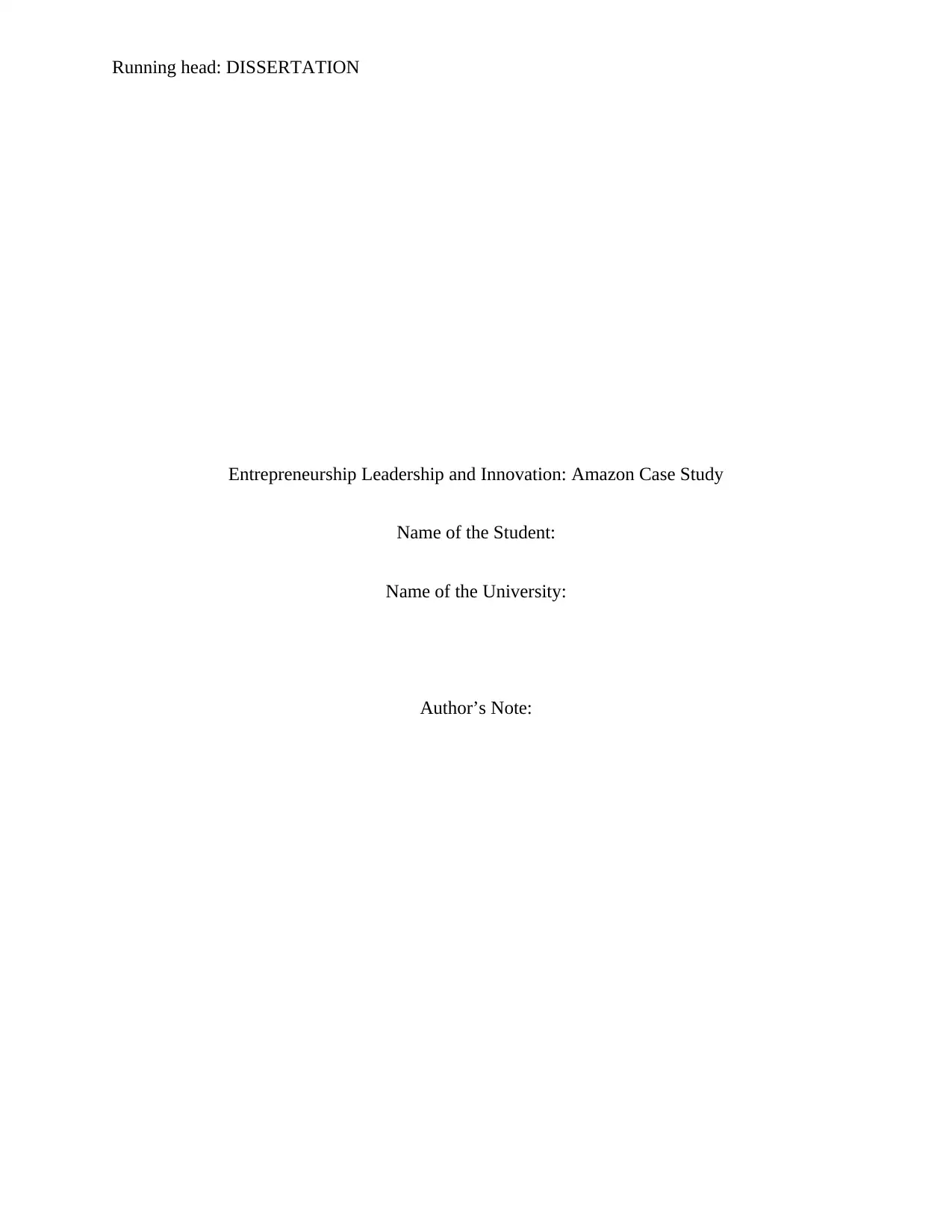
Running head: DISSERTATION
Entrepreneurship Leadership and Innovation: Amazon Case Study
Name of the Student:
Name of the University:
Author’s Note:
Entrepreneurship Leadership and Innovation: Amazon Case Study
Name of the Student:
Name of the University:
Author’s Note:
Secure Best Marks with AI Grader
Need help grading? Try our AI Grader for instant feedback on your assignments.

1DISSERTATION
Acknowledgement
Thank you to all of those who have helped listened and encouraged me throughout this study. I
am indebted to my supervisor ……………………. whose guidance, advice and patience have
been immeasurable. My sincere thanks to all members of the…………… [Mention your
university/college name], both staff and students, whose continuous support have made this
thesis possible.
I would like to thank all of the participants in the study: students, teachers and Local Education
Authorities, for the time and help given throughout. Without their participation, this research
would not have been possible. In this context, I am also thankful to them, whose research work
helped me to execute this paper well.
Finally, I thank my family, without whom this thesis would not have been started or completed!
Your encouragement and support have never faltered; thank you.
Acknowledgement
Thank you to all of those who have helped listened and encouraged me throughout this study. I
am indebted to my supervisor ……………………. whose guidance, advice and patience have
been immeasurable. My sincere thanks to all members of the…………… [Mention your
university/college name], both staff and students, whose continuous support have made this
thesis possible.
I would like to thank all of the participants in the study: students, teachers and Local Education
Authorities, for the time and help given throughout. Without their participation, this research
would not have been possible. In this context, I am also thankful to them, whose research work
helped me to execute this paper well.
Finally, I thank my family, without whom this thesis would not have been started or completed!
Your encouragement and support have never faltered; thank you.

2DISSERTATION
Abstract
The aim of the study is to analyze the real meaning of entrepreneurship and its relation to
innovation as well as creativity for Amazon. Increased number of similar business organizations
has to lead to tough and fierce competition in the market resulting in to market saturation due to
which the business organizations have to develop strategies to stand out of the crowd and mark a
unique image in the eye of the customers. Successful entrepreneurship results in the innovation
and creativity that have the ability to improve the standard of living by adding entrepreneurial
ventures and creating wealth for the entrepreneurs.
The background of the topic is to study the entrepreneurial approach and its relationship with
creativity and innovation by referring to the case study of Amazon. Jeff Bezos has shown
immense creativity and innovation compared to the booksellers that were not appealing to the
customers. Investigating the relationship between entrepreneurship and creativity and innovation
allowed investigating the issues and challenges Jeff Bezos faced being an entrepreneur and while
implementing creativity and innovation. Amazon was established in 1994 Seattle, Washington
by Jeff Bezos is a multinational technology and largest e-commerce and cloud computing
platform.
The main challenge in this research is that the relationship between entrepreneurship and
creativity and innovation is difficult to investigate. In addition to, the practicality of ideas that
revolves around creativity and innovation is another challenge. Another issue, in this case, is that
the entrepreneurs have tough competition in the market and emphasizes more on competitors
rather than on the target customers. The purpose of the study is to contemplate on the real
meaning of entrepreneurship and its relationship with creativity and innovation for every
Abstract
The aim of the study is to analyze the real meaning of entrepreneurship and its relation to
innovation as well as creativity for Amazon. Increased number of similar business organizations
has to lead to tough and fierce competition in the market resulting in to market saturation due to
which the business organizations have to develop strategies to stand out of the crowd and mark a
unique image in the eye of the customers. Successful entrepreneurship results in the innovation
and creativity that have the ability to improve the standard of living by adding entrepreneurial
ventures and creating wealth for the entrepreneurs.
The background of the topic is to study the entrepreneurial approach and its relationship with
creativity and innovation by referring to the case study of Amazon. Jeff Bezos has shown
immense creativity and innovation compared to the booksellers that were not appealing to the
customers. Investigating the relationship between entrepreneurship and creativity and innovation
allowed investigating the issues and challenges Jeff Bezos faced being an entrepreneur and while
implementing creativity and innovation. Amazon was established in 1994 Seattle, Washington
by Jeff Bezos is a multinational technology and largest e-commerce and cloud computing
platform.
The main challenge in this research is that the relationship between entrepreneurship and
creativity and innovation is difficult to investigate. In addition to, the practicality of ideas that
revolves around creativity and innovation is another challenge. Another issue, in this case, is that
the entrepreneurs have tough competition in the market and emphasizes more on competitors
rather than on the target customers. The purpose of the study is to contemplate on the real
meaning of entrepreneurship and its relationship with creativity and innovation for every
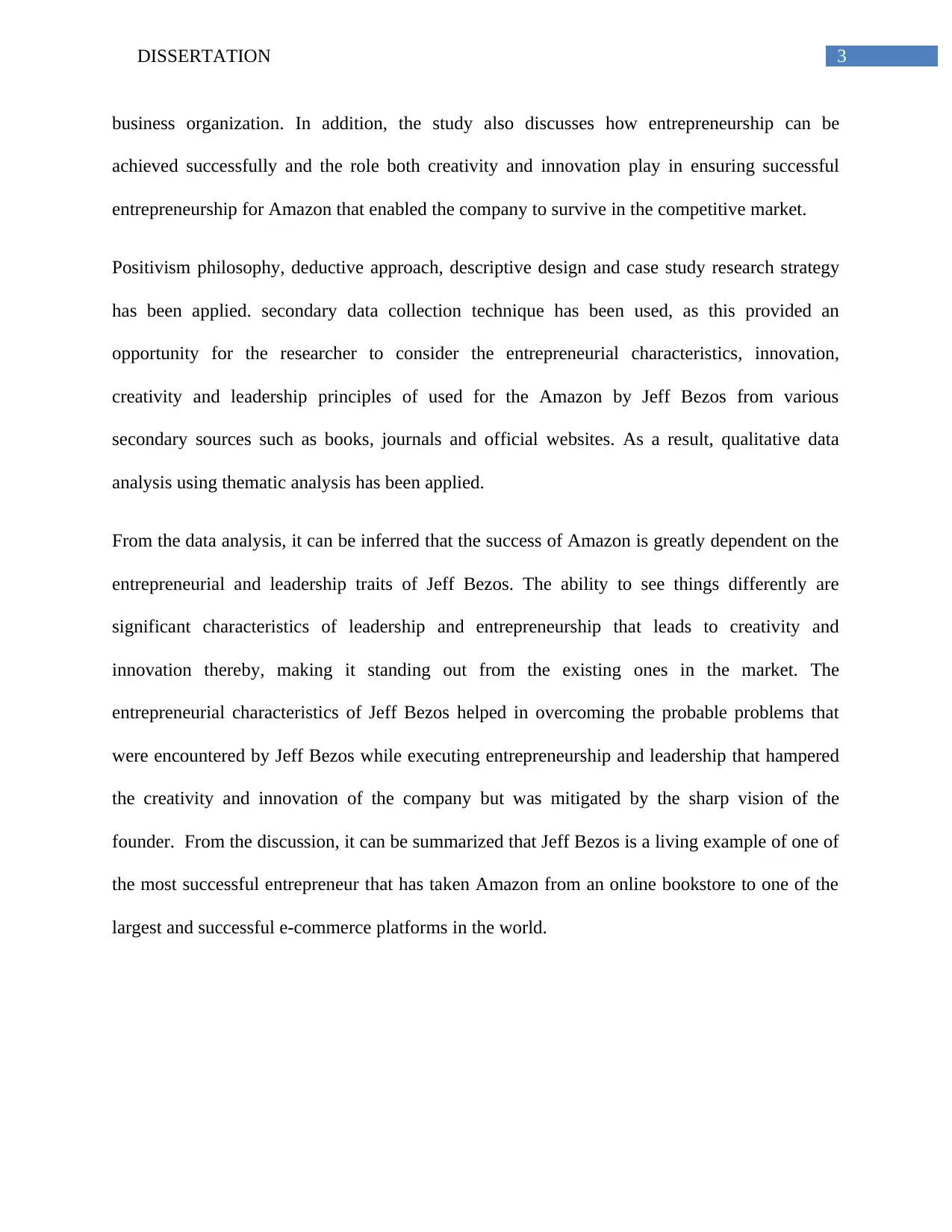
3DISSERTATION
business organization. In addition, the study also discusses how entrepreneurship can be
achieved successfully and the role both creativity and innovation play in ensuring successful
entrepreneurship for Amazon that enabled the company to survive in the competitive market.
Positivism philosophy, deductive approach, descriptive design and case study research strategy
has been applied. secondary data collection technique has been used, as this provided an
opportunity for the researcher to consider the entrepreneurial characteristics, innovation,
creativity and leadership principles of used for the Amazon by Jeff Bezos from various
secondary sources such as books, journals and official websites. As a result, qualitative data
analysis using thematic analysis has been applied.
From the data analysis, it can be inferred that the success of Amazon is greatly dependent on the
entrepreneurial and leadership traits of Jeff Bezos. The ability to see things differently are
significant characteristics of leadership and entrepreneurship that leads to creativity and
innovation thereby, making it standing out from the existing ones in the market. The
entrepreneurial characteristics of Jeff Bezos helped in overcoming the probable problems that
were encountered by Jeff Bezos while executing entrepreneurship and leadership that hampered
the creativity and innovation of the company but was mitigated by the sharp vision of the
founder. From the discussion, it can be summarized that Jeff Bezos is a living example of one of
the most successful entrepreneur that has taken Amazon from an online bookstore to one of the
largest and successful e-commerce platforms in the world.
business organization. In addition, the study also discusses how entrepreneurship can be
achieved successfully and the role both creativity and innovation play in ensuring successful
entrepreneurship for Amazon that enabled the company to survive in the competitive market.
Positivism philosophy, deductive approach, descriptive design and case study research strategy
has been applied. secondary data collection technique has been used, as this provided an
opportunity for the researcher to consider the entrepreneurial characteristics, innovation,
creativity and leadership principles of used for the Amazon by Jeff Bezos from various
secondary sources such as books, journals and official websites. As a result, qualitative data
analysis using thematic analysis has been applied.
From the data analysis, it can be inferred that the success of Amazon is greatly dependent on the
entrepreneurial and leadership traits of Jeff Bezos. The ability to see things differently are
significant characteristics of leadership and entrepreneurship that leads to creativity and
innovation thereby, making it standing out from the existing ones in the market. The
entrepreneurial characteristics of Jeff Bezos helped in overcoming the probable problems that
were encountered by Jeff Bezos while executing entrepreneurship and leadership that hampered
the creativity and innovation of the company but was mitigated by the sharp vision of the
founder. From the discussion, it can be summarized that Jeff Bezos is a living example of one of
the most successful entrepreneur that has taken Amazon from an online bookstore to one of the
largest and successful e-commerce platforms in the world.
Secure Best Marks with AI Grader
Need help grading? Try our AI Grader for instant feedback on your assignments.
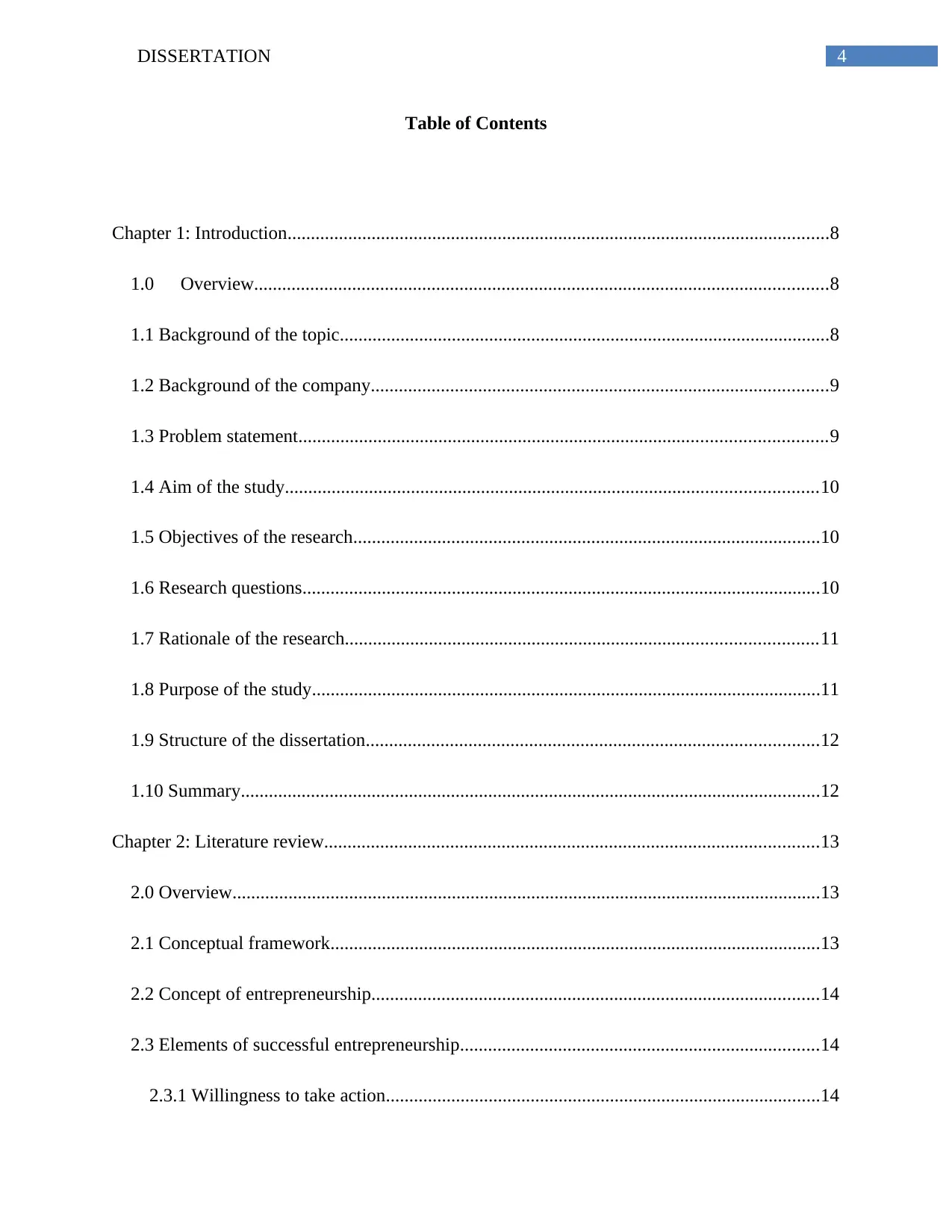
4DISSERTATION
Table of Contents
Chapter 1: Introduction....................................................................................................................8
1.0 Overview...........................................................................................................................8
1.1 Background of the topic.........................................................................................................8
1.2 Background of the company..................................................................................................9
1.3 Problem statement.................................................................................................................9
1.4 Aim of the study..................................................................................................................10
1.5 Objectives of the research....................................................................................................10
1.6 Research questions...............................................................................................................10
1.7 Rationale of the research.....................................................................................................11
1.8 Purpose of the study.............................................................................................................11
1.9 Structure of the dissertation.................................................................................................12
1.10 Summary............................................................................................................................12
Chapter 2: Literature review..........................................................................................................13
2.0 Overview..............................................................................................................................13
2.1 Conceptual framework.........................................................................................................13
2.2 Concept of entrepreneurship................................................................................................14
2.3 Elements of successful entrepreneurship.............................................................................14
2.3.1 Willingness to take action.............................................................................................14
Table of Contents
Chapter 1: Introduction....................................................................................................................8
1.0 Overview...........................................................................................................................8
1.1 Background of the topic.........................................................................................................8
1.2 Background of the company..................................................................................................9
1.3 Problem statement.................................................................................................................9
1.4 Aim of the study..................................................................................................................10
1.5 Objectives of the research....................................................................................................10
1.6 Research questions...............................................................................................................10
1.7 Rationale of the research.....................................................................................................11
1.8 Purpose of the study.............................................................................................................11
1.9 Structure of the dissertation.................................................................................................12
1.10 Summary............................................................................................................................12
Chapter 2: Literature review..........................................................................................................13
2.0 Overview..............................................................................................................................13
2.1 Conceptual framework.........................................................................................................13
2.2 Concept of entrepreneurship................................................................................................14
2.3 Elements of successful entrepreneurship.............................................................................14
2.3.1 Willingness to take action.............................................................................................14
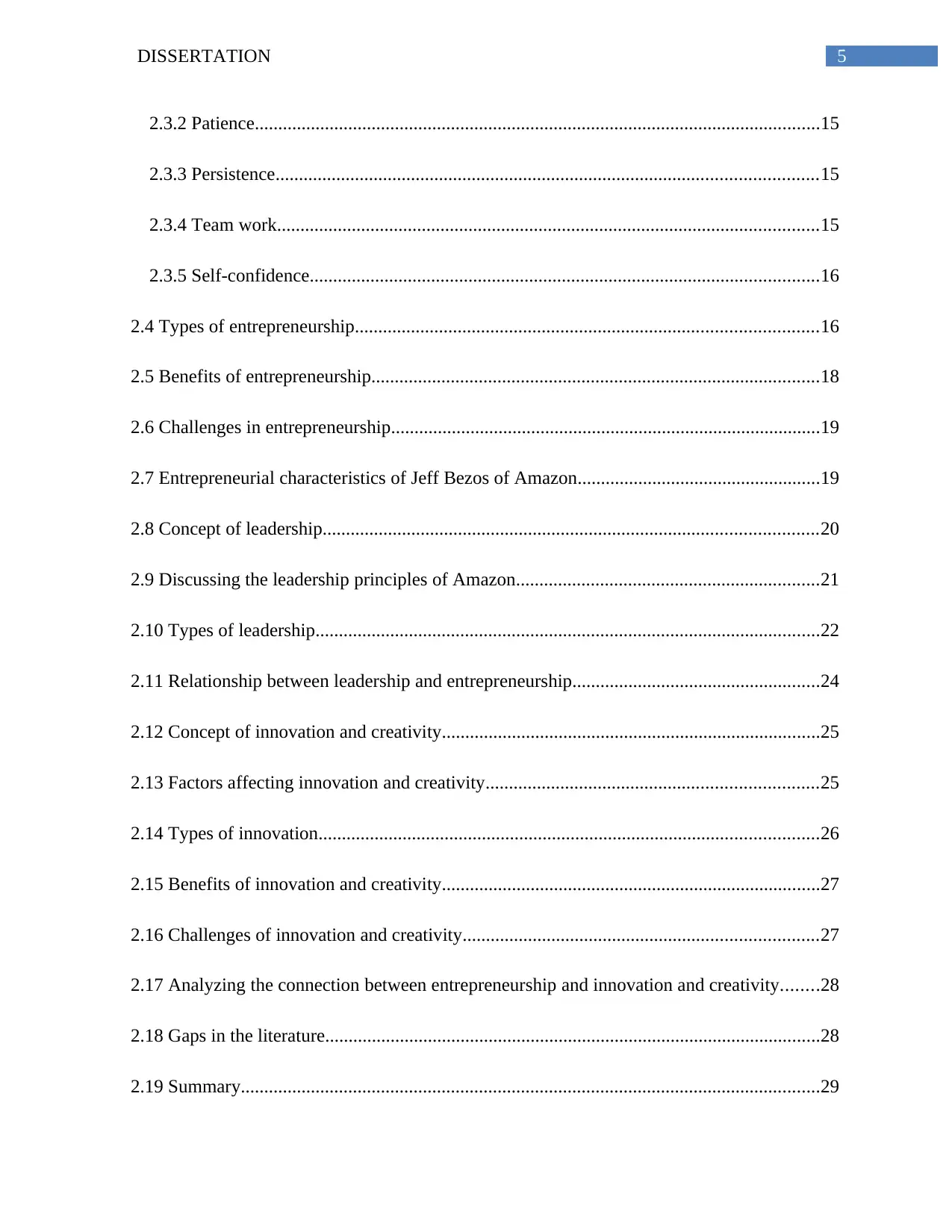
5DISSERTATION
2.3.2 Patience.........................................................................................................................15
2.3.3 Persistence....................................................................................................................15
2.3.4 Team work....................................................................................................................15
2.3.5 Self-confidence.............................................................................................................16
2.4 Types of entrepreneurship...................................................................................................16
2.5 Benefits of entrepreneurship................................................................................................18
2.6 Challenges in entrepreneurship............................................................................................19
2.7 Entrepreneurial characteristics of Jeff Bezos of Amazon....................................................19
2.8 Concept of leadership..........................................................................................................20
2.9 Discussing the leadership principles of Amazon.................................................................21
2.10 Types of leadership............................................................................................................22
2.11 Relationship between leadership and entrepreneurship.....................................................24
2.12 Concept of innovation and creativity.................................................................................25
2.13 Factors affecting innovation and creativity.......................................................................25
2.14 Types of innovation...........................................................................................................26
2.15 Benefits of innovation and creativity.................................................................................27
2.16 Challenges of innovation and creativity............................................................................27
2.17 Analyzing the connection between entrepreneurship and innovation and creativity........28
2.18 Gaps in the literature..........................................................................................................28
2.19 Summary............................................................................................................................29
2.3.2 Patience.........................................................................................................................15
2.3.3 Persistence....................................................................................................................15
2.3.4 Team work....................................................................................................................15
2.3.5 Self-confidence.............................................................................................................16
2.4 Types of entrepreneurship...................................................................................................16
2.5 Benefits of entrepreneurship................................................................................................18
2.6 Challenges in entrepreneurship............................................................................................19
2.7 Entrepreneurial characteristics of Jeff Bezos of Amazon....................................................19
2.8 Concept of leadership..........................................................................................................20
2.9 Discussing the leadership principles of Amazon.................................................................21
2.10 Types of leadership............................................................................................................22
2.11 Relationship between leadership and entrepreneurship.....................................................24
2.12 Concept of innovation and creativity.................................................................................25
2.13 Factors affecting innovation and creativity.......................................................................25
2.14 Types of innovation...........................................................................................................26
2.15 Benefits of innovation and creativity.................................................................................27
2.16 Challenges of innovation and creativity............................................................................27
2.17 Analyzing the connection between entrepreneurship and innovation and creativity........28
2.18 Gaps in the literature..........................................................................................................28
2.19 Summary............................................................................................................................29
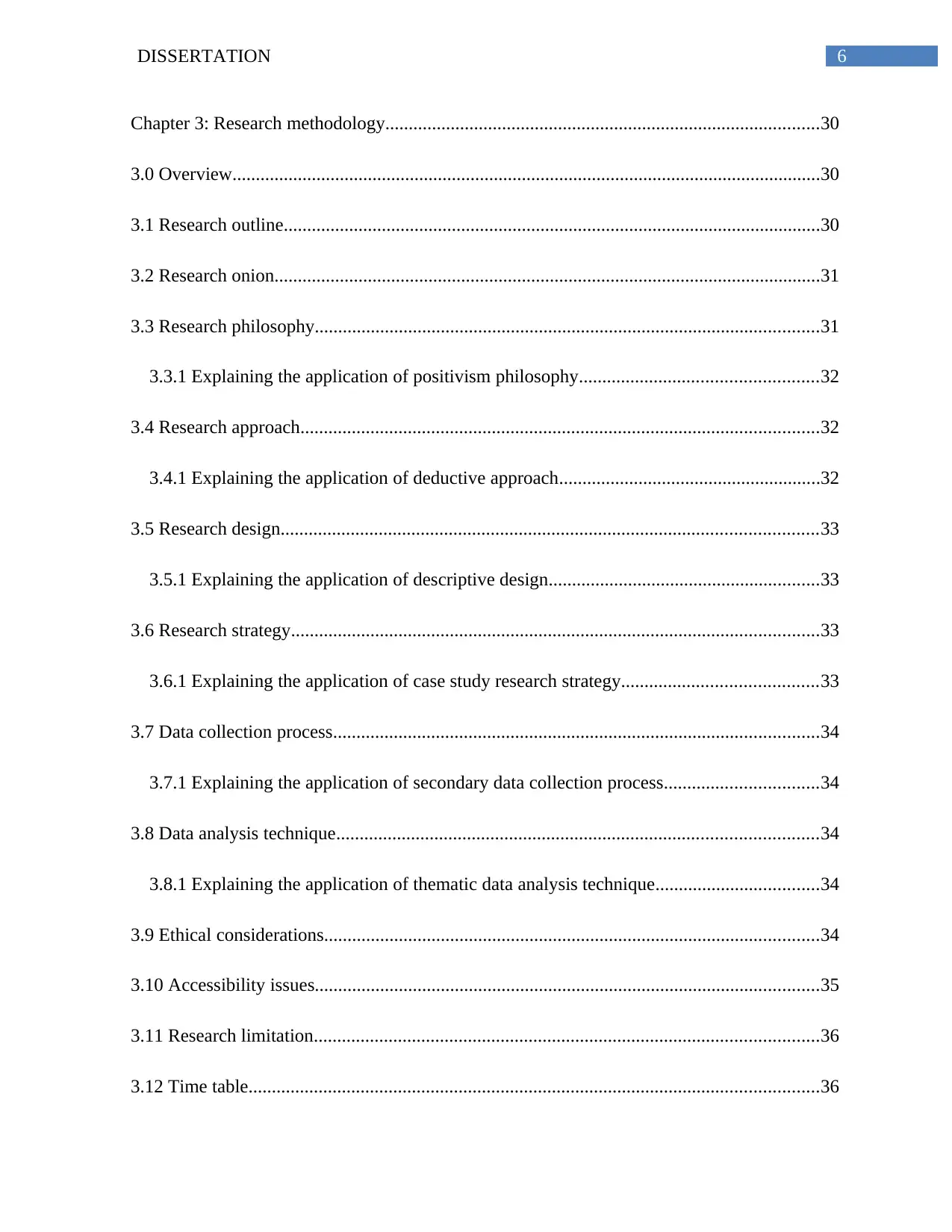
6DISSERTATION
Chapter 3: Research methodology.............................................................................................30
3.0 Overview..............................................................................................................................30
3.1 Research outline...................................................................................................................30
3.2 Research onion.....................................................................................................................31
3.3 Research philosophy............................................................................................................31
3.3.1 Explaining the application of positivism philosophy...................................................32
3.4 Research approach...............................................................................................................32
3.4.1 Explaining the application of deductive approach........................................................32
3.5 Research design...................................................................................................................33
3.5.1 Explaining the application of descriptive design..........................................................33
3.6 Research strategy.................................................................................................................33
3.6.1 Explaining the application of case study research strategy..........................................33
3.7 Data collection process........................................................................................................34
3.7.1 Explaining the application of secondary data collection process.................................34
3.8 Data analysis technique.......................................................................................................34
3.8.1 Explaining the application of thematic data analysis technique...................................34
3.9 Ethical considerations..........................................................................................................34
3.10 Accessibility issues............................................................................................................35
3.11 Research limitation............................................................................................................36
3.12 Time table..........................................................................................................................36
Chapter 3: Research methodology.............................................................................................30
3.0 Overview..............................................................................................................................30
3.1 Research outline...................................................................................................................30
3.2 Research onion.....................................................................................................................31
3.3 Research philosophy............................................................................................................31
3.3.1 Explaining the application of positivism philosophy...................................................32
3.4 Research approach...............................................................................................................32
3.4.1 Explaining the application of deductive approach........................................................32
3.5 Research design...................................................................................................................33
3.5.1 Explaining the application of descriptive design..........................................................33
3.6 Research strategy.................................................................................................................33
3.6.1 Explaining the application of case study research strategy..........................................33
3.7 Data collection process........................................................................................................34
3.7.1 Explaining the application of secondary data collection process.................................34
3.8 Data analysis technique.......................................................................................................34
3.8.1 Explaining the application of thematic data analysis technique...................................34
3.9 Ethical considerations..........................................................................................................34
3.10 Accessibility issues............................................................................................................35
3.11 Research limitation............................................................................................................36
3.12 Time table..........................................................................................................................36
Paraphrase This Document
Need a fresh take? Get an instant paraphrase of this document with our AI Paraphraser

7DISSERTATION
3.13 Summary............................................................................................................................37
Chapter 4: Data analysis................................................................................................................38
4.0 Overview..............................................................................................................................38
4.1 Thematic analysis................................................................................................................38
4.2 Summary..............................................................................................................................46
Chapter 5: Discussions..................................................................................................................48
5.0 Overview..............................................................................................................................48
5.1 Findings and interpretation..................................................................................................48
5.2 Summary..............................................................................................................................51
Chapter 6: Conclusion and recommendations...............................................................................53
6.0 Conclusion...........................................................................................................................53
6.1 Linking to objectives...........................................................................................................53
6.2 Recommendations................................................................................................................55
6.3 Future scope of the study.....................................................................................................55
References......................................................................................................................................57
3.13 Summary............................................................................................................................37
Chapter 4: Data analysis................................................................................................................38
4.0 Overview..............................................................................................................................38
4.1 Thematic analysis................................................................................................................38
4.2 Summary..............................................................................................................................46
Chapter 5: Discussions..................................................................................................................48
5.0 Overview..............................................................................................................................48
5.1 Findings and interpretation..................................................................................................48
5.2 Summary..............................................................................................................................51
Chapter 6: Conclusion and recommendations...............................................................................53
6.0 Conclusion...........................................................................................................................53
6.1 Linking to objectives...........................................................................................................53
6.2 Recommendations................................................................................................................55
6.3 Future scope of the study.....................................................................................................55
References......................................................................................................................................57
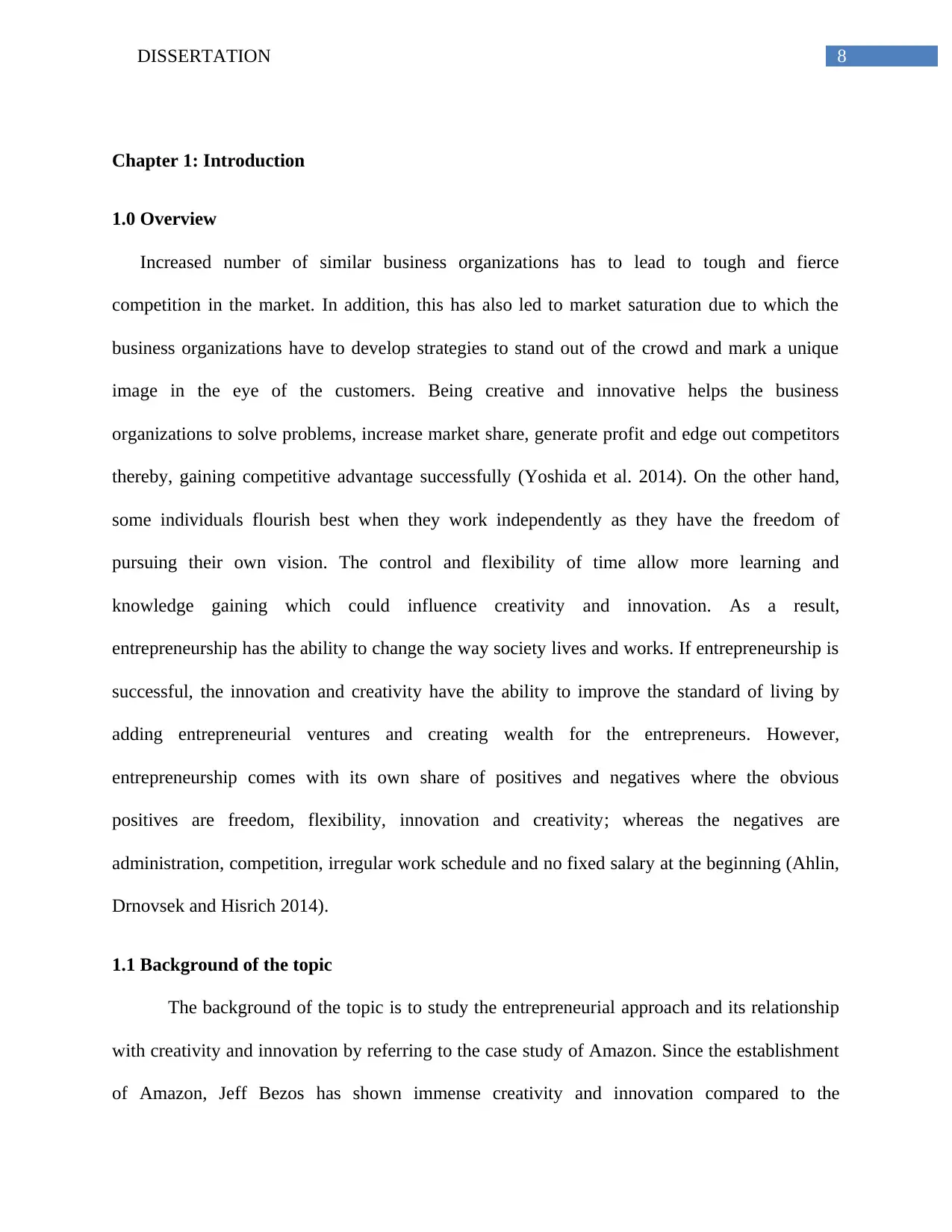
8DISSERTATION
Chapter 1: Introduction
1.0 Overview
Increased number of similar business organizations has to lead to tough and fierce
competition in the market. In addition, this has also led to market saturation due to which the
business organizations have to develop strategies to stand out of the crowd and mark a unique
image in the eye of the customers. Being creative and innovative helps the business
organizations to solve problems, increase market share, generate profit and edge out competitors
thereby, gaining competitive advantage successfully (Yoshida et al. 2014). On the other hand,
some individuals flourish best when they work independently as they have the freedom of
pursuing their own vision. The control and flexibility of time allow more learning and
knowledge gaining which could influence creativity and innovation. As a result,
entrepreneurship has the ability to change the way society lives and works. If entrepreneurship is
successful, the innovation and creativity have the ability to improve the standard of living by
adding entrepreneurial ventures and creating wealth for the entrepreneurs. However,
entrepreneurship comes with its own share of positives and negatives where the obvious
positives are freedom, flexibility, innovation and creativity; whereas the negatives are
administration, competition, irregular work schedule and no fixed salary at the beginning (Ahlin,
Drnovsek and Hisrich 2014).
1.1 Background of the topic
The background of the topic is to study the entrepreneurial approach and its relationship
with creativity and innovation by referring to the case study of Amazon. Since the establishment
of Amazon, Jeff Bezos has shown immense creativity and innovation compared to the
Chapter 1: Introduction
1.0 Overview
Increased number of similar business organizations has to lead to tough and fierce
competition in the market. In addition, this has also led to market saturation due to which the
business organizations have to develop strategies to stand out of the crowd and mark a unique
image in the eye of the customers. Being creative and innovative helps the business
organizations to solve problems, increase market share, generate profit and edge out competitors
thereby, gaining competitive advantage successfully (Yoshida et al. 2014). On the other hand,
some individuals flourish best when they work independently as they have the freedom of
pursuing their own vision. The control and flexibility of time allow more learning and
knowledge gaining which could influence creativity and innovation. As a result,
entrepreneurship has the ability to change the way society lives and works. If entrepreneurship is
successful, the innovation and creativity have the ability to improve the standard of living by
adding entrepreneurial ventures and creating wealth for the entrepreneurs. However,
entrepreneurship comes with its own share of positives and negatives where the obvious
positives are freedom, flexibility, innovation and creativity; whereas the negatives are
administration, competition, irregular work schedule and no fixed salary at the beginning (Ahlin,
Drnovsek and Hisrich 2014).
1.1 Background of the topic
The background of the topic is to study the entrepreneurial approach and its relationship
with creativity and innovation by referring to the case study of Amazon. Since the establishment
of Amazon, Jeff Bezos has shown immense creativity and innovation compared to the
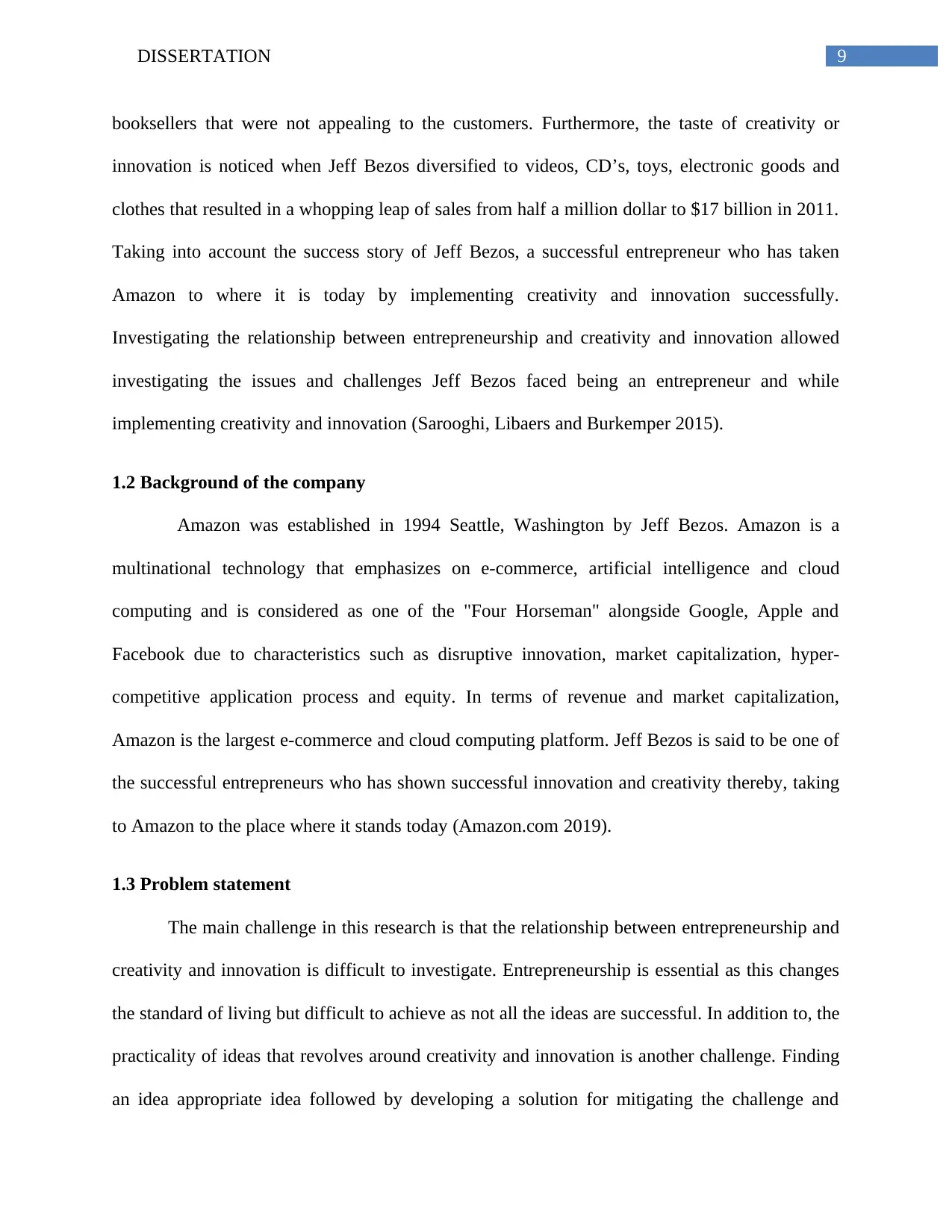
9DISSERTATION
booksellers that were not appealing to the customers. Furthermore, the taste of creativity or
innovation is noticed when Jeff Bezos diversified to videos, CD’s, toys, electronic goods and
clothes that resulted in a whopping leap of sales from half a million dollar to $17 billion in 2011.
Taking into account the success story of Jeff Bezos, a successful entrepreneur who has taken
Amazon to where it is today by implementing creativity and innovation successfully.
Investigating the relationship between entrepreneurship and creativity and innovation allowed
investigating the issues and challenges Jeff Bezos faced being an entrepreneur and while
implementing creativity and innovation (Sarooghi, Libaers and Burkemper 2015).
1.2 Background of the company
Amazon was established in 1994 Seattle, Washington by Jeff Bezos. Amazon is a
multinational technology that emphasizes on e-commerce, artificial intelligence and cloud
computing and is considered as one of the "Four Horseman" alongside Google, Apple and
Facebook due to characteristics such as disruptive innovation, market capitalization, hyper-
competitive application process and equity. In terms of revenue and market capitalization,
Amazon is the largest e-commerce and cloud computing platform. Jeff Bezos is said to be one of
the successful entrepreneurs who has shown successful innovation and creativity thereby, taking
to Amazon to the place where it stands today (Amazon.com 2019).
1.3 Problem statement
The main challenge in this research is that the relationship between entrepreneurship and
creativity and innovation is difficult to investigate. Entrepreneurship is essential as this changes
the standard of living but difficult to achieve as not all the ideas are successful. In addition to, the
practicality of ideas that revolves around creativity and innovation is another challenge. Finding
an idea appropriate idea followed by developing a solution for mitigating the challenge and
booksellers that were not appealing to the customers. Furthermore, the taste of creativity or
innovation is noticed when Jeff Bezos diversified to videos, CD’s, toys, electronic goods and
clothes that resulted in a whopping leap of sales from half a million dollar to $17 billion in 2011.
Taking into account the success story of Jeff Bezos, a successful entrepreneur who has taken
Amazon to where it is today by implementing creativity and innovation successfully.
Investigating the relationship between entrepreneurship and creativity and innovation allowed
investigating the issues and challenges Jeff Bezos faced being an entrepreneur and while
implementing creativity and innovation (Sarooghi, Libaers and Burkemper 2015).
1.2 Background of the company
Amazon was established in 1994 Seattle, Washington by Jeff Bezos. Amazon is a
multinational technology that emphasizes on e-commerce, artificial intelligence and cloud
computing and is considered as one of the "Four Horseman" alongside Google, Apple and
Facebook due to characteristics such as disruptive innovation, market capitalization, hyper-
competitive application process and equity. In terms of revenue and market capitalization,
Amazon is the largest e-commerce and cloud computing platform. Jeff Bezos is said to be one of
the successful entrepreneurs who has shown successful innovation and creativity thereby, taking
to Amazon to the place where it stands today (Amazon.com 2019).
1.3 Problem statement
The main challenge in this research is that the relationship between entrepreneurship and
creativity and innovation is difficult to investigate. Entrepreneurship is essential as this changes
the standard of living but difficult to achieve as not all the ideas are successful. In addition to, the
practicality of ideas that revolves around creativity and innovation is another challenge. Finding
an idea appropriate idea followed by developing a solution for mitigating the challenge and
Secure Best Marks with AI Grader
Need help grading? Try our AI Grader for instant feedback on your assignments.
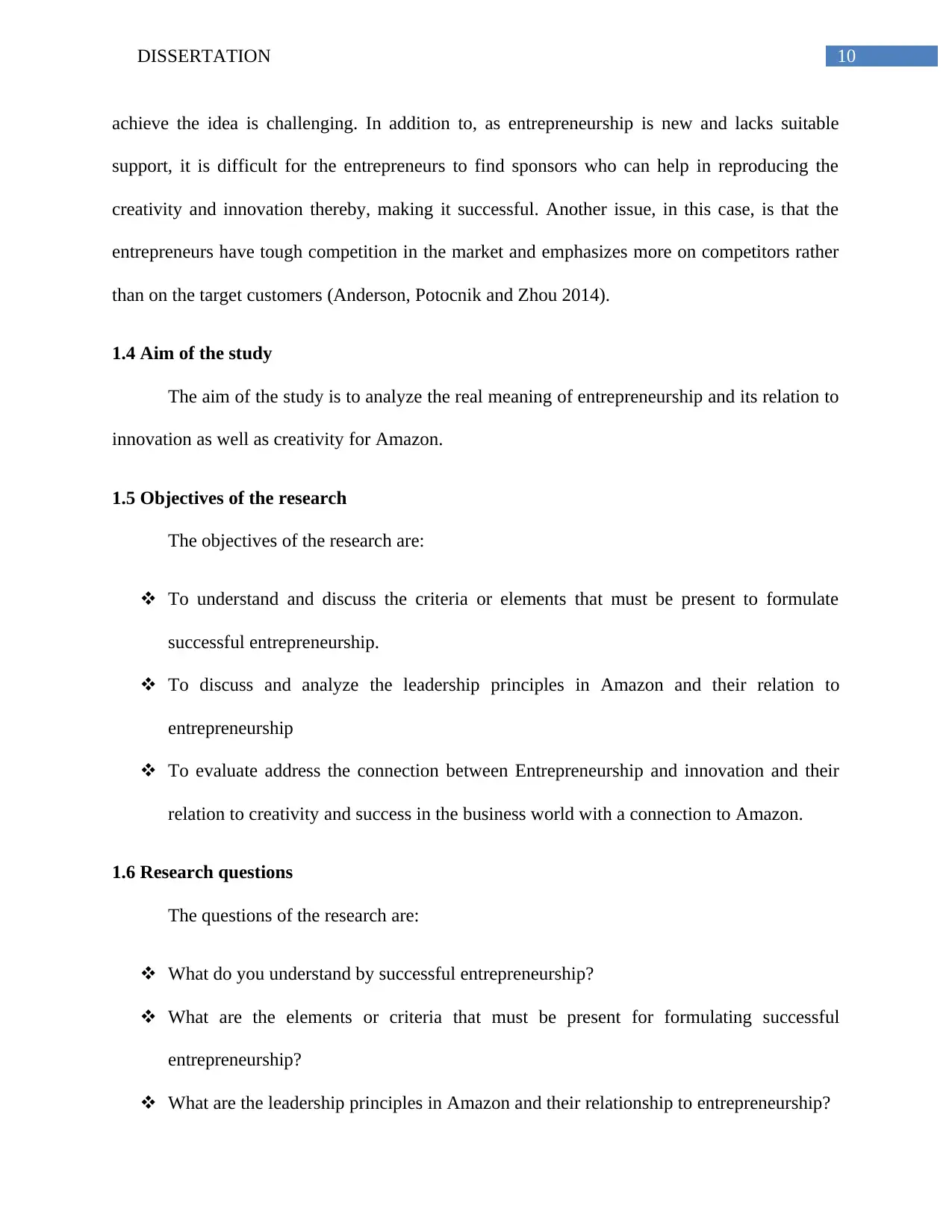
10DISSERTATION
achieve the idea is challenging. In addition to, as entrepreneurship is new and lacks suitable
support, it is difficult for the entrepreneurs to find sponsors who can help in reproducing the
creativity and innovation thereby, making it successful. Another issue, in this case, is that the
entrepreneurs have tough competition in the market and emphasizes more on competitors rather
than on the target customers (Anderson, Potocnik and Zhou 2014).
1.4 Aim of the study
The aim of the study is to analyze the real meaning of entrepreneurship and its relation to
innovation as well as creativity for Amazon.
1.5 Objectives of the research
The objectives of the research are:
To understand and discuss the criteria or elements that must be present to formulate
successful entrepreneurship.
To discuss and analyze the leadership principles in Amazon and their relation to
entrepreneurship
To evaluate address the connection between Entrepreneurship and innovation and their
relation to creativity and success in the business world with a connection to Amazon.
1.6 Research questions
The questions of the research are:
What do you understand by successful entrepreneurship?
What are the elements or criteria that must be present for formulating successful
entrepreneurship?
What are the leadership principles in Amazon and their relationship to entrepreneurship?
achieve the idea is challenging. In addition to, as entrepreneurship is new and lacks suitable
support, it is difficult for the entrepreneurs to find sponsors who can help in reproducing the
creativity and innovation thereby, making it successful. Another issue, in this case, is that the
entrepreneurs have tough competition in the market and emphasizes more on competitors rather
than on the target customers (Anderson, Potocnik and Zhou 2014).
1.4 Aim of the study
The aim of the study is to analyze the real meaning of entrepreneurship and its relation to
innovation as well as creativity for Amazon.
1.5 Objectives of the research
The objectives of the research are:
To understand and discuss the criteria or elements that must be present to formulate
successful entrepreneurship.
To discuss and analyze the leadership principles in Amazon and their relation to
entrepreneurship
To evaluate address the connection between Entrepreneurship and innovation and their
relation to creativity and success in the business world with a connection to Amazon.
1.6 Research questions
The questions of the research are:
What do you understand by successful entrepreneurship?
What are the elements or criteria that must be present for formulating successful
entrepreneurship?
What are the leadership principles in Amazon and their relationship to entrepreneurship?
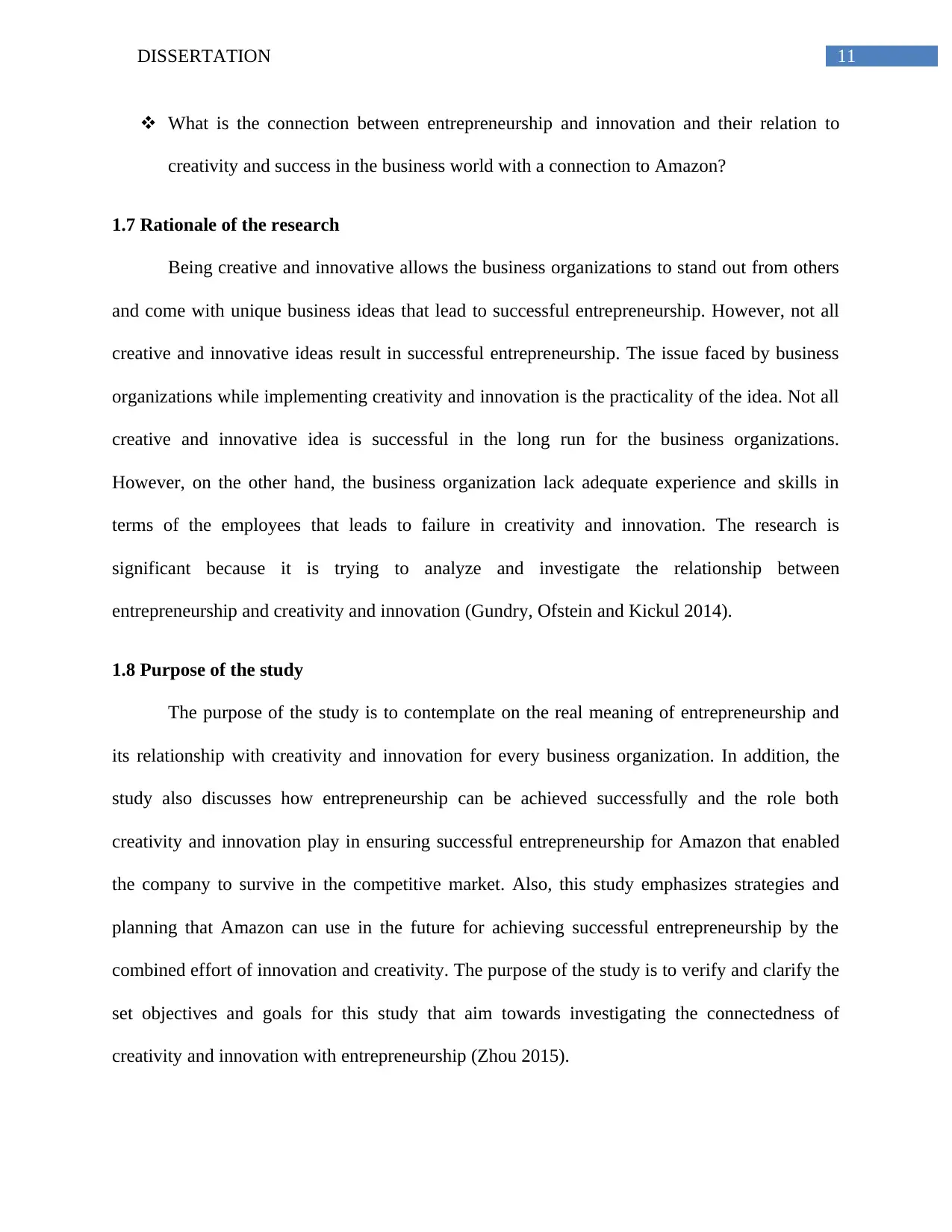
11DISSERTATION
What is the connection between entrepreneurship and innovation and their relation to
creativity and success in the business world with a connection to Amazon?
1.7 Rationale of the research
Being creative and innovative allows the business organizations to stand out from others
and come with unique business ideas that lead to successful entrepreneurship. However, not all
creative and innovative ideas result in successful entrepreneurship. The issue faced by business
organizations while implementing creativity and innovation is the practicality of the idea. Not all
creative and innovative idea is successful in the long run for the business organizations.
However, on the other hand, the business organization lack adequate experience and skills in
terms of the employees that leads to failure in creativity and innovation. The research is
significant because it is trying to analyze and investigate the relationship between
entrepreneurship and creativity and innovation (Gundry, Ofstein and Kickul 2014).
1.8 Purpose of the study
The purpose of the study is to contemplate on the real meaning of entrepreneurship and
its relationship with creativity and innovation for every business organization. In addition, the
study also discusses how entrepreneurship can be achieved successfully and the role both
creativity and innovation play in ensuring successful entrepreneurship for Amazon that enabled
the company to survive in the competitive market. Also, this study emphasizes strategies and
planning that Amazon can use in the future for achieving successful entrepreneurship by the
combined effort of innovation and creativity. The purpose of the study is to verify and clarify the
set objectives and goals for this study that aim towards investigating the connectedness of
creativity and innovation with entrepreneurship (Zhou 2015).
What is the connection between entrepreneurship and innovation and their relation to
creativity and success in the business world with a connection to Amazon?
1.7 Rationale of the research
Being creative and innovative allows the business organizations to stand out from others
and come with unique business ideas that lead to successful entrepreneurship. However, not all
creative and innovative ideas result in successful entrepreneurship. The issue faced by business
organizations while implementing creativity and innovation is the practicality of the idea. Not all
creative and innovative idea is successful in the long run for the business organizations.
However, on the other hand, the business organization lack adequate experience and skills in
terms of the employees that leads to failure in creativity and innovation. The research is
significant because it is trying to analyze and investigate the relationship between
entrepreneurship and creativity and innovation (Gundry, Ofstein and Kickul 2014).
1.8 Purpose of the study
The purpose of the study is to contemplate on the real meaning of entrepreneurship and
its relationship with creativity and innovation for every business organization. In addition, the
study also discusses how entrepreneurship can be achieved successfully and the role both
creativity and innovation play in ensuring successful entrepreneurship for Amazon that enabled
the company to survive in the competitive market. Also, this study emphasizes strategies and
planning that Amazon can use in the future for achieving successful entrepreneurship by the
combined effort of innovation and creativity. The purpose of the study is to verify and clarify the
set objectives and goals for this study that aim towards investigating the connectedness of
creativity and innovation with entrepreneurship (Zhou 2015).
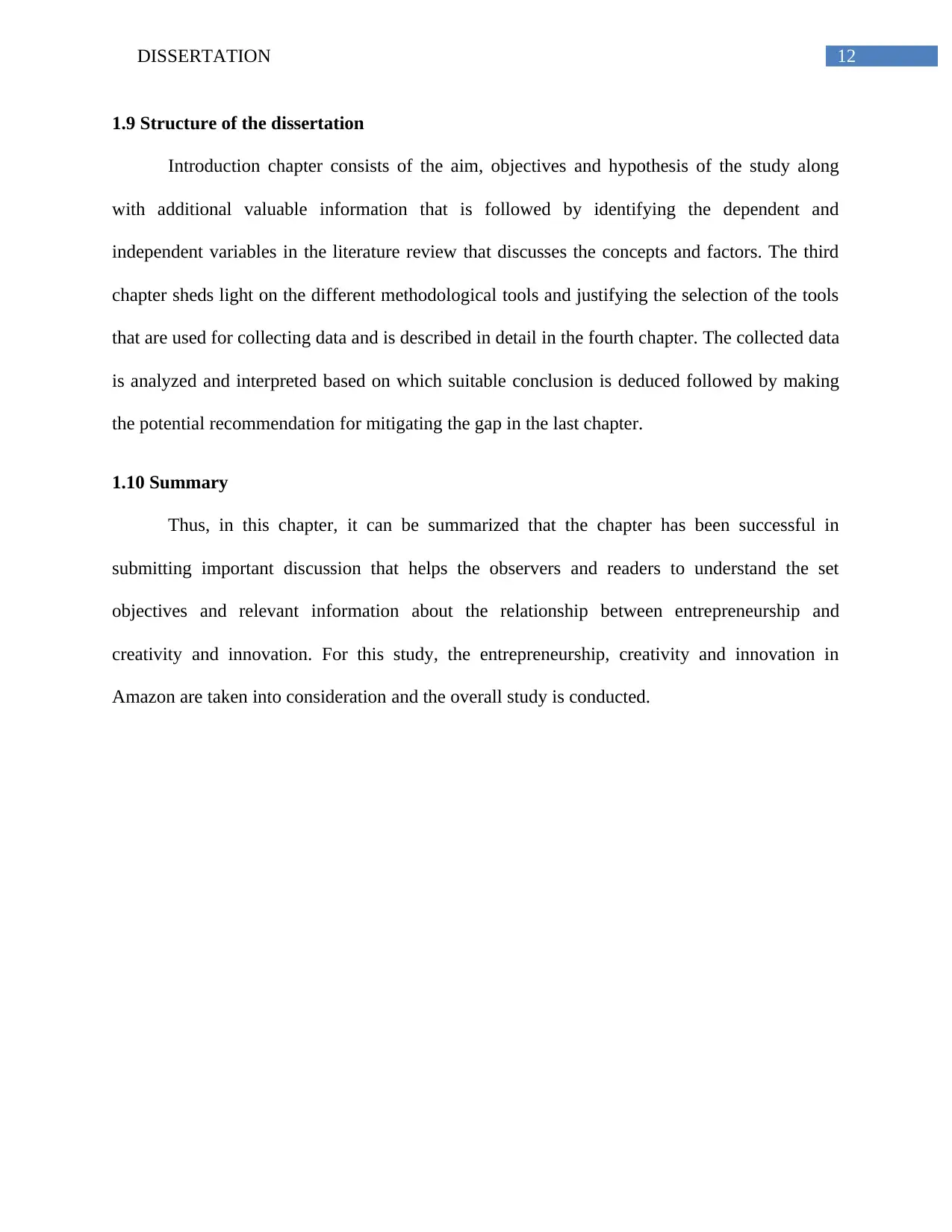
12DISSERTATION
1.9 Structure of the dissertation
Introduction chapter consists of the aim, objectives and hypothesis of the study along
with additional valuable information that is followed by identifying the dependent and
independent variables in the literature review that discusses the concepts and factors. The third
chapter sheds light on the different methodological tools and justifying the selection of the tools
that are used for collecting data and is described in detail in the fourth chapter. The collected data
is analyzed and interpreted based on which suitable conclusion is deduced followed by making
the potential recommendation for mitigating the gap in the last chapter.
1.10 Summary
Thus, in this chapter, it can be summarized that the chapter has been successful in
submitting important discussion that helps the observers and readers to understand the set
objectives and relevant information about the relationship between entrepreneurship and
creativity and innovation. For this study, the entrepreneurship, creativity and innovation in
Amazon are taken into consideration and the overall study is conducted.
1.9 Structure of the dissertation
Introduction chapter consists of the aim, objectives and hypothesis of the study along
with additional valuable information that is followed by identifying the dependent and
independent variables in the literature review that discusses the concepts and factors. The third
chapter sheds light on the different methodological tools and justifying the selection of the tools
that are used for collecting data and is described in detail in the fourth chapter. The collected data
is analyzed and interpreted based on which suitable conclusion is deduced followed by making
the potential recommendation for mitigating the gap in the last chapter.
1.10 Summary
Thus, in this chapter, it can be summarized that the chapter has been successful in
submitting important discussion that helps the observers and readers to understand the set
objectives and relevant information about the relationship between entrepreneurship and
creativity and innovation. For this study, the entrepreneurship, creativity and innovation in
Amazon are taken into consideration and the overall study is conducted.
Paraphrase This Document
Need a fresh take? Get an instant paraphrase of this document with our AI Paraphraser
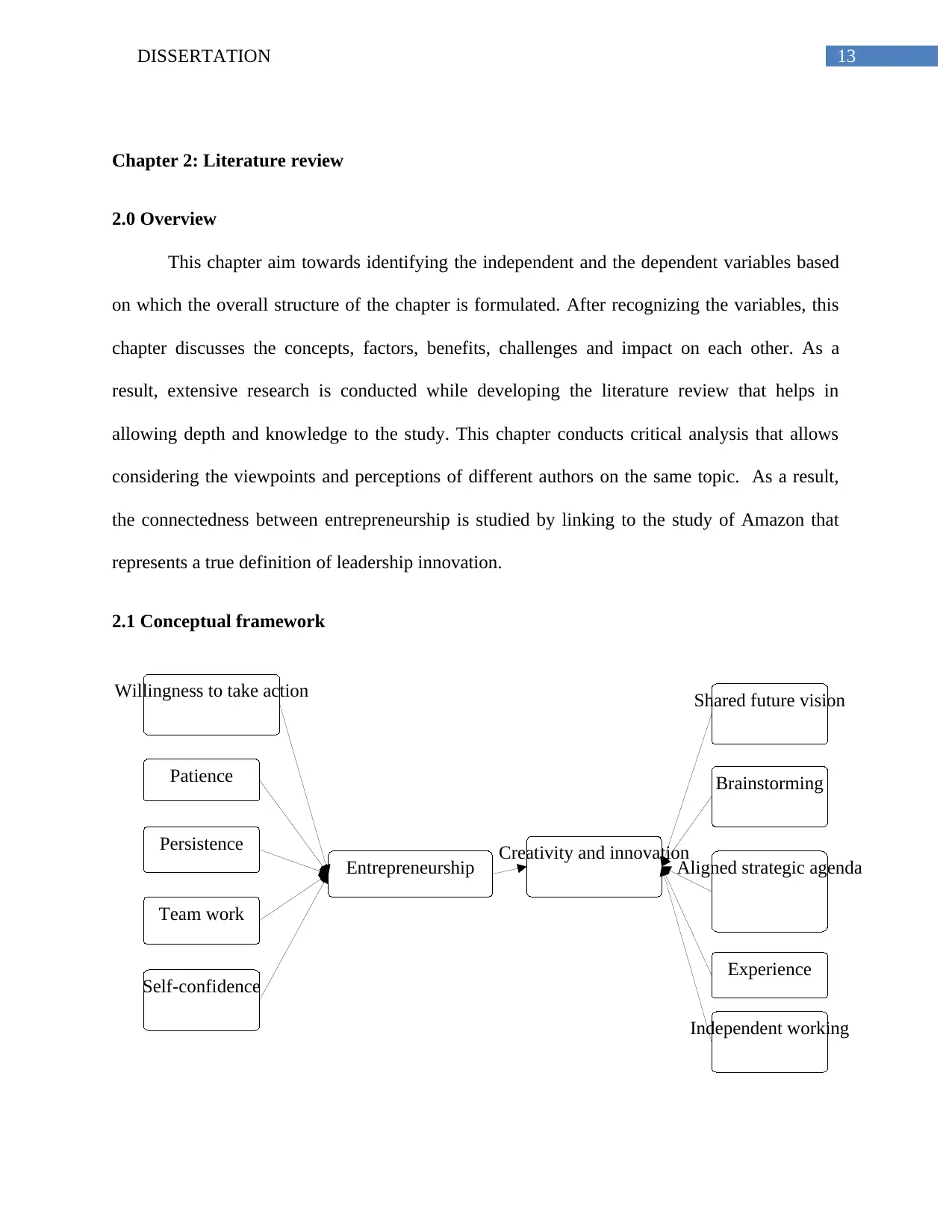
13DISSERTATION
Entrepreneurship Creativity and innovation
Willingness to take action
Patience
Persistence
Team work
Self-confidence
Shared future vision
Brainstorming
Aligned strategic agenda
Experience
Independent working
Chapter 2: Literature review
2.0 Overview
This chapter aim towards identifying the independent and the dependent variables based
on which the overall structure of the chapter is formulated. After recognizing the variables, this
chapter discusses the concepts, factors, benefits, challenges and impact on each other. As a
result, extensive research is conducted while developing the literature review that helps in
allowing depth and knowledge to the study. This chapter conducts critical analysis that allows
considering the viewpoints and perceptions of different authors on the same topic. As a result,
the connectedness between entrepreneurship is studied by linking to the study of Amazon that
represents a true definition of leadership innovation.
2.1 Conceptual framework
Entrepreneurship Creativity and innovation
Willingness to take action
Patience
Persistence
Team work
Self-confidence
Shared future vision
Brainstorming
Aligned strategic agenda
Experience
Independent working
Chapter 2: Literature review
2.0 Overview
This chapter aim towards identifying the independent and the dependent variables based
on which the overall structure of the chapter is formulated. After recognizing the variables, this
chapter discusses the concepts, factors, benefits, challenges and impact on each other. As a
result, extensive research is conducted while developing the literature review that helps in
allowing depth and knowledge to the study. This chapter conducts critical analysis that allows
considering the viewpoints and perceptions of different authors on the same topic. As a result,
the connectedness between entrepreneurship is studied by linking to the study of Amazon that
represents a true definition of leadership innovation.
2.1 Conceptual framework
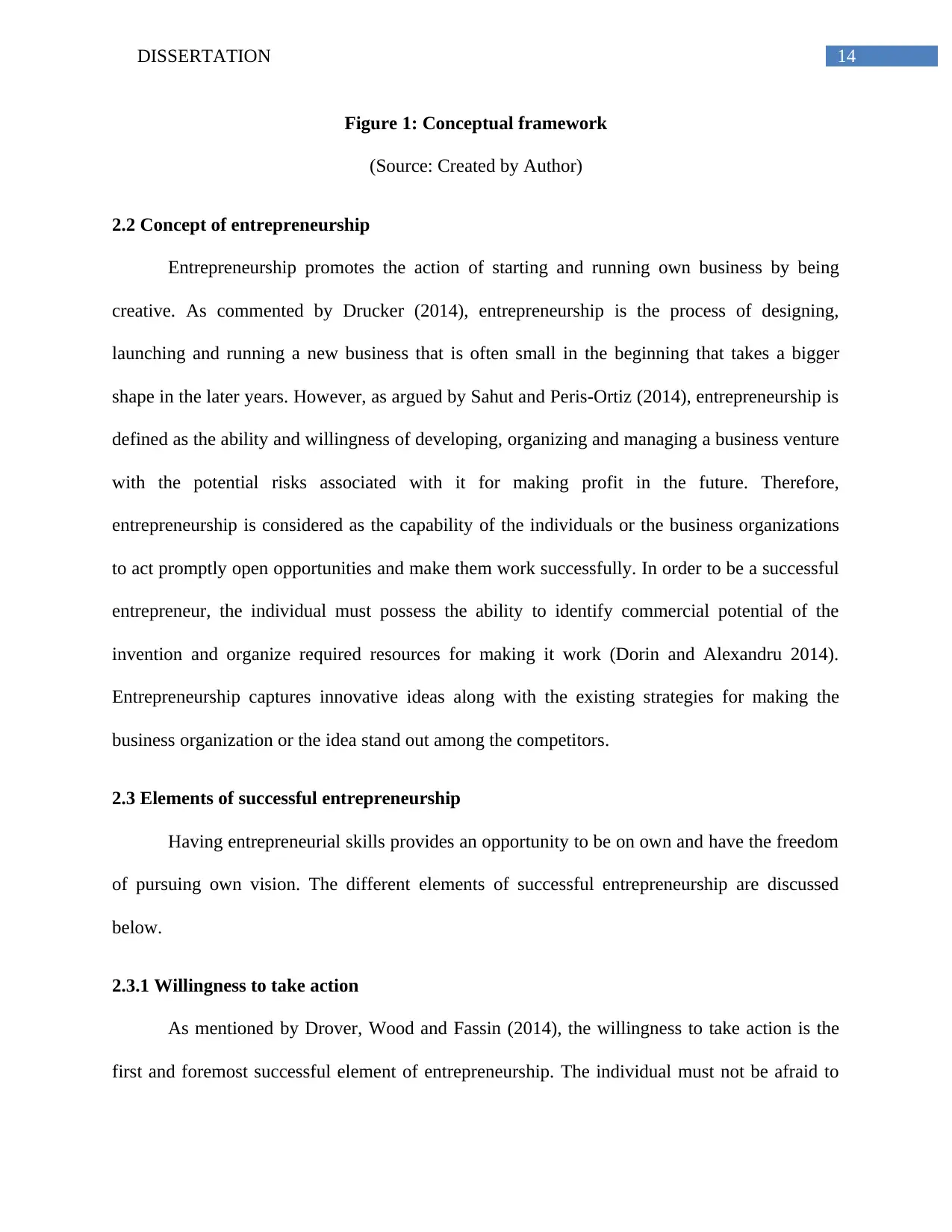
14DISSERTATION
Figure 1: Conceptual framework
(Source: Created by Author)
2.2 Concept of entrepreneurship
Entrepreneurship promotes the action of starting and running own business by being
creative. As commented by Drucker (2014), entrepreneurship is the process of designing,
launching and running a new business that is often small in the beginning that takes a bigger
shape in the later years. However, as argued by Sahut and Peris-Ortiz (2014), entrepreneurship is
defined as the ability and willingness of developing, organizing and managing a business venture
with the potential risks associated with it for making profit in the future. Therefore,
entrepreneurship is considered as the capability of the individuals or the business organizations
to act promptly open opportunities and make them work successfully. In order to be a successful
entrepreneur, the individual must possess the ability to identify commercial potential of the
invention and organize required resources for making it work (Dorin and Alexandru 2014).
Entrepreneurship captures innovative ideas along with the existing strategies for making the
business organization or the idea stand out among the competitors.
2.3 Elements of successful entrepreneurship
Having entrepreneurial skills provides an opportunity to be on own and have the freedom
of pursuing own vision. The different elements of successful entrepreneurship are discussed
below.
2.3.1 Willingness to take action
As mentioned by Drover, Wood and Fassin (2014), the willingness to take action is the
first and foremost successful element of entrepreneurship. The individual must not be afraid to
Figure 1: Conceptual framework
(Source: Created by Author)
2.2 Concept of entrepreneurship
Entrepreneurship promotes the action of starting and running own business by being
creative. As commented by Drucker (2014), entrepreneurship is the process of designing,
launching and running a new business that is often small in the beginning that takes a bigger
shape in the later years. However, as argued by Sahut and Peris-Ortiz (2014), entrepreneurship is
defined as the ability and willingness of developing, organizing and managing a business venture
with the potential risks associated with it for making profit in the future. Therefore,
entrepreneurship is considered as the capability of the individuals or the business organizations
to act promptly open opportunities and make them work successfully. In order to be a successful
entrepreneur, the individual must possess the ability to identify commercial potential of the
invention and organize required resources for making it work (Dorin and Alexandru 2014).
Entrepreneurship captures innovative ideas along with the existing strategies for making the
business organization or the idea stand out among the competitors.
2.3 Elements of successful entrepreneurship
Having entrepreneurial skills provides an opportunity to be on own and have the freedom
of pursuing own vision. The different elements of successful entrepreneurship are discussed
below.
2.3.1 Willingness to take action
As mentioned by Drover, Wood and Fassin (2014), the willingness to take action is the
first and foremost successful element of entrepreneurship. The individual must not be afraid to
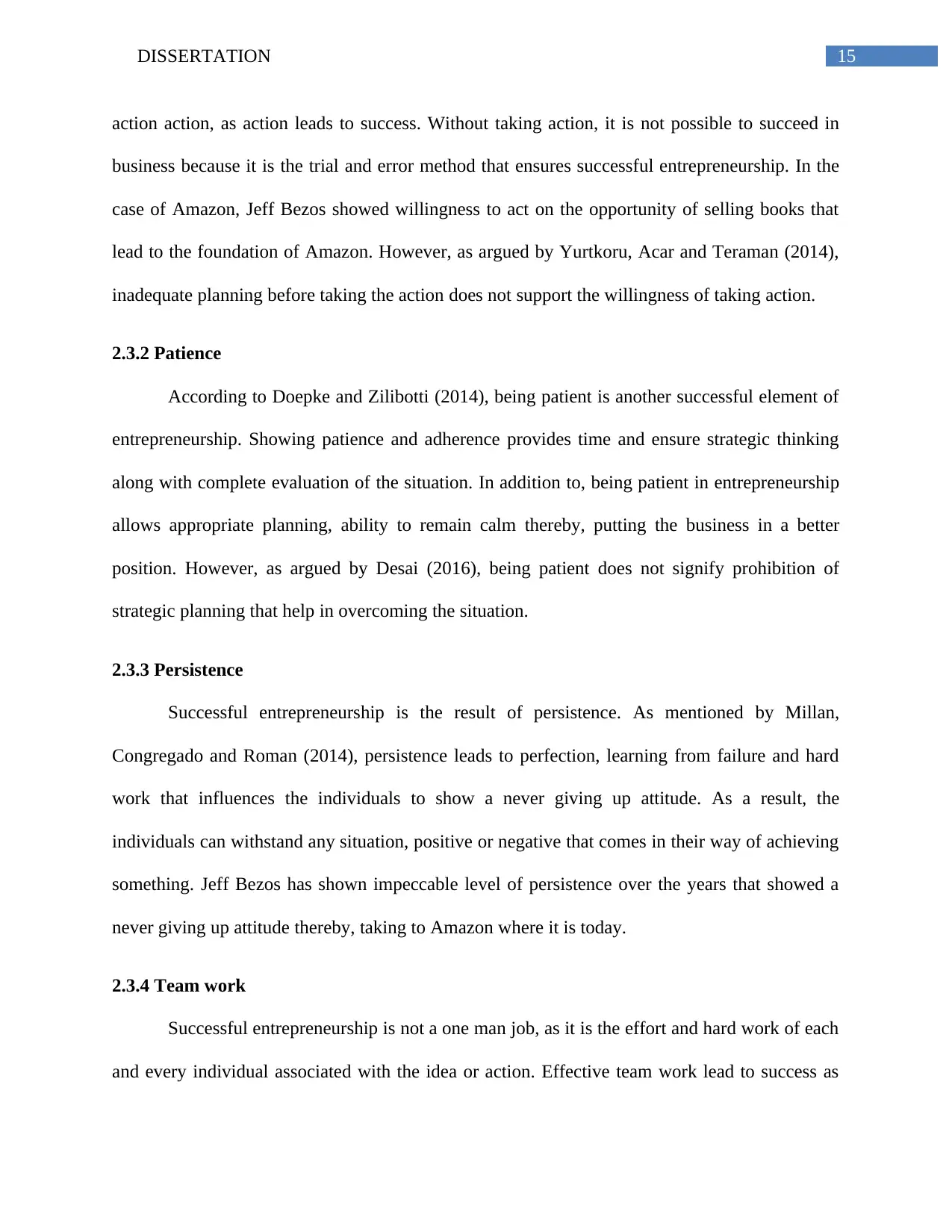
15DISSERTATION
action action, as action leads to success. Without taking action, it is not possible to succeed in
business because it is the trial and error method that ensures successful entrepreneurship. In the
case of Amazon, Jeff Bezos showed willingness to act on the opportunity of selling books that
lead to the foundation of Amazon. However, as argued by Yurtkoru, Acar and Teraman (2014),
inadequate planning before taking the action does not support the willingness of taking action.
2.3.2 Patience
According to Doepke and Zilibotti (2014), being patient is another successful element of
entrepreneurship. Showing patience and adherence provides time and ensure strategic thinking
along with complete evaluation of the situation. In addition to, being patient in entrepreneurship
allows appropriate planning, ability to remain calm thereby, putting the business in a better
position. However, as argued by Desai (2016), being patient does not signify prohibition of
strategic planning that help in overcoming the situation.
2.3.3 Persistence
Successful entrepreneurship is the result of persistence. As mentioned by Millan,
Congregado and Roman (2014), persistence leads to perfection, learning from failure and hard
work that influences the individuals to show a never giving up attitude. As a result, the
individuals can withstand any situation, positive or negative that comes in their way of achieving
something. Jeff Bezos has shown impeccable level of persistence over the years that showed a
never giving up attitude thereby, taking to Amazon where it is today.
2.3.4 Team work
Successful entrepreneurship is not a one man job, as it is the effort and hard work of each
and every individual associated with the idea or action. Effective team work lead to success as
action action, as action leads to success. Without taking action, it is not possible to succeed in
business because it is the trial and error method that ensures successful entrepreneurship. In the
case of Amazon, Jeff Bezos showed willingness to act on the opportunity of selling books that
lead to the foundation of Amazon. However, as argued by Yurtkoru, Acar and Teraman (2014),
inadequate planning before taking the action does not support the willingness of taking action.
2.3.2 Patience
According to Doepke and Zilibotti (2014), being patient is another successful element of
entrepreneurship. Showing patience and adherence provides time and ensure strategic thinking
along with complete evaluation of the situation. In addition to, being patient in entrepreneurship
allows appropriate planning, ability to remain calm thereby, putting the business in a better
position. However, as argued by Desai (2016), being patient does not signify prohibition of
strategic planning that help in overcoming the situation.
2.3.3 Persistence
Successful entrepreneurship is the result of persistence. As mentioned by Millan,
Congregado and Roman (2014), persistence leads to perfection, learning from failure and hard
work that influences the individuals to show a never giving up attitude. As a result, the
individuals can withstand any situation, positive or negative that comes in their way of achieving
something. Jeff Bezos has shown impeccable level of persistence over the years that showed a
never giving up attitude thereby, taking to Amazon where it is today.
2.3.4 Team work
Successful entrepreneurship is not a one man job, as it is the effort and hard work of each
and every individual associated with the idea or action. Effective team work lead to success as
Secure Best Marks with AI Grader
Need help grading? Try our AI Grader for instant feedback on your assignments.
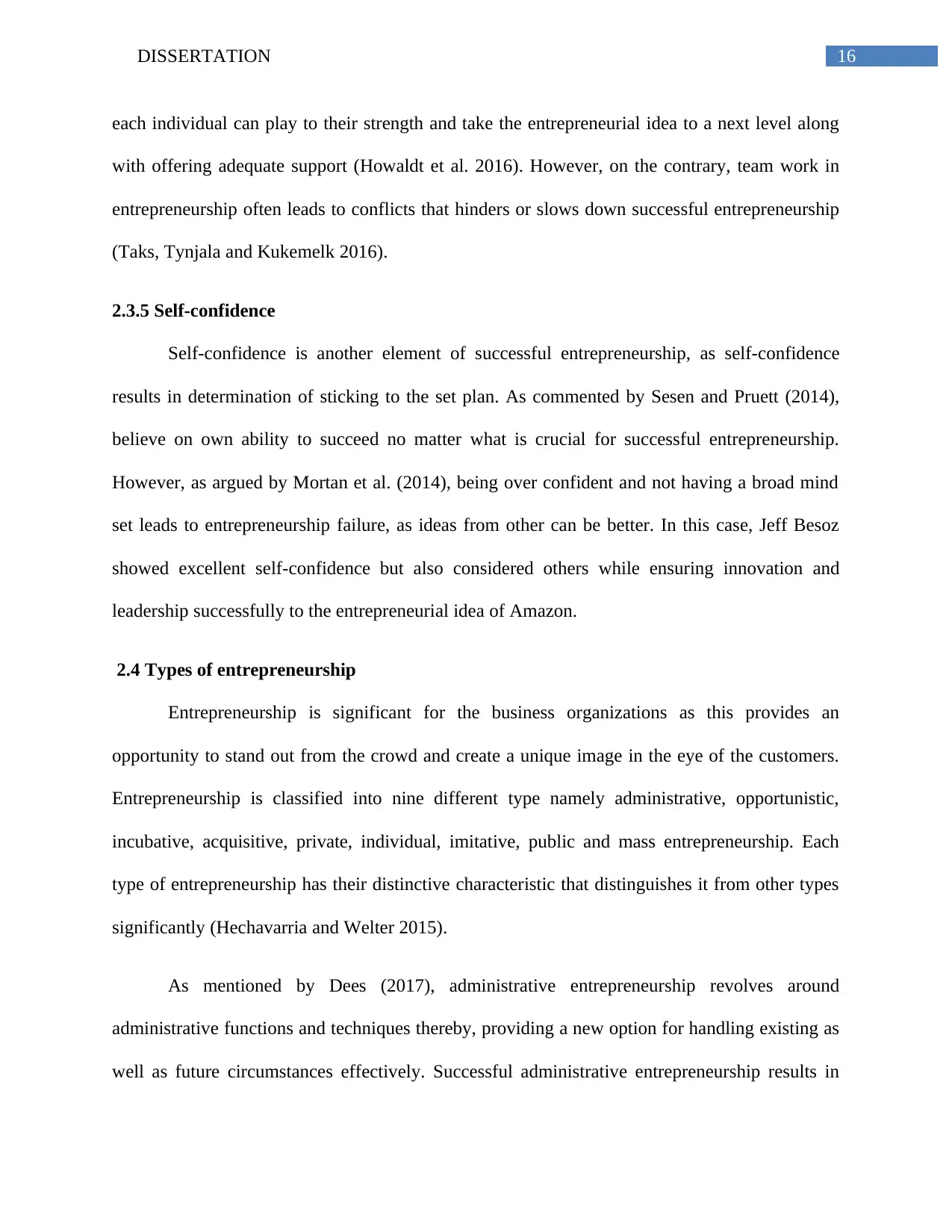
16DISSERTATION
each individual can play to their strength and take the entrepreneurial idea to a next level along
with offering adequate support (Howaldt et al. 2016). However, on the contrary, team work in
entrepreneurship often leads to conflicts that hinders or slows down successful entrepreneurship
(Taks, Tynjala and Kukemelk 2016).
2.3.5 Self-confidence
Self-confidence is another element of successful entrepreneurship, as self-confidence
results in determination of sticking to the set plan. As commented by Sesen and Pruett (2014),
believe on own ability to succeed no matter what is crucial for successful entrepreneurship.
However, as argued by Mortan et al. (2014), being over confident and not having a broad mind
set leads to entrepreneurship failure, as ideas from other can be better. In this case, Jeff Besoz
showed excellent self-confidence but also considered others while ensuring innovation and
leadership successfully to the entrepreneurial idea of Amazon.
2.4 Types of entrepreneurship
Entrepreneurship is significant for the business organizations as this provides an
opportunity to stand out from the crowd and create a unique image in the eye of the customers.
Entrepreneurship is classified into nine different type namely administrative, opportunistic,
incubative, acquisitive, private, individual, imitative, public and mass entrepreneurship. Each
type of entrepreneurship has their distinctive characteristic that distinguishes it from other types
significantly (Hechavarria and Welter 2015).
As mentioned by Dees (2017), administrative entrepreneurship revolves around
administrative functions and techniques thereby, providing a new option for handling existing as
well as future circumstances effectively. Successful administrative entrepreneurship results in
each individual can play to their strength and take the entrepreneurial idea to a next level along
with offering adequate support (Howaldt et al. 2016). However, on the contrary, team work in
entrepreneurship often leads to conflicts that hinders or slows down successful entrepreneurship
(Taks, Tynjala and Kukemelk 2016).
2.3.5 Self-confidence
Self-confidence is another element of successful entrepreneurship, as self-confidence
results in determination of sticking to the set plan. As commented by Sesen and Pruett (2014),
believe on own ability to succeed no matter what is crucial for successful entrepreneurship.
However, as argued by Mortan et al. (2014), being over confident and not having a broad mind
set leads to entrepreneurship failure, as ideas from other can be better. In this case, Jeff Besoz
showed excellent self-confidence but also considered others while ensuring innovation and
leadership successfully to the entrepreneurial idea of Amazon.
2.4 Types of entrepreneurship
Entrepreneurship is significant for the business organizations as this provides an
opportunity to stand out from the crowd and create a unique image in the eye of the customers.
Entrepreneurship is classified into nine different type namely administrative, opportunistic,
incubative, acquisitive, private, individual, imitative, public and mass entrepreneurship. Each
type of entrepreneurship has their distinctive characteristic that distinguishes it from other types
significantly (Hechavarria and Welter 2015).
As mentioned by Dees (2017), administrative entrepreneurship revolves around
administrative functions and techniques thereby, providing a new option for handling existing as
well as future circumstances effectively. Successful administrative entrepreneurship results in
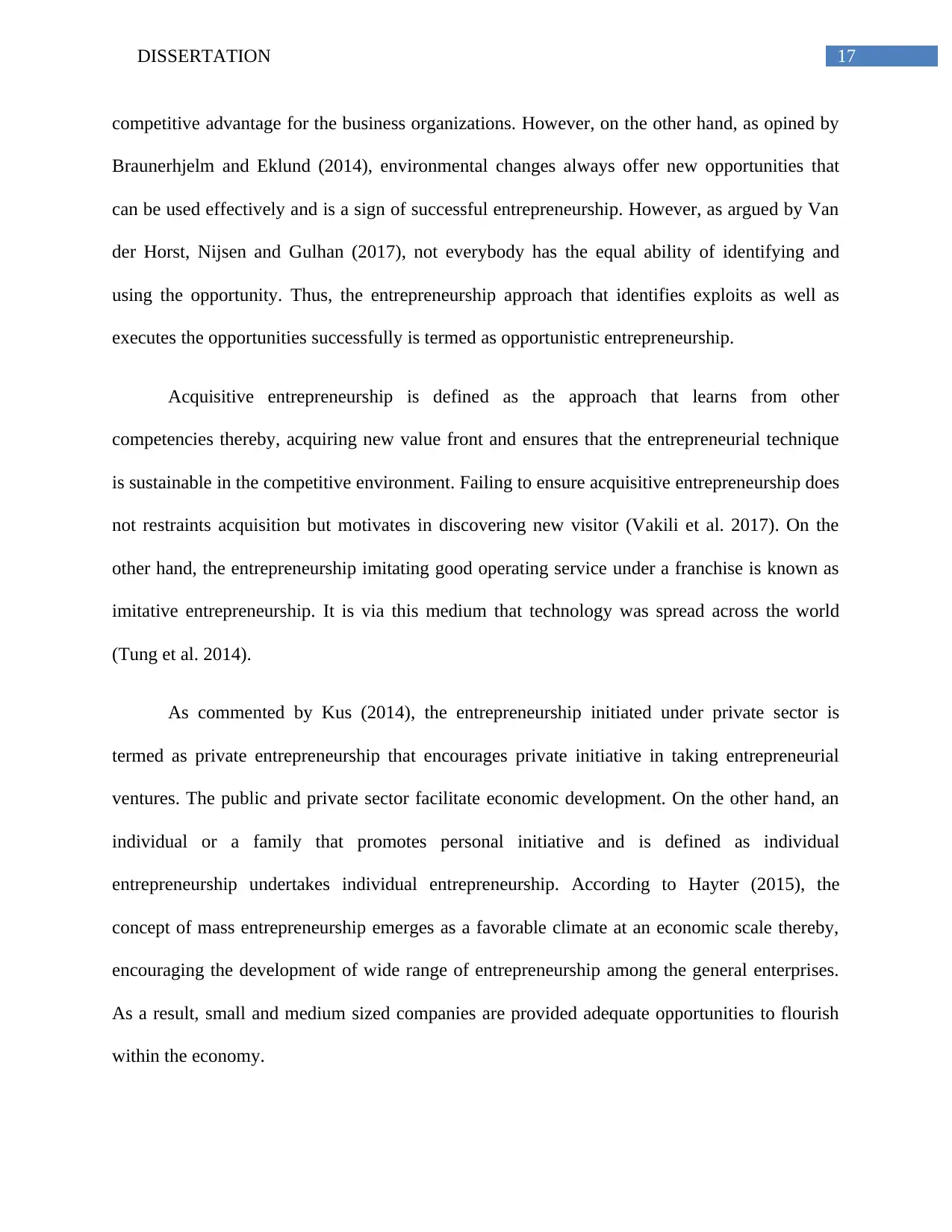
17DISSERTATION
competitive advantage for the business organizations. However, on the other hand, as opined by
Braunerhjelm and Eklund (2014), environmental changes always offer new opportunities that
can be used effectively and is a sign of successful entrepreneurship. However, as argued by Van
der Horst, Nijsen and Gulhan (2017), not everybody has the equal ability of identifying and
using the opportunity. Thus, the entrepreneurship approach that identifies exploits as well as
executes the opportunities successfully is termed as opportunistic entrepreneurship.
Acquisitive entrepreneurship is defined as the approach that learns from other
competencies thereby, acquiring new value front and ensures that the entrepreneurial technique
is sustainable in the competitive environment. Failing to ensure acquisitive entrepreneurship does
not restraints acquisition but motivates in discovering new visitor (Vakili et al. 2017). On the
other hand, the entrepreneurship imitating good operating service under a franchise is known as
imitative entrepreneurship. It is via this medium that technology was spread across the world
(Tung et al. 2014).
As commented by Kus (2014), the entrepreneurship initiated under private sector is
termed as private entrepreneurship that encourages private initiative in taking entrepreneurial
ventures. The public and private sector facilitate economic development. On the other hand, an
individual or a family that promotes personal initiative and is defined as individual
entrepreneurship undertakes individual entrepreneurship. According to Hayter (2015), the
concept of mass entrepreneurship emerges as a favorable climate at an economic scale thereby,
encouraging the development of wide range of entrepreneurship among the general enterprises.
As a result, small and medium sized companies are provided adequate opportunities to flourish
within the economy.
competitive advantage for the business organizations. However, on the other hand, as opined by
Braunerhjelm and Eklund (2014), environmental changes always offer new opportunities that
can be used effectively and is a sign of successful entrepreneurship. However, as argued by Van
der Horst, Nijsen and Gulhan (2017), not everybody has the equal ability of identifying and
using the opportunity. Thus, the entrepreneurship approach that identifies exploits as well as
executes the opportunities successfully is termed as opportunistic entrepreneurship.
Acquisitive entrepreneurship is defined as the approach that learns from other
competencies thereby, acquiring new value front and ensures that the entrepreneurial technique
is sustainable in the competitive environment. Failing to ensure acquisitive entrepreneurship does
not restraints acquisition but motivates in discovering new visitor (Vakili et al. 2017). On the
other hand, the entrepreneurship imitating good operating service under a franchise is known as
imitative entrepreneurship. It is via this medium that technology was spread across the world
(Tung et al. 2014).
As commented by Kus (2014), the entrepreneurship initiated under private sector is
termed as private entrepreneurship that encourages private initiative in taking entrepreneurial
ventures. The public and private sector facilitate economic development. On the other hand, an
individual or a family that promotes personal initiative and is defined as individual
entrepreneurship undertakes individual entrepreneurship. According to Hayter (2015), the
concept of mass entrepreneurship emerges as a favorable climate at an economic scale thereby,
encouraging the development of wide range of entrepreneurship among the general enterprises.
As a result, small and medium sized companies are provided adequate opportunities to flourish
within the economy.
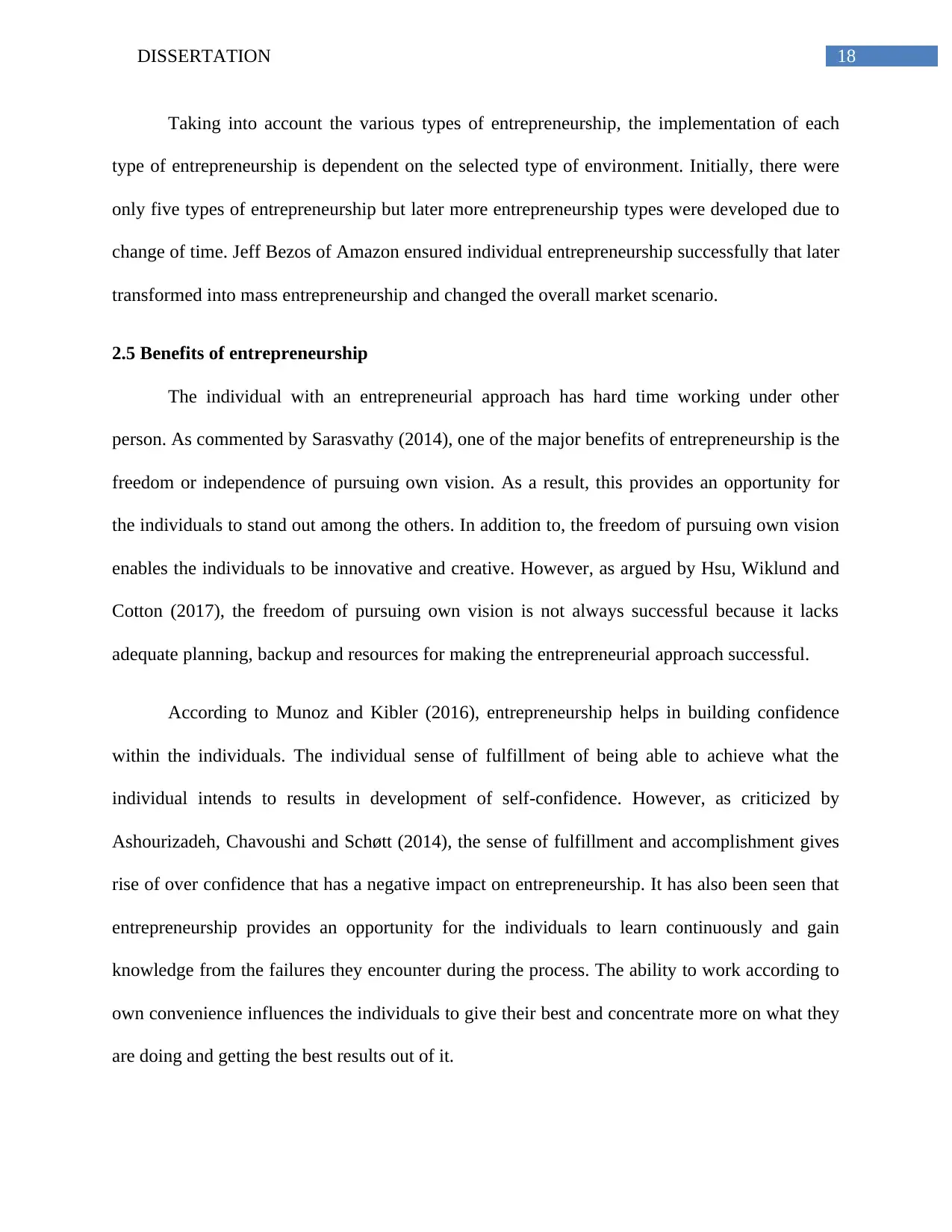
18DISSERTATION
Taking into account the various types of entrepreneurship, the implementation of each
type of entrepreneurship is dependent on the selected type of environment. Initially, there were
only five types of entrepreneurship but later more entrepreneurship types were developed due to
change of time. Jeff Bezos of Amazon ensured individual entrepreneurship successfully that later
transformed into mass entrepreneurship and changed the overall market scenario.
2.5 Benefits of entrepreneurship
The individual with an entrepreneurial approach has hard time working under other
person. As commented by Sarasvathy (2014), one of the major benefits of entrepreneurship is the
freedom or independence of pursuing own vision. As a result, this provides an opportunity for
the individuals to stand out among the others. In addition to, the freedom of pursuing own vision
enables the individuals to be innovative and creative. However, as argued by Hsu, Wiklund and
Cotton (2017), the freedom of pursuing own vision is not always successful because it lacks
adequate planning, backup and resources for making the entrepreneurial approach successful.
According to Munoz and Kibler (2016), entrepreneurship helps in building confidence
within the individuals. The individual sense of fulfillment of being able to achieve what the
individual intends to results in development of self-confidence. However, as criticized by
Ashourizadeh, Chavoushi and Schøtt (2014), the sense of fulfillment and accomplishment gives
rise of over confidence that has a negative impact on entrepreneurship. It has also been seen that
entrepreneurship provides an opportunity for the individuals to learn continuously and gain
knowledge from the failures they encounter during the process. The ability to work according to
own convenience influences the individuals to give their best and concentrate more on what they
are doing and getting the best results out of it.
Taking into account the various types of entrepreneurship, the implementation of each
type of entrepreneurship is dependent on the selected type of environment. Initially, there were
only five types of entrepreneurship but later more entrepreneurship types were developed due to
change of time. Jeff Bezos of Amazon ensured individual entrepreneurship successfully that later
transformed into mass entrepreneurship and changed the overall market scenario.
2.5 Benefits of entrepreneurship
The individual with an entrepreneurial approach has hard time working under other
person. As commented by Sarasvathy (2014), one of the major benefits of entrepreneurship is the
freedom or independence of pursuing own vision. As a result, this provides an opportunity for
the individuals to stand out among the others. In addition to, the freedom of pursuing own vision
enables the individuals to be innovative and creative. However, as argued by Hsu, Wiklund and
Cotton (2017), the freedom of pursuing own vision is not always successful because it lacks
adequate planning, backup and resources for making the entrepreneurial approach successful.
According to Munoz and Kibler (2016), entrepreneurship helps in building confidence
within the individuals. The individual sense of fulfillment of being able to achieve what the
individual intends to results in development of self-confidence. However, as criticized by
Ashourizadeh, Chavoushi and Schøtt (2014), the sense of fulfillment and accomplishment gives
rise of over confidence that has a negative impact on entrepreneurship. It has also been seen that
entrepreneurship provides an opportunity for the individuals to learn continuously and gain
knowledge from the failures they encounter during the process. The ability to work according to
own convenience influences the individuals to give their best and concentrate more on what they
are doing and getting the best results out of it.
Paraphrase This Document
Need a fresh take? Get an instant paraphrase of this document with our AI Paraphraser
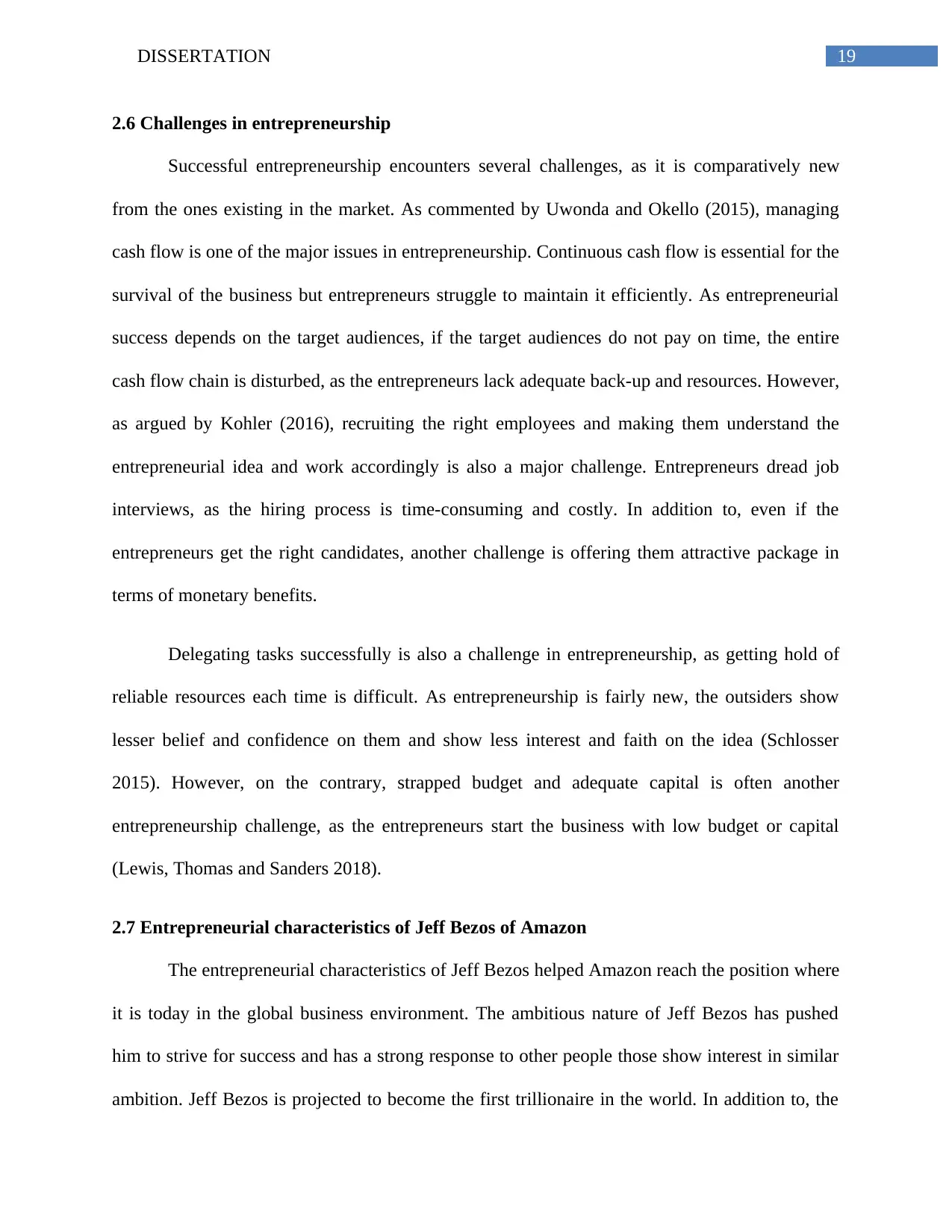
19DISSERTATION
2.6 Challenges in entrepreneurship
Successful entrepreneurship encounters several challenges, as it is comparatively new
from the ones existing in the market. As commented by Uwonda and Okello (2015), managing
cash flow is one of the major issues in entrepreneurship. Continuous cash flow is essential for the
survival of the business but entrepreneurs struggle to maintain it efficiently. As entrepreneurial
success depends on the target audiences, if the target audiences do not pay on time, the entire
cash flow chain is disturbed, as the entrepreneurs lack adequate back-up and resources. However,
as argued by Kohler (2016), recruiting the right employees and making them understand the
entrepreneurial idea and work accordingly is also a major challenge. Entrepreneurs dread job
interviews, as the hiring process is time-consuming and costly. In addition to, even if the
entrepreneurs get the right candidates, another challenge is offering them attractive package in
terms of monetary benefits.
Delegating tasks successfully is also a challenge in entrepreneurship, as getting hold of
reliable resources each time is difficult. As entrepreneurship is fairly new, the outsiders show
lesser belief and confidence on them and show less interest and faith on the idea (Schlosser
2015). However, on the contrary, strapped budget and adequate capital is often another
entrepreneurship challenge, as the entrepreneurs start the business with low budget or capital
(Lewis, Thomas and Sanders 2018).
2.7 Entrepreneurial characteristics of Jeff Bezos of Amazon
The entrepreneurial characteristics of Jeff Bezos helped Amazon reach the position where
it is today in the global business environment. The ambitious nature of Jeff Bezos has pushed
him to strive for success and has a strong response to other people those show interest in similar
ambition. Jeff Bezos is projected to become the first trillionaire in the world. In addition to, the
2.6 Challenges in entrepreneurship
Successful entrepreneurship encounters several challenges, as it is comparatively new
from the ones existing in the market. As commented by Uwonda and Okello (2015), managing
cash flow is one of the major issues in entrepreneurship. Continuous cash flow is essential for the
survival of the business but entrepreneurs struggle to maintain it efficiently. As entrepreneurial
success depends on the target audiences, if the target audiences do not pay on time, the entire
cash flow chain is disturbed, as the entrepreneurs lack adequate back-up and resources. However,
as argued by Kohler (2016), recruiting the right employees and making them understand the
entrepreneurial idea and work accordingly is also a major challenge. Entrepreneurs dread job
interviews, as the hiring process is time-consuming and costly. In addition to, even if the
entrepreneurs get the right candidates, another challenge is offering them attractive package in
terms of monetary benefits.
Delegating tasks successfully is also a challenge in entrepreneurship, as getting hold of
reliable resources each time is difficult. As entrepreneurship is fairly new, the outsiders show
lesser belief and confidence on them and show less interest and faith on the idea (Schlosser
2015). However, on the contrary, strapped budget and adequate capital is often another
entrepreneurship challenge, as the entrepreneurs start the business with low budget or capital
(Lewis, Thomas and Sanders 2018).
2.7 Entrepreneurial characteristics of Jeff Bezos of Amazon
The entrepreneurial characteristics of Jeff Bezos helped Amazon reach the position where
it is today in the global business environment. The ambitious nature of Jeff Bezos has pushed
him to strive for success and has a strong response to other people those show interest in similar
ambition. Jeff Bezos is projected to become the first trillionaire in the world. In addition to, the
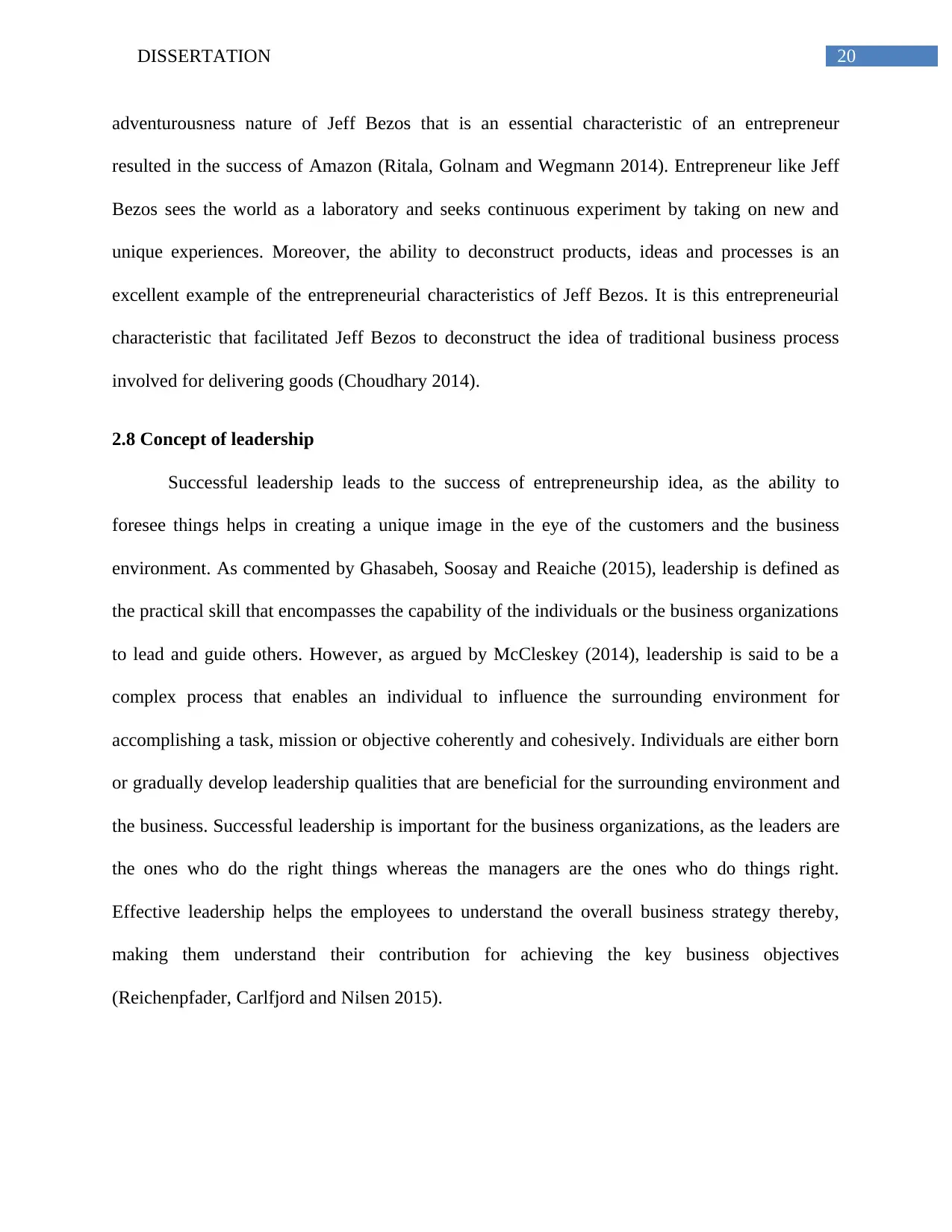
20DISSERTATION
adventurousness nature of Jeff Bezos that is an essential characteristic of an entrepreneur
resulted in the success of Amazon (Ritala, Golnam and Wegmann 2014). Entrepreneur like Jeff
Bezos sees the world as a laboratory and seeks continuous experiment by taking on new and
unique experiences. Moreover, the ability to deconstruct products, ideas and processes is an
excellent example of the entrepreneurial characteristics of Jeff Bezos. It is this entrepreneurial
characteristic that facilitated Jeff Bezos to deconstruct the idea of traditional business process
involved for delivering goods (Choudhary 2014).
2.8 Concept of leadership
Successful leadership leads to the success of entrepreneurship idea, as the ability to
foresee things helps in creating a unique image in the eye of the customers and the business
environment. As commented by Ghasabeh, Soosay and Reaiche (2015), leadership is defined as
the practical skill that encompasses the capability of the individuals or the business organizations
to lead and guide others. However, as argued by McCleskey (2014), leadership is said to be a
complex process that enables an individual to influence the surrounding environment for
accomplishing a task, mission or objective coherently and cohesively. Individuals are either born
or gradually develop leadership qualities that are beneficial for the surrounding environment and
the business. Successful leadership is important for the business organizations, as the leaders are
the ones who do the right things whereas the managers are the ones who do things right.
Effective leadership helps the employees to understand the overall business strategy thereby,
making them understand their contribution for achieving the key business objectives
(Reichenpfader, Carlfjord and Nilsen 2015).
adventurousness nature of Jeff Bezos that is an essential characteristic of an entrepreneur
resulted in the success of Amazon (Ritala, Golnam and Wegmann 2014). Entrepreneur like Jeff
Bezos sees the world as a laboratory and seeks continuous experiment by taking on new and
unique experiences. Moreover, the ability to deconstruct products, ideas and processes is an
excellent example of the entrepreneurial characteristics of Jeff Bezos. It is this entrepreneurial
characteristic that facilitated Jeff Bezos to deconstruct the idea of traditional business process
involved for delivering goods (Choudhary 2014).
2.8 Concept of leadership
Successful leadership leads to the success of entrepreneurship idea, as the ability to
foresee things helps in creating a unique image in the eye of the customers and the business
environment. As commented by Ghasabeh, Soosay and Reaiche (2015), leadership is defined as
the practical skill that encompasses the capability of the individuals or the business organizations
to lead and guide others. However, as argued by McCleskey (2014), leadership is said to be a
complex process that enables an individual to influence the surrounding environment for
accomplishing a task, mission or objective coherently and cohesively. Individuals are either born
or gradually develop leadership qualities that are beneficial for the surrounding environment and
the business. Successful leadership is important for the business organizations, as the leaders are
the ones who do the right things whereas the managers are the ones who do things right.
Effective leadership helps the employees to understand the overall business strategy thereby,
making them understand their contribution for achieving the key business objectives
(Reichenpfader, Carlfjord and Nilsen 2015).

21DISSERTATION
2.9 Discussing the leadership principles of Amazon
Since the establishment of Amazon, the company has come a long way and Jeff Bezos
has followed fourteen significant leadership principles that have defined the position of Amazon
in today’s world. The fourteen leadership principles that drive Amazon are mentioned below.
Customer obsession: Amazon starts from customers and walk backwards for earning and
keeping customer trust thereby, highlighting successful customer obsession.
Ownership: Amazon do not sacrifice long-term values for short-term values and act on behalf of
the company and the teams without saying it is not their job.
Invent and simplify: In Amazon, the employees are expected and required to innovate as well as
invent for their teams along with finding ways to simplify them. For doing it, the employees
show better external awareness and gathering ideas constantly.
Are right, a lot: Amazon believes that their leader is right majority of the times and have strong
judgment and good instincts by considering varied perspectives.
Learn and be curious: Amazon believes in the principle that there is no end to learning and
promotes personal development continuously by being curious about new opportunities and be
ready for exploring them.
Hire and develop the best: Amazon believes in raising the performance bar with every
recruitment and promotion process by identifying the willingness and talent.
Insist on the highest standards: The Company believes in maintaining high standard and Jeff
Bezos keeps on raising the standard thereby, enforcing the employees to bring out the best while
working.
2.9 Discussing the leadership principles of Amazon
Since the establishment of Amazon, the company has come a long way and Jeff Bezos
has followed fourteen significant leadership principles that have defined the position of Amazon
in today’s world. The fourteen leadership principles that drive Amazon are mentioned below.
Customer obsession: Amazon starts from customers and walk backwards for earning and
keeping customer trust thereby, highlighting successful customer obsession.
Ownership: Amazon do not sacrifice long-term values for short-term values and act on behalf of
the company and the teams without saying it is not their job.
Invent and simplify: In Amazon, the employees are expected and required to innovate as well as
invent for their teams along with finding ways to simplify them. For doing it, the employees
show better external awareness and gathering ideas constantly.
Are right, a lot: Amazon believes that their leader is right majority of the times and have strong
judgment and good instincts by considering varied perspectives.
Learn and be curious: Amazon believes in the principle that there is no end to learning and
promotes personal development continuously by being curious about new opportunities and be
ready for exploring them.
Hire and develop the best: Amazon believes in raising the performance bar with every
recruitment and promotion process by identifying the willingness and talent.
Insist on the highest standards: The Company believes in maintaining high standard and Jeff
Bezos keeps on raising the standard thereby, enforcing the employees to bring out the best while
working.
Secure Best Marks with AI Grader
Need help grading? Try our AI Grader for instant feedback on your assignments.
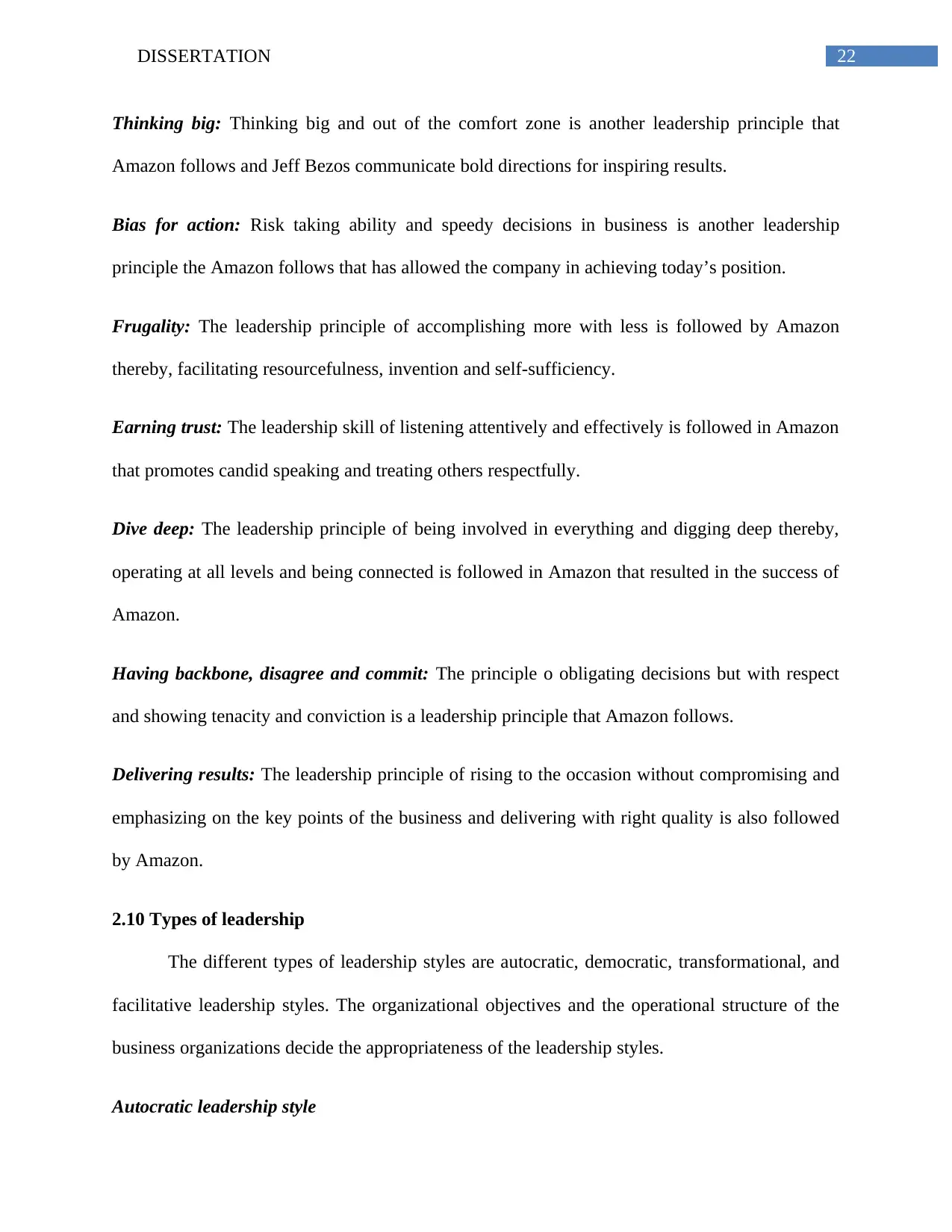
22DISSERTATION
Thinking big: Thinking big and out of the comfort zone is another leadership principle that
Amazon follows and Jeff Bezos communicate bold directions for inspiring results.
Bias for action: Risk taking ability and speedy decisions in business is another leadership
principle the Amazon follows that has allowed the company in achieving today’s position.
Frugality: The leadership principle of accomplishing more with less is followed by Amazon
thereby, facilitating resourcefulness, invention and self-sufficiency.
Earning trust: The leadership skill of listening attentively and effectively is followed in Amazon
that promotes candid speaking and treating others respectfully.
Dive deep: The leadership principle of being involved in everything and digging deep thereby,
operating at all levels and being connected is followed in Amazon that resulted in the success of
Amazon.
Having backbone, disagree and commit: The principle o obligating decisions but with respect
and showing tenacity and conviction is a leadership principle that Amazon follows.
Delivering results: The leadership principle of rising to the occasion without compromising and
emphasizing on the key points of the business and delivering with right quality is also followed
by Amazon.
2.10 Types of leadership
The different types of leadership styles are autocratic, democratic, transformational, and
facilitative leadership styles. The organizational objectives and the operational structure of the
business organizations decide the appropriateness of the leadership styles.
Autocratic leadership style
Thinking big: Thinking big and out of the comfort zone is another leadership principle that
Amazon follows and Jeff Bezos communicate bold directions for inspiring results.
Bias for action: Risk taking ability and speedy decisions in business is another leadership
principle the Amazon follows that has allowed the company in achieving today’s position.
Frugality: The leadership principle of accomplishing more with less is followed by Amazon
thereby, facilitating resourcefulness, invention and self-sufficiency.
Earning trust: The leadership skill of listening attentively and effectively is followed in Amazon
that promotes candid speaking and treating others respectfully.
Dive deep: The leadership principle of being involved in everything and digging deep thereby,
operating at all levels and being connected is followed in Amazon that resulted in the success of
Amazon.
Having backbone, disagree and commit: The principle o obligating decisions but with respect
and showing tenacity and conviction is a leadership principle that Amazon follows.
Delivering results: The leadership principle of rising to the occasion without compromising and
emphasizing on the key points of the business and delivering with right quality is also followed
by Amazon.
2.10 Types of leadership
The different types of leadership styles are autocratic, democratic, transformational, and
facilitative leadership styles. The organizational objectives and the operational structure of the
business organizations decide the appropriateness of the leadership styles.
Autocratic leadership style
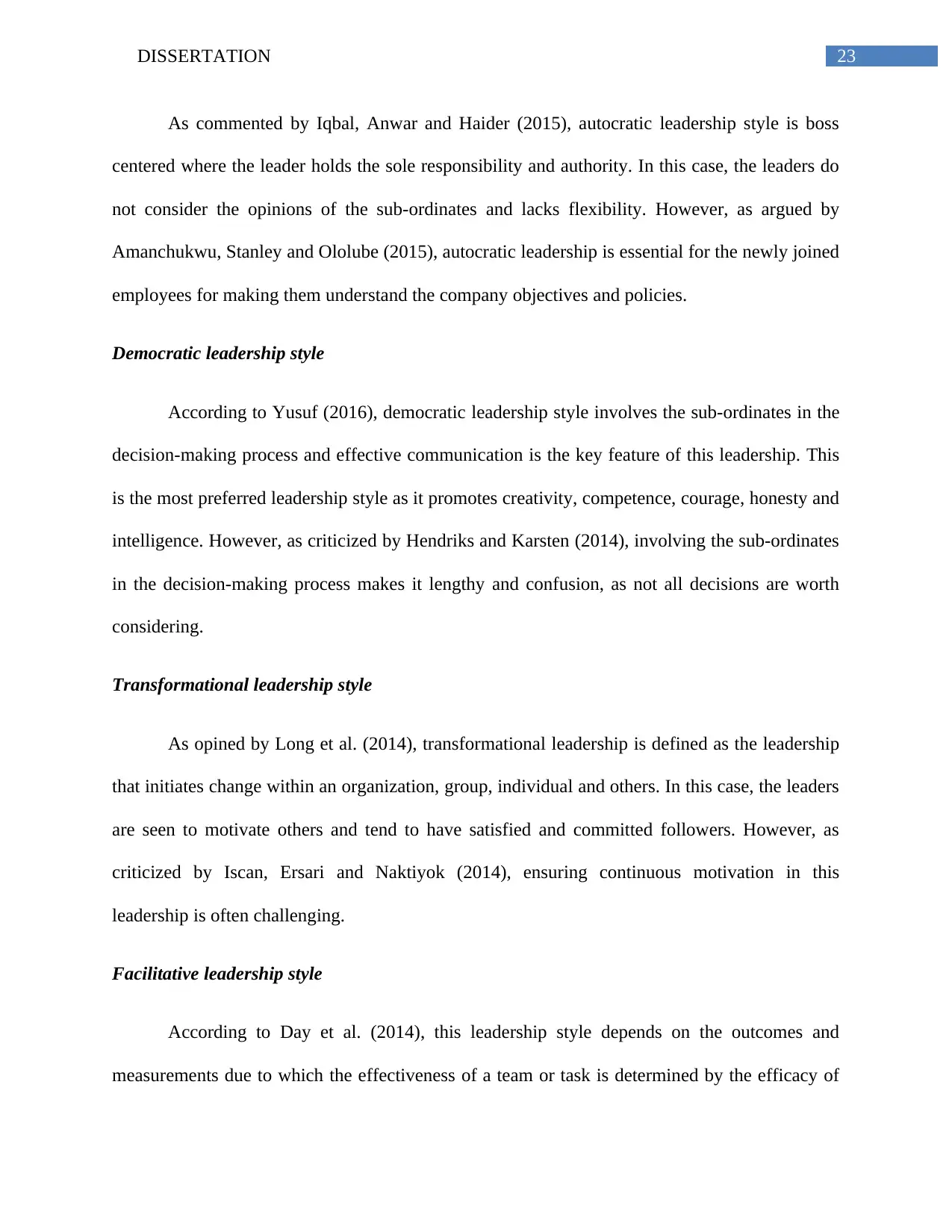
23DISSERTATION
As commented by Iqbal, Anwar and Haider (2015), autocratic leadership style is boss
centered where the leader holds the sole responsibility and authority. In this case, the leaders do
not consider the opinions of the sub-ordinates and lacks flexibility. However, as argued by
Amanchukwu, Stanley and Ololube (2015), autocratic leadership is essential for the newly joined
employees for making them understand the company objectives and policies.
Democratic leadership style
According to Yusuf (2016), democratic leadership style involves the sub-ordinates in the
decision-making process and effective communication is the key feature of this leadership. This
is the most preferred leadership style as it promotes creativity, competence, courage, honesty and
intelligence. However, as criticized by Hendriks and Karsten (2014), involving the sub-ordinates
in the decision-making process makes it lengthy and confusion, as not all decisions are worth
considering.
Transformational leadership style
As opined by Long et al. (2014), transformational leadership is defined as the leadership
that initiates change within an organization, group, individual and others. In this case, the leaders
are seen to motivate others and tend to have satisfied and committed followers. However, as
criticized by Iscan, Ersari and Naktiyok (2014), ensuring continuous motivation in this
leadership is often challenging.
Facilitative leadership style
According to Day et al. (2014), this leadership style depends on the outcomes and
measurements due to which the effectiveness of a team or task is determined by the efficacy of
As commented by Iqbal, Anwar and Haider (2015), autocratic leadership style is boss
centered where the leader holds the sole responsibility and authority. In this case, the leaders do
not consider the opinions of the sub-ordinates and lacks flexibility. However, as argued by
Amanchukwu, Stanley and Ololube (2015), autocratic leadership is essential for the newly joined
employees for making them understand the company objectives and policies.
Democratic leadership style
According to Yusuf (2016), democratic leadership style involves the sub-ordinates in the
decision-making process and effective communication is the key feature of this leadership. This
is the most preferred leadership style as it promotes creativity, competence, courage, honesty and
intelligence. However, as criticized by Hendriks and Karsten (2014), involving the sub-ordinates
in the decision-making process makes it lengthy and confusion, as not all decisions are worth
considering.
Transformational leadership style
As opined by Long et al. (2014), transformational leadership is defined as the leadership
that initiates change within an organization, group, individual and others. In this case, the leaders
are seen to motivate others and tend to have satisfied and committed followers. However, as
criticized by Iscan, Ersari and Naktiyok (2014), ensuring continuous motivation in this
leadership is often challenging.
Facilitative leadership style
According to Day et al. (2014), this leadership style depends on the outcomes and
measurements due to which the effectiveness of a team or task is determined by the efficacy of

24DISSERTATION
the process. However, as argued by Bussu and Bartels (2014), as outcomes are only considered,
the effort of the employees are not often neglected by the leaders resulting in demotivation.
2.11 Relationship between leadership and entrepreneurship
Leadership and entrepreneurs goes simultaneously, as effective leadership skills result in
successful entrepreneurship. According to Bae et al. (2014), strategic vision is a leadership skill
that results in successful entrepreneurship because it highlights passion and great business idea
that is required for business success. Thus, both entrepreneurship and leadership influences
group of people and individuals to achieve a common goal by showing pro-activeness, risk
optimization and managing change within a dynamic business environment. Both leadership and
entrepreneurship aim towards developing teams and individuals that are creative enough to
create value for an organization. This can be achieved by employing practices that enables the
employees to self-generate, self-correct and self-reflect. However, as argued by Renz (2016),
entrepreneurship and leadership, also known as entrepreneurial leadership uses skills effectively
on a larger scale for risk minimization by spotting and retaining the best talent. The leaders have
the quality of identifying the uniqueness among the existing work force and guide them for
achieving the entrepreneurship idea successfully.
In addition to, both leadership and entrepreneurship believes in leading by examples,
having strong values and preaching what the leaders and entrepreneurs are living. From the
above information, it can be said that entrepreneurship and leadership are related and has a
positive impact on each other.
the process. However, as argued by Bussu and Bartels (2014), as outcomes are only considered,
the effort of the employees are not often neglected by the leaders resulting in demotivation.
2.11 Relationship between leadership and entrepreneurship
Leadership and entrepreneurs goes simultaneously, as effective leadership skills result in
successful entrepreneurship. According to Bae et al. (2014), strategic vision is a leadership skill
that results in successful entrepreneurship because it highlights passion and great business idea
that is required for business success. Thus, both entrepreneurship and leadership influences
group of people and individuals to achieve a common goal by showing pro-activeness, risk
optimization and managing change within a dynamic business environment. Both leadership and
entrepreneurship aim towards developing teams and individuals that are creative enough to
create value for an organization. This can be achieved by employing practices that enables the
employees to self-generate, self-correct and self-reflect. However, as argued by Renz (2016),
entrepreneurship and leadership, also known as entrepreneurial leadership uses skills effectively
on a larger scale for risk minimization by spotting and retaining the best talent. The leaders have
the quality of identifying the uniqueness among the existing work force and guide them for
achieving the entrepreneurship idea successfully.
In addition to, both leadership and entrepreneurship believes in leading by examples,
having strong values and preaching what the leaders and entrepreneurs are living. From the
above information, it can be said that entrepreneurship and leadership are related and has a
positive impact on each other.
Paraphrase This Document
Need a fresh take? Get an instant paraphrase of this document with our AI Paraphraser
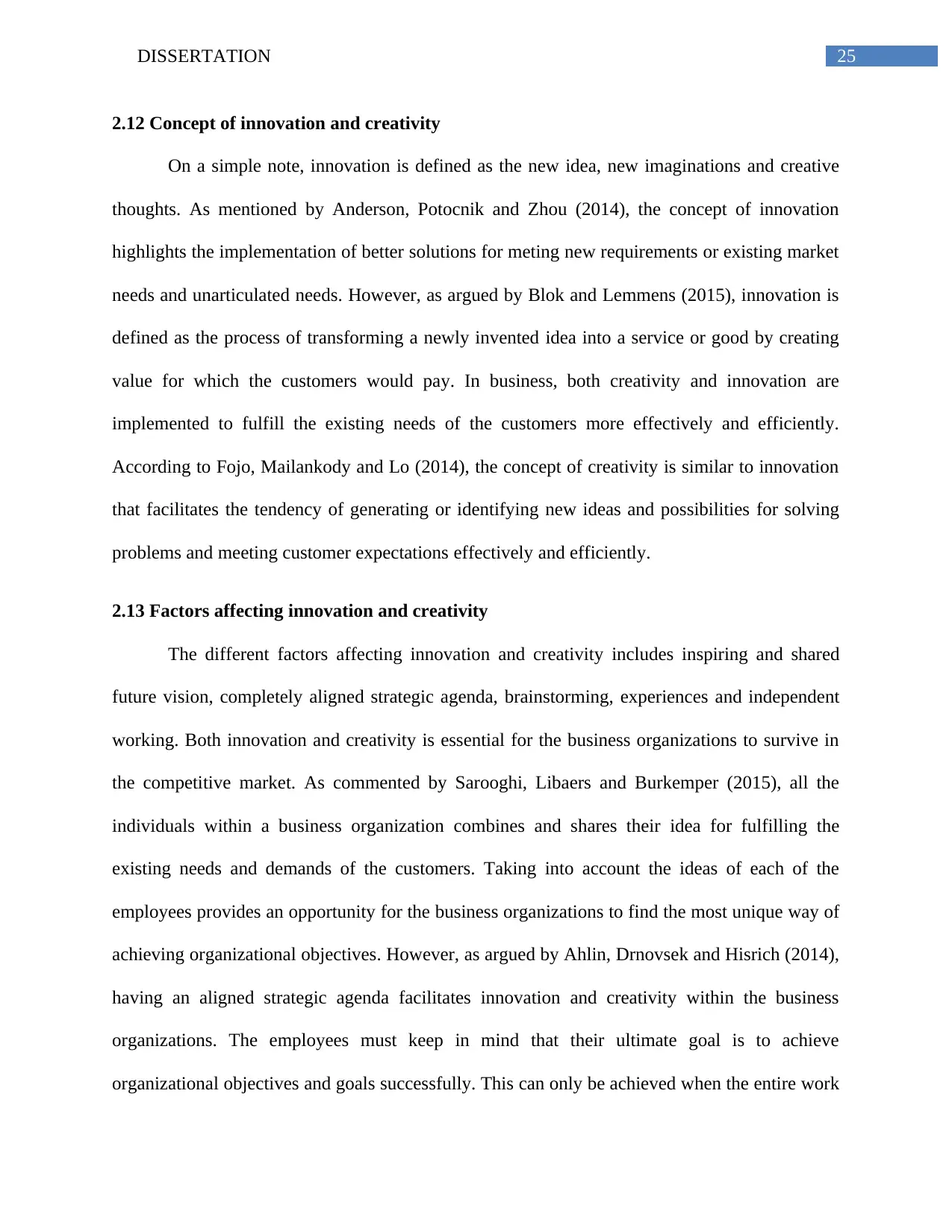
25DISSERTATION
2.12 Concept of innovation and creativity
On a simple note, innovation is defined as the new idea, new imaginations and creative
thoughts. As mentioned by Anderson, Potocnik and Zhou (2014), the concept of innovation
highlights the implementation of better solutions for meting new requirements or existing market
needs and unarticulated needs. However, as argued by Blok and Lemmens (2015), innovation is
defined as the process of transforming a newly invented idea into a service or good by creating
value for which the customers would pay. In business, both creativity and innovation are
implemented to fulfill the existing needs of the customers more effectively and efficiently.
According to Fojo, Mailankody and Lo (2014), the concept of creativity is similar to innovation
that facilitates the tendency of generating or identifying new ideas and possibilities for solving
problems and meeting customer expectations effectively and efficiently.
2.13 Factors affecting innovation and creativity
The different factors affecting innovation and creativity includes inspiring and shared
future vision, completely aligned strategic agenda, brainstorming, experiences and independent
working. Both innovation and creativity is essential for the business organizations to survive in
the competitive market. As commented by Sarooghi, Libaers and Burkemper (2015), all the
individuals within a business organization combines and shares their idea for fulfilling the
existing needs and demands of the customers. Taking into account the ideas of each of the
employees provides an opportunity for the business organizations to find the most unique way of
achieving organizational objectives. However, as argued by Ahlin, Drnovsek and Hisrich (2014),
having an aligned strategic agenda facilitates innovation and creativity within the business
organizations. The employees must keep in mind that their ultimate goal is to achieve
organizational objectives and goals successfully. This can only be achieved when the entire work
2.12 Concept of innovation and creativity
On a simple note, innovation is defined as the new idea, new imaginations and creative
thoughts. As mentioned by Anderson, Potocnik and Zhou (2014), the concept of innovation
highlights the implementation of better solutions for meting new requirements or existing market
needs and unarticulated needs. However, as argued by Blok and Lemmens (2015), innovation is
defined as the process of transforming a newly invented idea into a service or good by creating
value for which the customers would pay. In business, both creativity and innovation are
implemented to fulfill the existing needs of the customers more effectively and efficiently.
According to Fojo, Mailankody and Lo (2014), the concept of creativity is similar to innovation
that facilitates the tendency of generating or identifying new ideas and possibilities for solving
problems and meeting customer expectations effectively and efficiently.
2.13 Factors affecting innovation and creativity
The different factors affecting innovation and creativity includes inspiring and shared
future vision, completely aligned strategic agenda, brainstorming, experiences and independent
working. Both innovation and creativity is essential for the business organizations to survive in
the competitive market. As commented by Sarooghi, Libaers and Burkemper (2015), all the
individuals within a business organization combines and shares their idea for fulfilling the
existing needs and demands of the customers. Taking into account the ideas of each of the
employees provides an opportunity for the business organizations to find the most unique way of
achieving organizational objectives. However, as argued by Ahlin, Drnovsek and Hisrich (2014),
having an aligned strategic agenda facilitates innovation and creativity within the business
organizations. The employees must keep in mind that their ultimate goal is to achieve
organizational objectives and goals successfully. This can only be achieved when the entire work
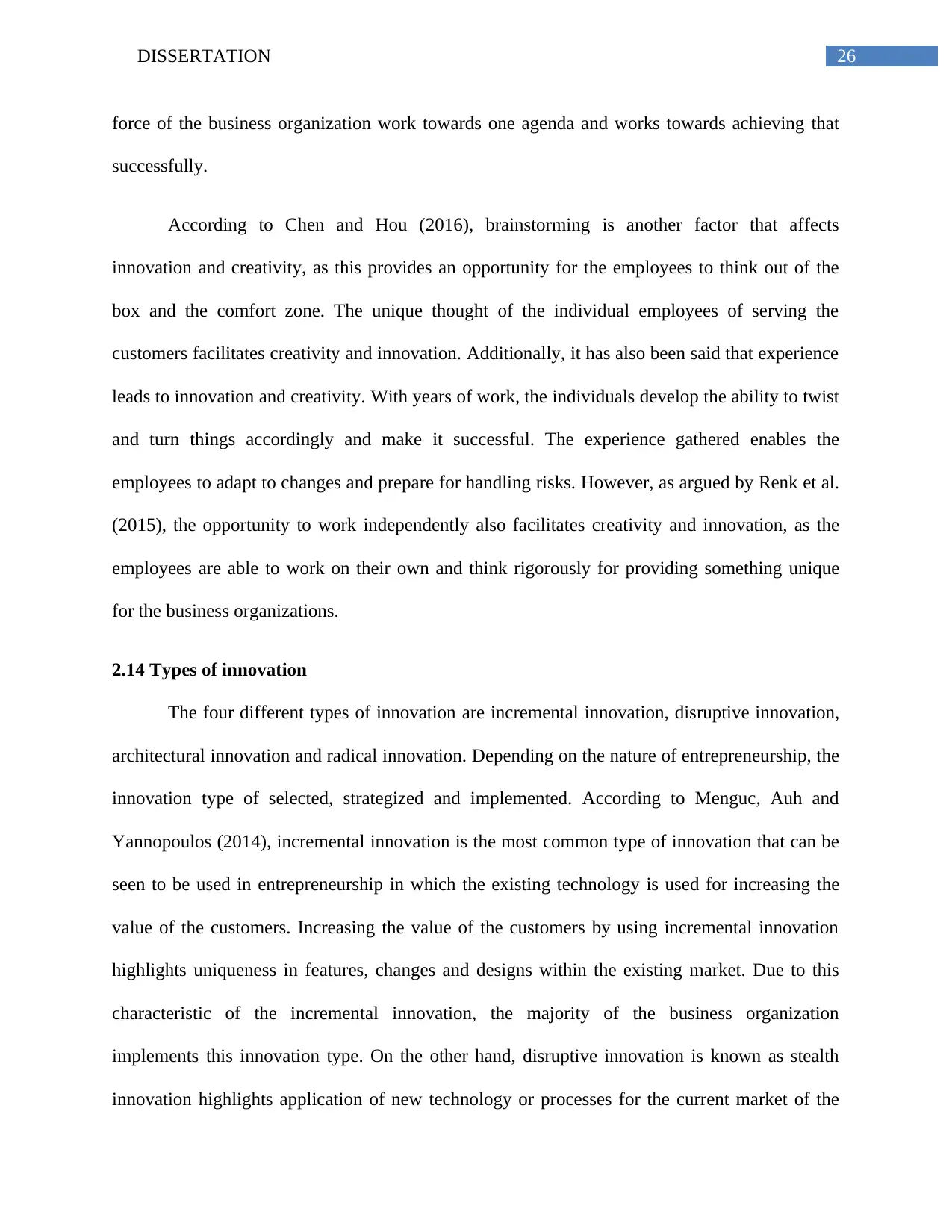
26DISSERTATION
force of the business organization work towards one agenda and works towards achieving that
successfully.
According to Chen and Hou (2016), brainstorming is another factor that affects
innovation and creativity, as this provides an opportunity for the employees to think out of the
box and the comfort zone. The unique thought of the individual employees of serving the
customers facilitates creativity and innovation. Additionally, it has also been said that experience
leads to innovation and creativity. With years of work, the individuals develop the ability to twist
and turn things accordingly and make it successful. The experience gathered enables the
employees to adapt to changes and prepare for handling risks. However, as argued by Renk et al.
(2015), the opportunity to work independently also facilitates creativity and innovation, as the
employees are able to work on their own and think rigorously for providing something unique
for the business organizations.
2.14 Types of innovation
The four different types of innovation are incremental innovation, disruptive innovation,
architectural innovation and radical innovation. Depending on the nature of entrepreneurship, the
innovation type of selected, strategized and implemented. According to Menguc, Auh and
Yannopoulos (2014), incremental innovation is the most common type of innovation that can be
seen to be used in entrepreneurship in which the existing technology is used for increasing the
value of the customers. Increasing the value of the customers by using incremental innovation
highlights uniqueness in features, changes and designs within the existing market. Due to this
characteristic of the incremental innovation, the majority of the business organization
implements this innovation type. On the other hand, disruptive innovation is known as stealth
innovation highlights application of new technology or processes for the current market of the
force of the business organization work towards one agenda and works towards achieving that
successfully.
According to Chen and Hou (2016), brainstorming is another factor that affects
innovation and creativity, as this provides an opportunity for the employees to think out of the
box and the comfort zone. The unique thought of the individual employees of serving the
customers facilitates creativity and innovation. Additionally, it has also been said that experience
leads to innovation and creativity. With years of work, the individuals develop the ability to twist
and turn things accordingly and make it successful. The experience gathered enables the
employees to adapt to changes and prepare for handling risks. However, as argued by Renk et al.
(2015), the opportunity to work independently also facilitates creativity and innovation, as the
employees are able to work on their own and think rigorously for providing something unique
for the business organizations.
2.14 Types of innovation
The four different types of innovation are incremental innovation, disruptive innovation,
architectural innovation and radical innovation. Depending on the nature of entrepreneurship, the
innovation type of selected, strategized and implemented. According to Menguc, Auh and
Yannopoulos (2014), incremental innovation is the most common type of innovation that can be
seen to be used in entrepreneurship in which the existing technology is used for increasing the
value of the customers. Increasing the value of the customers by using incremental innovation
highlights uniqueness in features, changes and designs within the existing market. Due to this
characteristic of the incremental innovation, the majority of the business organization
implements this innovation type. On the other hand, disruptive innovation is known as stealth
innovation highlights application of new technology or processes for the current market of the
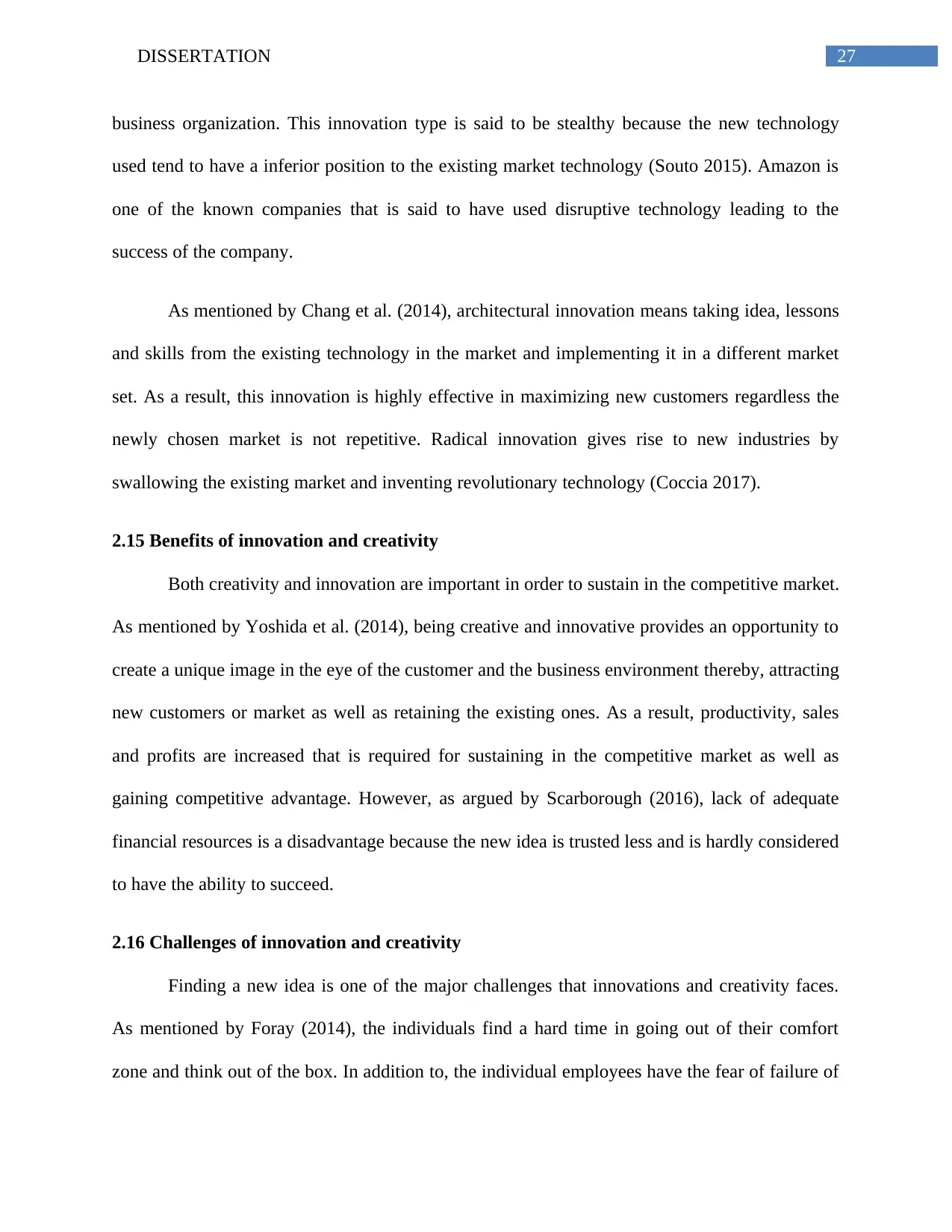
27DISSERTATION
business organization. This innovation type is said to be stealthy because the new technology
used tend to have a inferior position to the existing market technology (Souto 2015). Amazon is
one of the known companies that is said to have used disruptive technology leading to the
success of the company.
As mentioned by Chang et al. (2014), architectural innovation means taking idea, lessons
and skills from the existing technology in the market and implementing it in a different market
set. As a result, this innovation is highly effective in maximizing new customers regardless the
newly chosen market is not repetitive. Radical innovation gives rise to new industries by
swallowing the existing market and inventing revolutionary technology (Coccia 2017).
2.15 Benefits of innovation and creativity
Both creativity and innovation are important in order to sustain in the competitive market.
As mentioned by Yoshida et al. (2014), being creative and innovative provides an opportunity to
create a unique image in the eye of the customer and the business environment thereby, attracting
new customers or market as well as retaining the existing ones. As a result, productivity, sales
and profits are increased that is required for sustaining in the competitive market as well as
gaining competitive advantage. However, as argued by Scarborough (2016), lack of adequate
financial resources is a disadvantage because the new idea is trusted less and is hardly considered
to have the ability to succeed.
2.16 Challenges of innovation and creativity
Finding a new idea is one of the major challenges that innovations and creativity faces.
As mentioned by Foray (2014), the individuals find a hard time in going out of their comfort
zone and think out of the box. In addition to, the individual employees have the fear of failure of
business organization. This innovation type is said to be stealthy because the new technology
used tend to have a inferior position to the existing market technology (Souto 2015). Amazon is
one of the known companies that is said to have used disruptive technology leading to the
success of the company.
As mentioned by Chang et al. (2014), architectural innovation means taking idea, lessons
and skills from the existing technology in the market and implementing it in a different market
set. As a result, this innovation is highly effective in maximizing new customers regardless the
newly chosen market is not repetitive. Radical innovation gives rise to new industries by
swallowing the existing market and inventing revolutionary technology (Coccia 2017).
2.15 Benefits of innovation and creativity
Both creativity and innovation are important in order to sustain in the competitive market.
As mentioned by Yoshida et al. (2014), being creative and innovative provides an opportunity to
create a unique image in the eye of the customer and the business environment thereby, attracting
new customers or market as well as retaining the existing ones. As a result, productivity, sales
and profits are increased that is required for sustaining in the competitive market as well as
gaining competitive advantage. However, as argued by Scarborough (2016), lack of adequate
financial resources is a disadvantage because the new idea is trusted less and is hardly considered
to have the ability to succeed.
2.16 Challenges of innovation and creativity
Finding a new idea is one of the major challenges that innovations and creativity faces.
As mentioned by Foray (2014), the individuals find a hard time in going out of their comfort
zone and think out of the box. In addition to, the individual employees have the fear of failure of
Secure Best Marks with AI Grader
Need help grading? Try our AI Grader for instant feedback on your assignments.
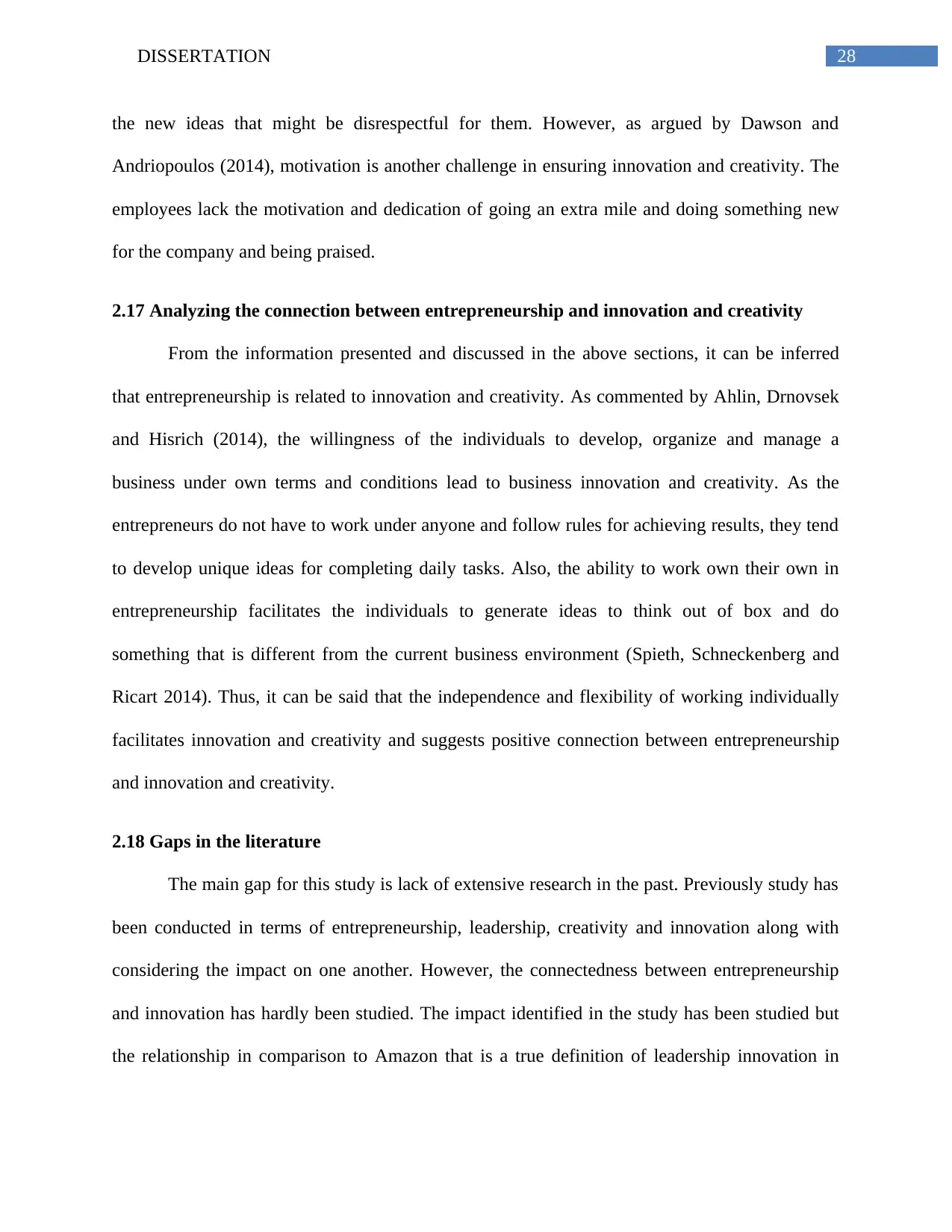
28DISSERTATION
the new ideas that might be disrespectful for them. However, as argued by Dawson and
Andriopoulos (2014), motivation is another challenge in ensuring innovation and creativity. The
employees lack the motivation and dedication of going an extra mile and doing something new
for the company and being praised.
2.17 Analyzing the connection between entrepreneurship and innovation and creativity
From the information presented and discussed in the above sections, it can be inferred
that entrepreneurship is related to innovation and creativity. As commented by Ahlin, Drnovsek
and Hisrich (2014), the willingness of the individuals to develop, organize and manage a
business under own terms and conditions lead to business innovation and creativity. As the
entrepreneurs do not have to work under anyone and follow rules for achieving results, they tend
to develop unique ideas for completing daily tasks. Also, the ability to work own their own in
entrepreneurship facilitates the individuals to generate ideas to think out of box and do
something that is different from the current business environment (Spieth, Schneckenberg and
Ricart 2014). Thus, it can be said that the independence and flexibility of working individually
facilitates innovation and creativity and suggests positive connection between entrepreneurship
and innovation and creativity.
2.18 Gaps in the literature
The main gap for this study is lack of extensive research in the past. Previously study has
been conducted in terms of entrepreneurship, leadership, creativity and innovation along with
considering the impact on one another. However, the connectedness between entrepreneurship
and innovation has hardly been studied. The impact identified in the study has been studied but
the relationship in comparison to Amazon that is a true definition of leadership innovation in
the new ideas that might be disrespectful for them. However, as argued by Dawson and
Andriopoulos (2014), motivation is another challenge in ensuring innovation and creativity. The
employees lack the motivation and dedication of going an extra mile and doing something new
for the company and being praised.
2.17 Analyzing the connection between entrepreneurship and innovation and creativity
From the information presented and discussed in the above sections, it can be inferred
that entrepreneurship is related to innovation and creativity. As commented by Ahlin, Drnovsek
and Hisrich (2014), the willingness of the individuals to develop, organize and manage a
business under own terms and conditions lead to business innovation and creativity. As the
entrepreneurs do not have to work under anyone and follow rules for achieving results, they tend
to develop unique ideas for completing daily tasks. Also, the ability to work own their own in
entrepreneurship facilitates the individuals to generate ideas to think out of box and do
something that is different from the current business environment (Spieth, Schneckenberg and
Ricart 2014). Thus, it can be said that the independence and flexibility of working individually
facilitates innovation and creativity and suggests positive connection between entrepreneurship
and innovation and creativity.
2.18 Gaps in the literature
The main gap for this study is lack of extensive research in the past. Previously study has
been conducted in terms of entrepreneurship, leadership, creativity and innovation along with
considering the impact on one another. However, the connectedness between entrepreneurship
and innovation has hardly been studied. The impact identified in the study has been studied but
the relationship in comparison to Amazon that is a true definition of leadership innovation in

29DISSERTATION
today’s world. As a result, the researcher faced issues in gathering relevant information that
supported relationship between entrepreneurship and innovation.
2.19 Summary
Thus, it can be summarized that entrepreneurship often leads to innovation. The
independent and free nature of entrepreneurship facilitates brainstorming and thinks out of the
box that results in creativity and innovation. Entrepreneurs are ideal leaders that prove the true
definition of innovation. The ability to foresee the future business prospects and develop ideas
accordingly is signs of true leaders with entrepreneurial skills thereby, highlighting innovation
and creativity. One such example is Amazon that is studied in this chapter that helps in
understanding the connection between entrepreneurship and innovation and representing a true
definition of leadership innovation.
today’s world. As a result, the researcher faced issues in gathering relevant information that
supported relationship between entrepreneurship and innovation.
2.19 Summary
Thus, it can be summarized that entrepreneurship often leads to innovation. The
independent and free nature of entrepreneurship facilitates brainstorming and thinks out of the
box that results in creativity and innovation. Entrepreneurs are ideal leaders that prove the true
definition of innovation. The ability to foresee the future business prospects and develop ideas
accordingly is signs of true leaders with entrepreneurial skills thereby, highlighting innovation
and creativity. One such example is Amazon that is studied in this chapter that helps in
understanding the connection between entrepreneurship and innovation and representing a true
definition of leadership innovation.
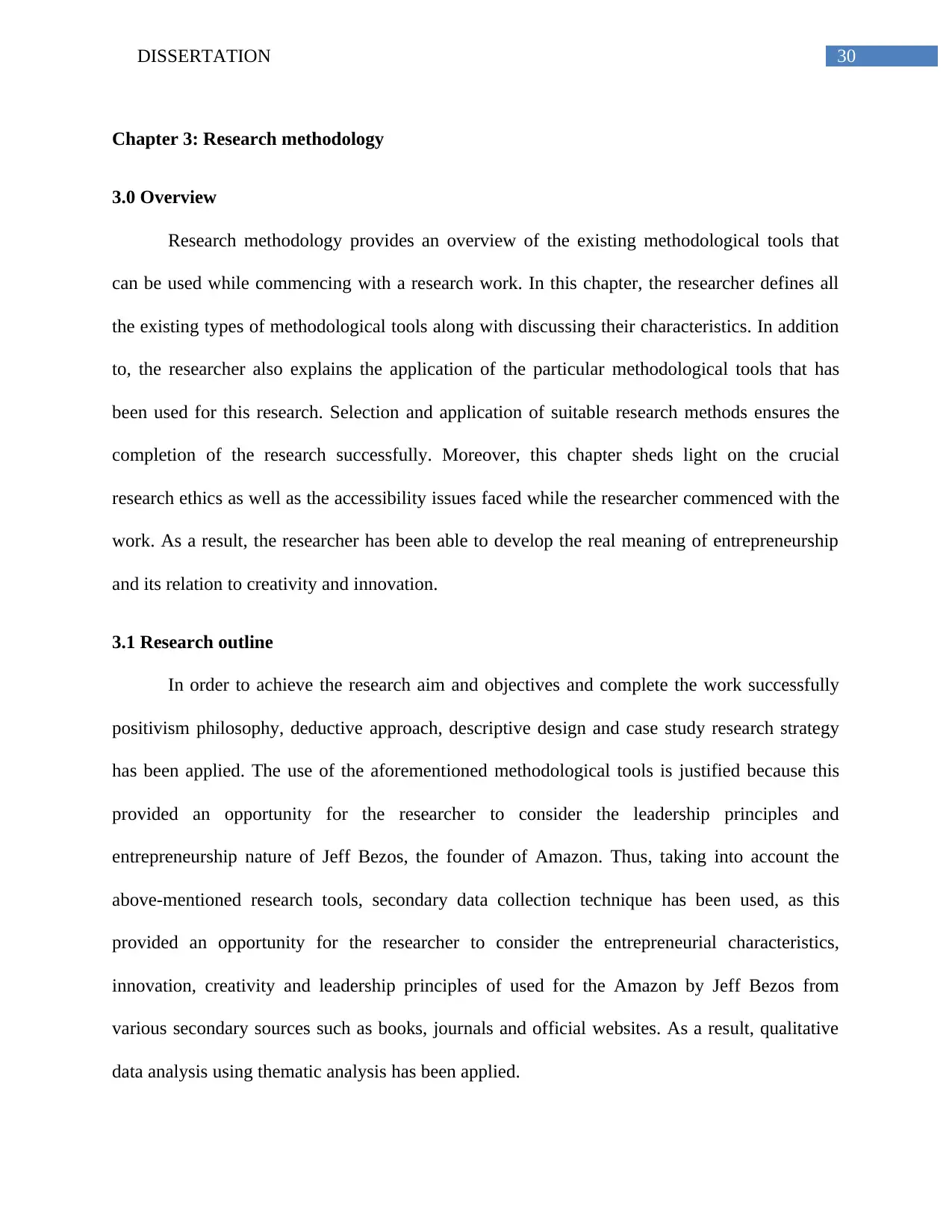
30DISSERTATION
Chapter 3: Research methodology
3.0 Overview
Research methodology provides an overview of the existing methodological tools that
can be used while commencing with a research work. In this chapter, the researcher defines all
the existing types of methodological tools along with discussing their characteristics. In addition
to, the researcher also explains the application of the particular methodological tools that has
been used for this research. Selection and application of suitable research methods ensures the
completion of the research successfully. Moreover, this chapter sheds light on the crucial
research ethics as well as the accessibility issues faced while the researcher commenced with the
work. As a result, the researcher has been able to develop the real meaning of entrepreneurship
and its relation to creativity and innovation.
3.1 Research outline
In order to achieve the research aim and objectives and complete the work successfully
positivism philosophy, deductive approach, descriptive design and case study research strategy
has been applied. The use of the aforementioned methodological tools is justified because this
provided an opportunity for the researcher to consider the leadership principles and
entrepreneurship nature of Jeff Bezos, the founder of Amazon. Thus, taking into account the
above-mentioned research tools, secondary data collection technique has been used, as this
provided an opportunity for the researcher to consider the entrepreneurial characteristics,
innovation, creativity and leadership principles of used for the Amazon by Jeff Bezos from
various secondary sources such as books, journals and official websites. As a result, qualitative
data analysis using thematic analysis has been applied.
Chapter 3: Research methodology
3.0 Overview
Research methodology provides an overview of the existing methodological tools that
can be used while commencing with a research work. In this chapter, the researcher defines all
the existing types of methodological tools along with discussing their characteristics. In addition
to, the researcher also explains the application of the particular methodological tools that has
been used for this research. Selection and application of suitable research methods ensures the
completion of the research successfully. Moreover, this chapter sheds light on the crucial
research ethics as well as the accessibility issues faced while the researcher commenced with the
work. As a result, the researcher has been able to develop the real meaning of entrepreneurship
and its relation to creativity and innovation.
3.1 Research outline
In order to achieve the research aim and objectives and complete the work successfully
positivism philosophy, deductive approach, descriptive design and case study research strategy
has been applied. The use of the aforementioned methodological tools is justified because this
provided an opportunity for the researcher to consider the leadership principles and
entrepreneurship nature of Jeff Bezos, the founder of Amazon. Thus, taking into account the
above-mentioned research tools, secondary data collection technique has been used, as this
provided an opportunity for the researcher to consider the entrepreneurial characteristics,
innovation, creativity and leadership principles of used for the Amazon by Jeff Bezos from
various secondary sources such as books, journals and official websites. As a result, qualitative
data analysis using thematic analysis has been applied.
Paraphrase This Document
Need a fresh take? Get an instant paraphrase of this document with our AI Paraphraser
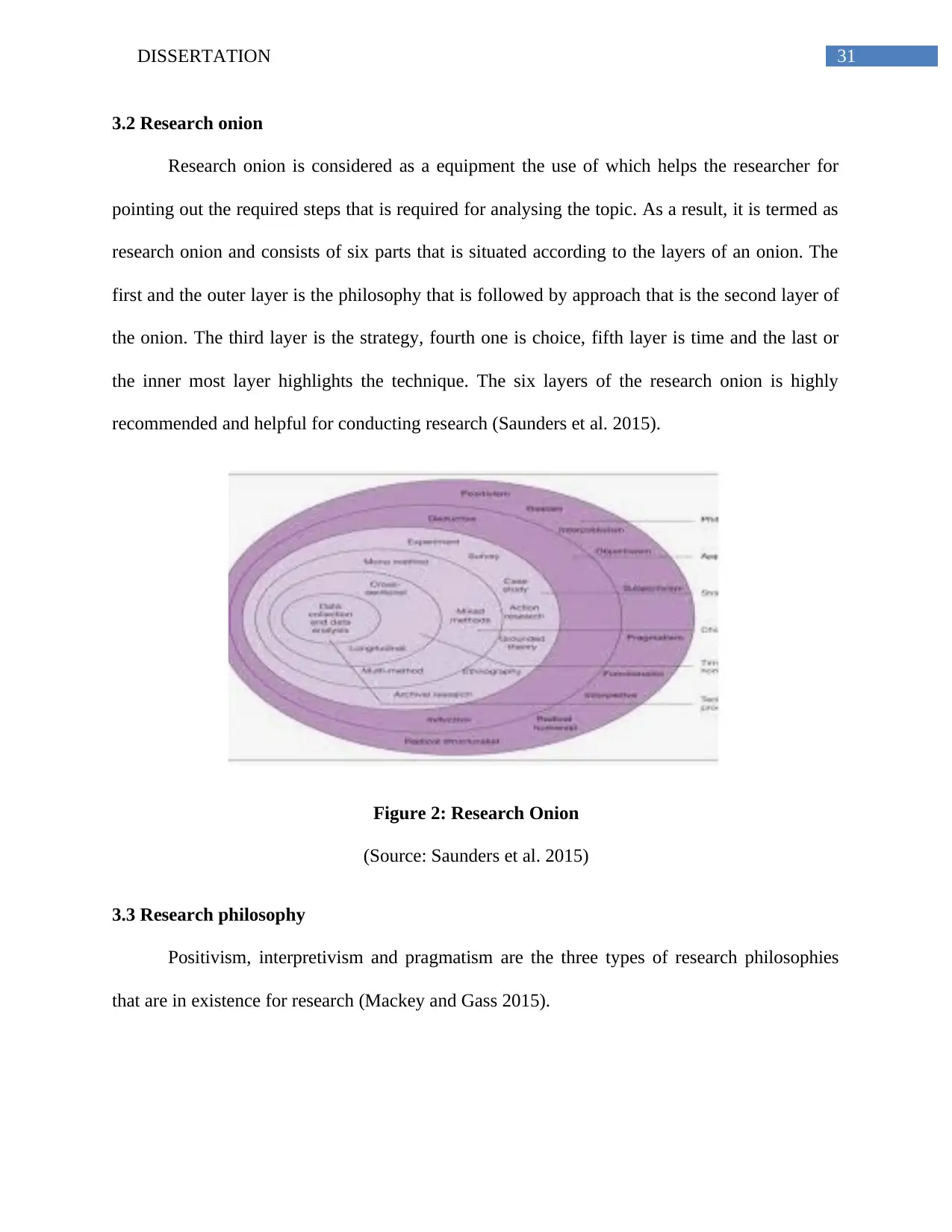
31DISSERTATION
3.2 Research onion
Research onion is considered as a equipment the use of which helps the researcher for
pointing out the required steps that is required for analysing the topic. As a result, it is termed as
research onion and consists of six parts that is situated according to the layers of an onion. The
first and the outer layer is the philosophy that is followed by approach that is the second layer of
the onion. The third layer is the strategy, fourth one is choice, fifth layer is time and the last or
the inner most layer highlights the technique. The six layers of the research onion is highly
recommended and helpful for conducting research (Saunders et al. 2015).
Figure 2: Research Onion
(Source: Saunders et al. 2015)
3.3 Research philosophy
Positivism, interpretivism and pragmatism are the three types of research philosophies
that are in existence for research (Mackey and Gass 2015).
3.2 Research onion
Research onion is considered as a equipment the use of which helps the researcher for
pointing out the required steps that is required for analysing the topic. As a result, it is termed as
research onion and consists of six parts that is situated according to the layers of an onion. The
first and the outer layer is the philosophy that is followed by approach that is the second layer of
the onion. The third layer is the strategy, fourth one is choice, fifth layer is time and the last or
the inner most layer highlights the technique. The six layers of the research onion is highly
recommended and helpful for conducting research (Saunders et al. 2015).
Figure 2: Research Onion
(Source: Saunders et al. 2015)
3.3 Research philosophy
Positivism, interpretivism and pragmatism are the three types of research philosophies
that are in existence for research (Mackey and Gass 2015).
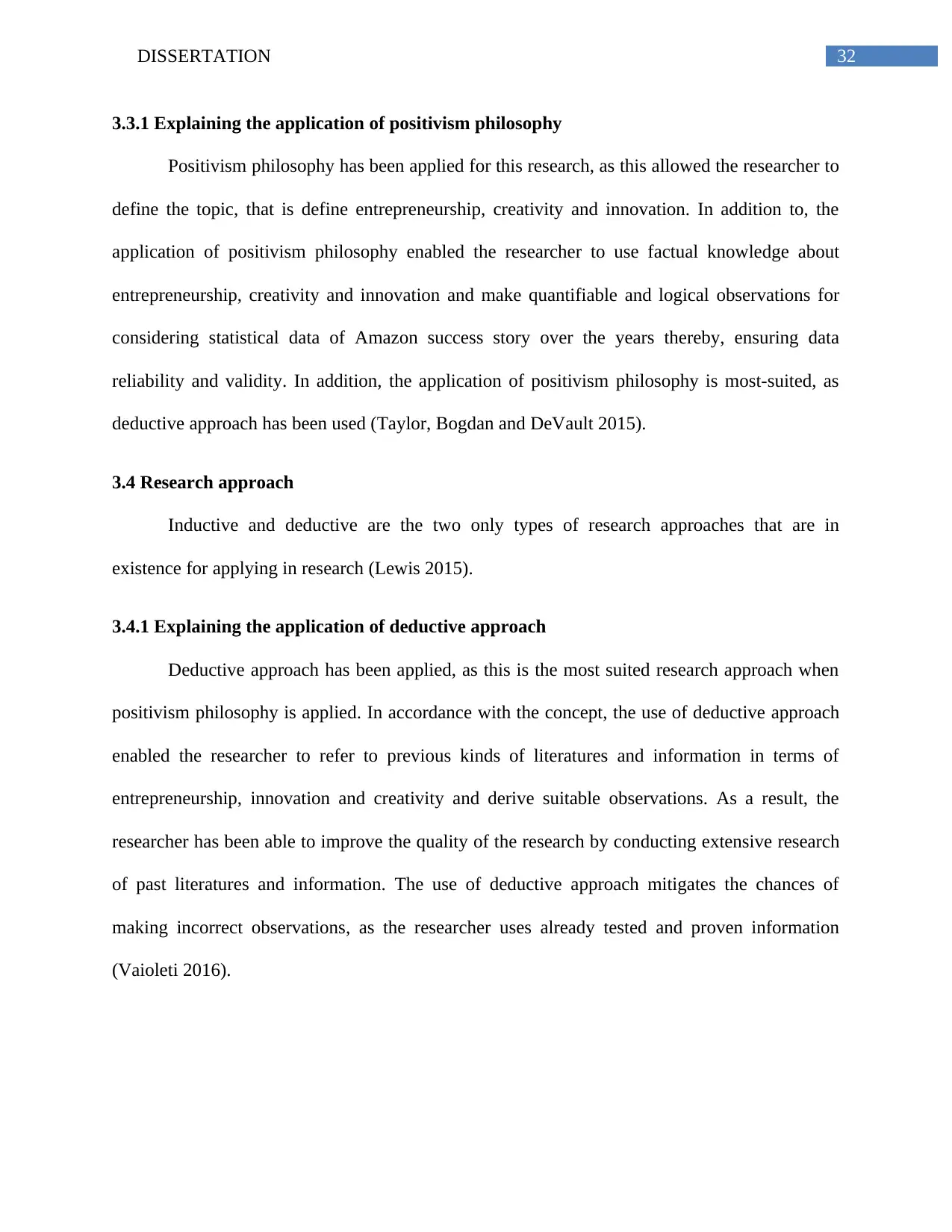
32DISSERTATION
3.3.1 Explaining the application of positivism philosophy
Positivism philosophy has been applied for this research, as this allowed the researcher to
define the topic, that is define entrepreneurship, creativity and innovation. In addition to, the
application of positivism philosophy enabled the researcher to use factual knowledge about
entrepreneurship, creativity and innovation and make quantifiable and logical observations for
considering statistical data of Amazon success story over the years thereby, ensuring data
reliability and validity. In addition, the application of positivism philosophy is most-suited, as
deductive approach has been used (Taylor, Bogdan and DeVault 2015).
3.4 Research approach
Inductive and deductive are the two only types of research approaches that are in
existence for applying in research (Lewis 2015).
3.4.1 Explaining the application of deductive approach
Deductive approach has been applied, as this is the most suited research approach when
positivism philosophy is applied. In accordance with the concept, the use of deductive approach
enabled the researcher to refer to previous kinds of literatures and information in terms of
entrepreneurship, innovation and creativity and derive suitable observations. As a result, the
researcher has been able to improve the quality of the research by conducting extensive research
of past literatures and information. The use of deductive approach mitigates the chances of
making incorrect observations, as the researcher uses already tested and proven information
(Vaioleti 2016).
3.3.1 Explaining the application of positivism philosophy
Positivism philosophy has been applied for this research, as this allowed the researcher to
define the topic, that is define entrepreneurship, creativity and innovation. In addition to, the
application of positivism philosophy enabled the researcher to use factual knowledge about
entrepreneurship, creativity and innovation and make quantifiable and logical observations for
considering statistical data of Amazon success story over the years thereby, ensuring data
reliability and validity. In addition, the application of positivism philosophy is most-suited, as
deductive approach has been used (Taylor, Bogdan and DeVault 2015).
3.4 Research approach
Inductive and deductive are the two only types of research approaches that are in
existence for applying in research (Lewis 2015).
3.4.1 Explaining the application of deductive approach
Deductive approach has been applied, as this is the most suited research approach when
positivism philosophy is applied. In accordance with the concept, the use of deductive approach
enabled the researcher to refer to previous kinds of literatures and information in terms of
entrepreneurship, innovation and creativity and derive suitable observations. As a result, the
researcher has been able to improve the quality of the research by conducting extensive research
of past literatures and information. The use of deductive approach mitigates the chances of
making incorrect observations, as the researcher uses already tested and proven information
(Vaioleti 2016).
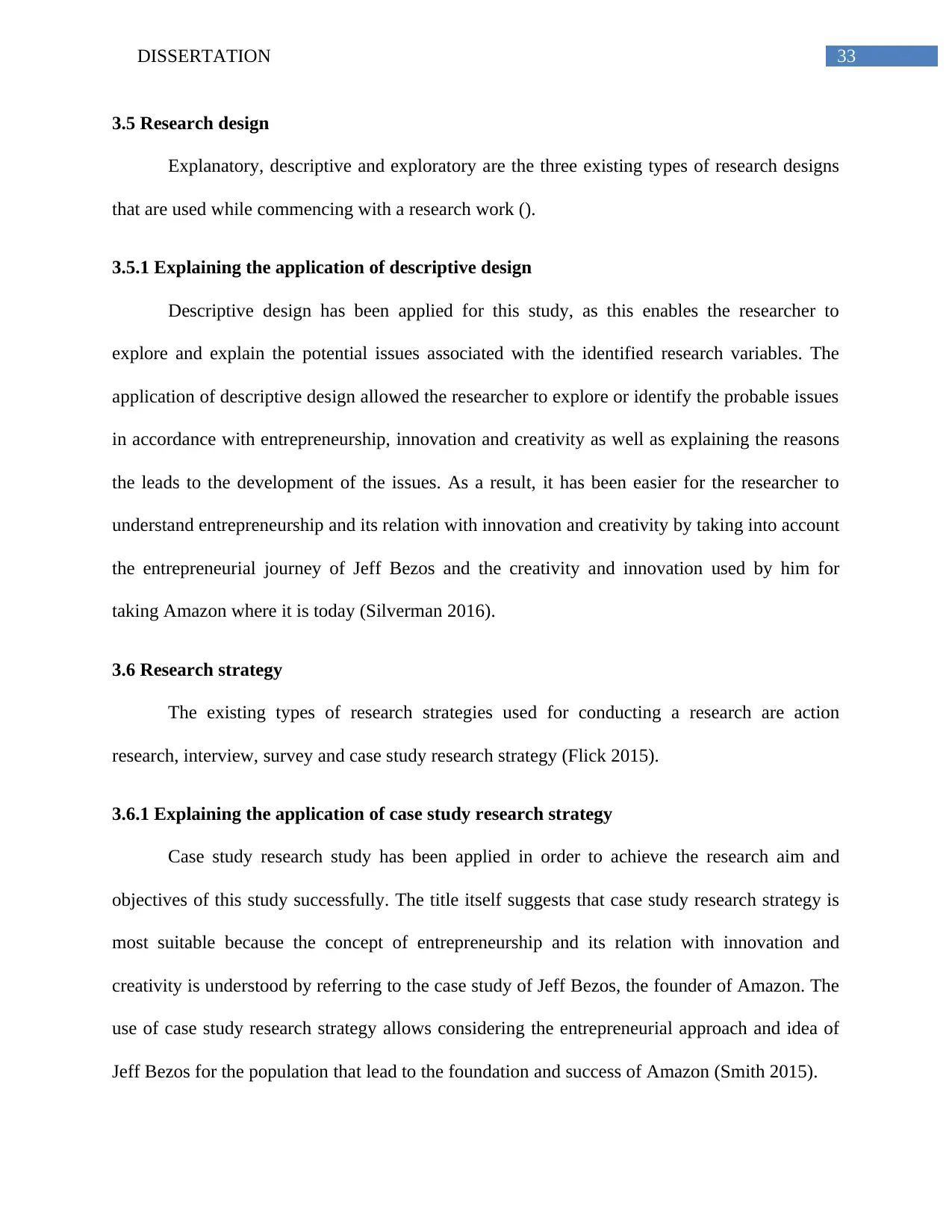
33DISSERTATION
3.5 Research design
Explanatory, descriptive and exploratory are the three existing types of research designs
that are used while commencing with a research work ().
3.5.1 Explaining the application of descriptive design
Descriptive design has been applied for this study, as this enables the researcher to
explore and explain the potential issues associated with the identified research variables. The
application of descriptive design allowed the researcher to explore or identify the probable issues
in accordance with entrepreneurship, innovation and creativity as well as explaining the reasons
the leads to the development of the issues. As a result, it has been easier for the researcher to
understand entrepreneurship and its relation with innovation and creativity by taking into account
the entrepreneurial journey of Jeff Bezos and the creativity and innovation used by him for
taking Amazon where it is today (Silverman 2016).
3.6 Research strategy
The existing types of research strategies used for conducting a research are action
research, interview, survey and case study research strategy (Flick 2015).
3.6.1 Explaining the application of case study research strategy
Case study research study has been applied in order to achieve the research aim and
objectives of this study successfully. The title itself suggests that case study research strategy is
most suitable because the concept of entrepreneurship and its relation with innovation and
creativity is understood by referring to the case study of Jeff Bezos, the founder of Amazon. The
use of case study research strategy allows considering the entrepreneurial approach and idea of
Jeff Bezos for the population that lead to the foundation and success of Amazon (Smith 2015).
3.5 Research design
Explanatory, descriptive and exploratory are the three existing types of research designs
that are used while commencing with a research work ().
3.5.1 Explaining the application of descriptive design
Descriptive design has been applied for this study, as this enables the researcher to
explore and explain the potential issues associated with the identified research variables. The
application of descriptive design allowed the researcher to explore or identify the probable issues
in accordance with entrepreneurship, innovation and creativity as well as explaining the reasons
the leads to the development of the issues. As a result, it has been easier for the researcher to
understand entrepreneurship and its relation with innovation and creativity by taking into account
the entrepreneurial journey of Jeff Bezos and the creativity and innovation used by him for
taking Amazon where it is today (Silverman 2016).
3.6 Research strategy
The existing types of research strategies used for conducting a research are action
research, interview, survey and case study research strategy (Flick 2015).
3.6.1 Explaining the application of case study research strategy
Case study research study has been applied in order to achieve the research aim and
objectives of this study successfully. The title itself suggests that case study research strategy is
most suitable because the concept of entrepreneurship and its relation with innovation and
creativity is understood by referring to the case study of Jeff Bezos, the founder of Amazon. The
use of case study research strategy allows considering the entrepreneurial approach and idea of
Jeff Bezos for the population that lead to the foundation and success of Amazon (Smith 2015).
Secure Best Marks with AI Grader
Need help grading? Try our AI Grader for instant feedback on your assignments.

34DISSERTATION
3.7 Data collection process
The only two data collection processes are primary and secondary processes (Bresler and
Stake 2017).
3.7.1 Explaining the application of secondary data collection process
Taking into account the research aim, secondary data collected process has been applied.
The application of secondary data collection process allowed the use of different secondary
sources such as books, journals, articles and online platforms. As a result, the researcher has
been able to refer to the case study of Amazon as well as information regarding entrepreneurship,
innovation and creativity from different yet authentic secondary sources (Bauer 2014).
3.8 Data analysis technique
Qualitative and quantitative are the only two data analysis techniques that can be used
while a research is being conducted (Choy 2014).
3.8.1 Explaining the application of thematic data analysis technique
Qualitative data analysis technique has been applied because this enabled the researcher
to maintain the quality of the research by analysing the different themes developed in accordance
with the research aim. The use of thematic analysis allowed the researcher to break down and
formulate different themes about entrepreneurship and its relation to creativity and innovation
and analysing them by referring and explaining the relevant information form secondary sources.
3.9 Ethical considerations
Maintaining the ethics of the research while data collection and analysis is of utmost
significance and the ethical considerations are mentioned below:
3.7 Data collection process
The only two data collection processes are primary and secondary processes (Bresler and
Stake 2017).
3.7.1 Explaining the application of secondary data collection process
Taking into account the research aim, secondary data collected process has been applied.
The application of secondary data collection process allowed the use of different secondary
sources such as books, journals, articles and online platforms. As a result, the researcher has
been able to refer to the case study of Amazon as well as information regarding entrepreneurship,
innovation and creativity from different yet authentic secondary sources (Bauer 2014).
3.8 Data analysis technique
Qualitative and quantitative are the only two data analysis techniques that can be used
while a research is being conducted (Choy 2014).
3.8.1 Explaining the application of thematic data analysis technique
Qualitative data analysis technique has been applied because this enabled the researcher
to maintain the quality of the research by analysing the different themes developed in accordance
with the research aim. The use of thematic analysis allowed the researcher to break down and
formulate different themes about entrepreneurship and its relation to creativity and innovation
and analysing them by referring and explaining the relevant information form secondary sources.
3.9 Ethical considerations
Maintaining the ethics of the research while data collection and analysis is of utmost
significance and the ethical considerations are mentioned below:
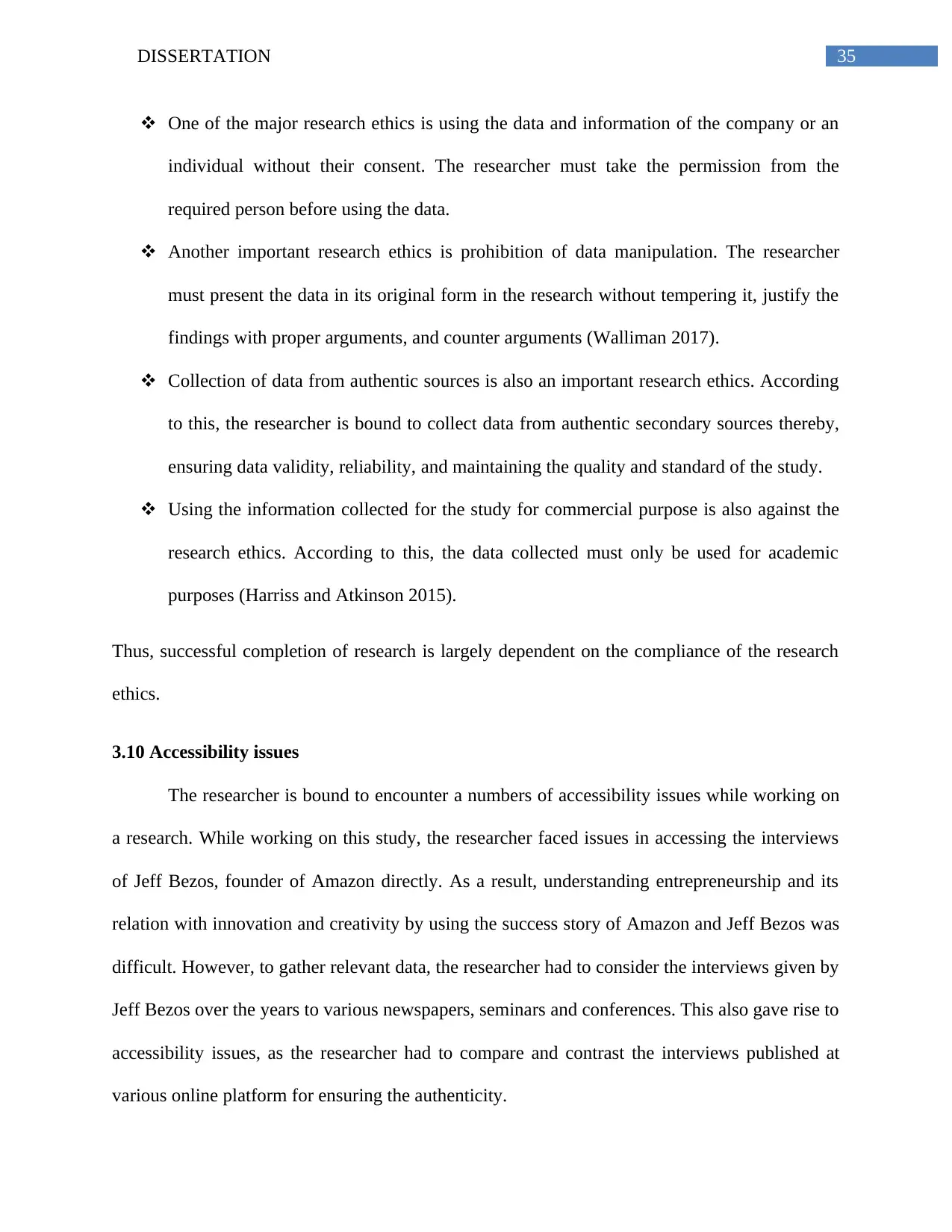
35DISSERTATION
One of the major research ethics is using the data and information of the company or an
individual without their consent. The researcher must take the permission from the
required person before using the data.
Another important research ethics is prohibition of data manipulation. The researcher
must present the data in its original form in the research without tempering it, justify the
findings with proper arguments, and counter arguments (Walliman 2017).
Collection of data from authentic sources is also an important research ethics. According
to this, the researcher is bound to collect data from authentic secondary sources thereby,
ensuring data validity, reliability, and maintaining the quality and standard of the study.
Using the information collected for the study for commercial purpose is also against the
research ethics. According to this, the data collected must only be used for academic
purposes (Harriss and Atkinson 2015).
Thus, successful completion of research is largely dependent on the compliance of the research
ethics.
3.10 Accessibility issues
The researcher is bound to encounter a numbers of accessibility issues while working on
a research. While working on this study, the researcher faced issues in accessing the interviews
of Jeff Bezos, founder of Amazon directly. As a result, understanding entrepreneurship and its
relation with innovation and creativity by using the success story of Amazon and Jeff Bezos was
difficult. However, to gather relevant data, the researcher had to consider the interviews given by
Jeff Bezos over the years to various newspapers, seminars and conferences. This also gave rise to
accessibility issues, as the researcher had to compare and contrast the interviews published at
various online platform for ensuring the authenticity.
One of the major research ethics is using the data and information of the company or an
individual without their consent. The researcher must take the permission from the
required person before using the data.
Another important research ethics is prohibition of data manipulation. The researcher
must present the data in its original form in the research without tempering it, justify the
findings with proper arguments, and counter arguments (Walliman 2017).
Collection of data from authentic sources is also an important research ethics. According
to this, the researcher is bound to collect data from authentic secondary sources thereby,
ensuring data validity, reliability, and maintaining the quality and standard of the study.
Using the information collected for the study for commercial purpose is also against the
research ethics. According to this, the data collected must only be used for academic
purposes (Harriss and Atkinson 2015).
Thus, successful completion of research is largely dependent on the compliance of the research
ethics.
3.10 Accessibility issues
The researcher is bound to encounter a numbers of accessibility issues while working on
a research. While working on this study, the researcher faced issues in accessing the interviews
of Jeff Bezos, founder of Amazon directly. As a result, understanding entrepreneurship and its
relation with innovation and creativity by using the success story of Amazon and Jeff Bezos was
difficult. However, to gather relevant data, the researcher had to consider the interviews given by
Jeff Bezos over the years to various newspapers, seminars and conferences. This also gave rise to
accessibility issues, as the researcher had to compare and contrast the interviews published at
various online platform for ensuring the authenticity.

36DISSERTATION
3.11 Research limitation
Both time and budget imposed major limitation while conducting the research. The
researcher was allocated limited budget for conducting the research due to which it gave rise rise
to difficulties accessing some valuable and relevant data related to the research topic, as it
required paying for accessing it. As a result, the researcher had to compromise and was unable to
the data for the research. In addition to, time was another research limitation, as the researcher
lacked adequate time for collecting and gathering significant data related to the research topic.
3.12 Time table
Main activities1st week6th week12th week18th week20th week24th week
Topic selection
Reviewing
literature
Developing
Research
methodology
Collection of
secondary data
Analysis and
interpretation of
data
Findings
Conclusion and
Recommendation
3.11 Research limitation
Both time and budget imposed major limitation while conducting the research. The
researcher was allocated limited budget for conducting the research due to which it gave rise rise
to difficulties accessing some valuable and relevant data related to the research topic, as it
required paying for accessing it. As a result, the researcher had to compromise and was unable to
the data for the research. In addition to, time was another research limitation, as the researcher
lacked adequate time for collecting and gathering significant data related to the research topic.
3.12 Time table
Main activities1st week6th week12th week18th week20th week24th week
Topic selection
Reviewing
literature
Developing
Research
methodology
Collection of
secondary data
Analysis and
interpretation of
data
Findings
Conclusion and
Recommendation
Paraphrase This Document
Need a fresh take? Get an instant paraphrase of this document with our AI Paraphraser
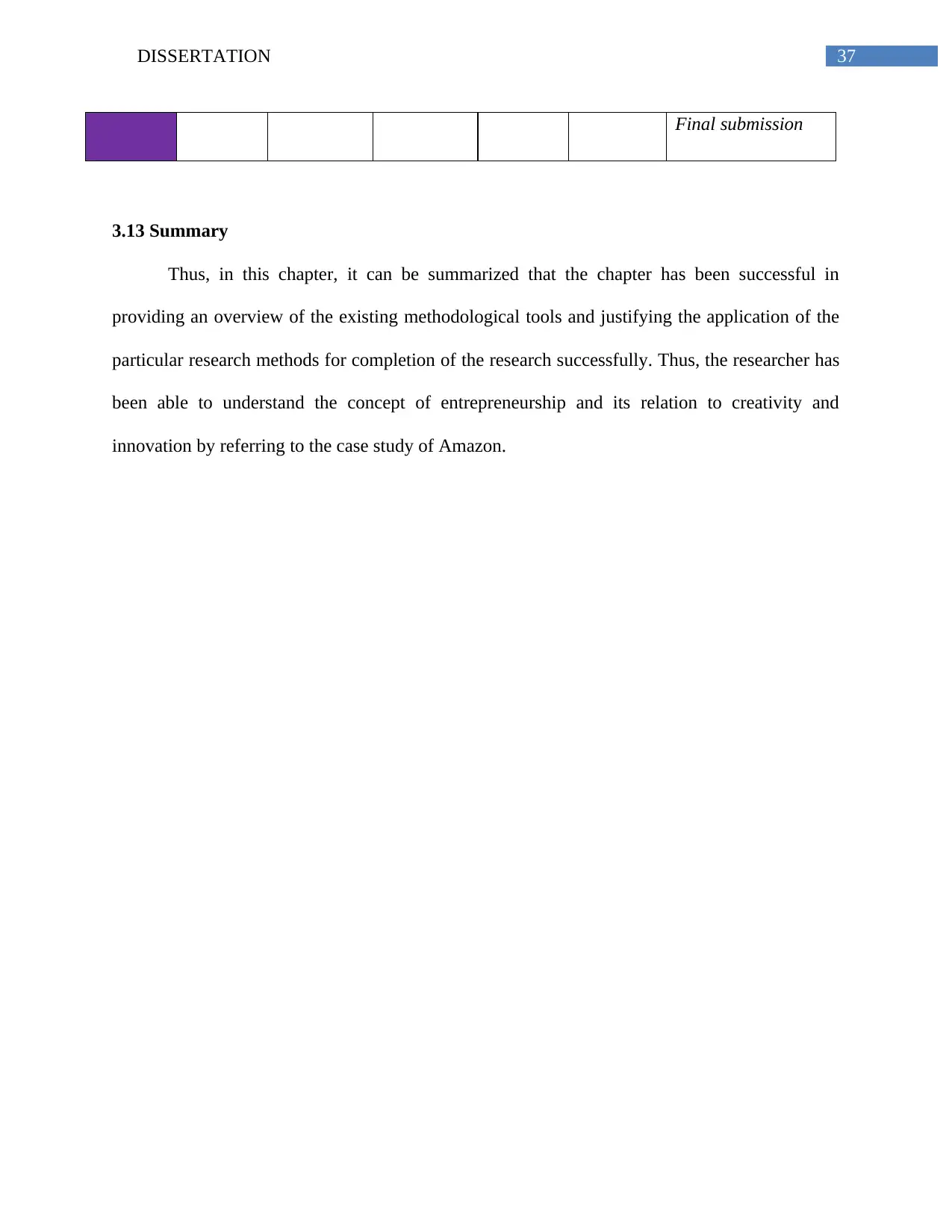
37DISSERTATION
Final submission
3.13 Summary
Thus, in this chapter, it can be summarized that the chapter has been successful in
providing an overview of the existing methodological tools and justifying the application of the
particular research methods for completion of the research successfully. Thus, the researcher has
been able to understand the concept of entrepreneurship and its relation to creativity and
innovation by referring to the case study of Amazon.
Final submission
3.13 Summary
Thus, in this chapter, it can be summarized that the chapter has been successful in
providing an overview of the existing methodological tools and justifying the application of the
particular research methods for completion of the research successfully. Thus, the researcher has
been able to understand the concept of entrepreneurship and its relation to creativity and
innovation by referring to the case study of Amazon.

38DISSERTATION
Chapter 4: Data analysis
4.0 Overview
This chapter analyzes the data from various secondary resources such as newspaper
articles and online forum that highlights interview from Jeff Bezos on entrepreneurship,
innovation and creativity. The success story of Amazon is analyzed, investigated and studied for
understanding the relationship between entrepreneurship and leadership and creativity. In order
to do so, various themes are developed by taking into account the research objectives and the
literature review. The entrepreneurial approach, innovation and disruptive leadership followed by
Jeff Bezos is studied for referring to the success of Amazon and understanding the relationship
between entrepreneurship and creativity and innovation.
4.1 Thematic analysis
Theme 1: Creativity and innovation of Amazon
Amazon was termed as the world’s most innovative company of 2017. The Amazon CEO
says that the loyal customer base and believe that the customers have on the company is what
acts as a super-motivation for the founder. Over the past 22 years, Amazon has not confined
them to one sector but has moved from one sector to another even by tearing down the existing
structures of the company. For example, the Echo smart speaker of Amazon rose up to the
occasion while some products fail to meet the expectation. Other successful innovation and
creativity of Amazon includes Amazon Music Unlimited, Amazon MP3 as well as Amazon’s
venture to the fashion industry. Amazon has won Amazon Studios’ Emmy Award for original
TV shows that was established based on a crowd sourcing platform introduced by the company
in 2010. Reports suggest that Amazon is the second largest apparel seller in the US that further
Chapter 4: Data analysis
4.0 Overview
This chapter analyzes the data from various secondary resources such as newspaper
articles and online forum that highlights interview from Jeff Bezos on entrepreneurship,
innovation and creativity. The success story of Amazon is analyzed, investigated and studied for
understanding the relationship between entrepreneurship and leadership and creativity. In order
to do so, various themes are developed by taking into account the research objectives and the
literature review. The entrepreneurial approach, innovation and disruptive leadership followed by
Jeff Bezos is studied for referring to the success of Amazon and understanding the relationship
between entrepreneurship and creativity and innovation.
4.1 Thematic analysis
Theme 1: Creativity and innovation of Amazon
Amazon was termed as the world’s most innovative company of 2017. The Amazon CEO
says that the loyal customer base and believe that the customers have on the company is what
acts as a super-motivation for the founder. Over the past 22 years, Amazon has not confined
them to one sector but has moved from one sector to another even by tearing down the existing
structures of the company. For example, the Echo smart speaker of Amazon rose up to the
occasion while some products fail to meet the expectation. Other successful innovation and
creativity of Amazon includes Amazon Music Unlimited, Amazon MP3 as well as Amazon’s
venture to the fashion industry. Amazon has won Amazon Studios’ Emmy Award for original
TV shows that was established based on a crowd sourcing platform introduced by the company
in 2010. Reports suggest that Amazon is the second largest apparel seller in the US that further
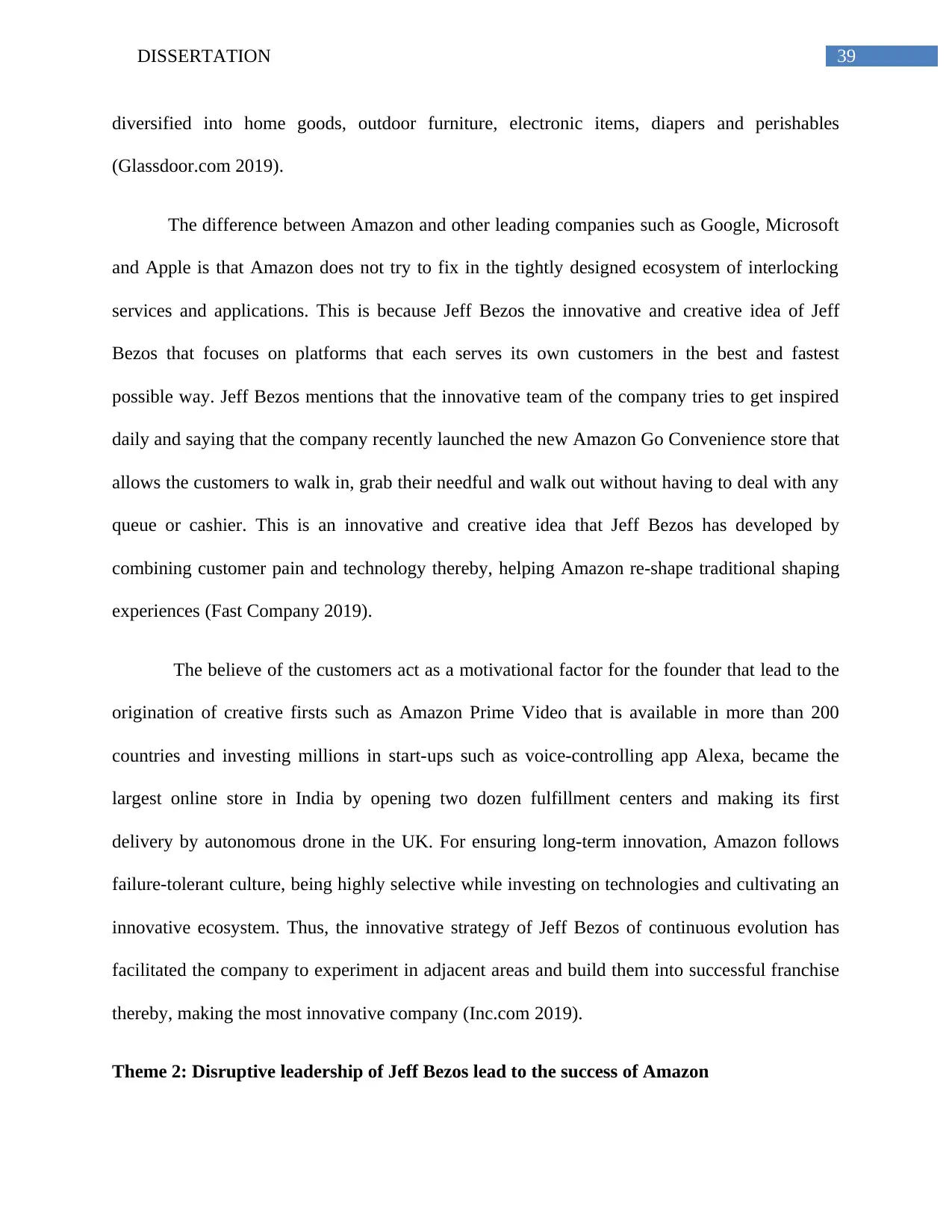
39DISSERTATION
diversified into home goods, outdoor furniture, electronic items, diapers and perishables
(Glassdoor.com 2019).
The difference between Amazon and other leading companies such as Google, Microsoft
and Apple is that Amazon does not try to fix in the tightly designed ecosystem of interlocking
services and applications. This is because Jeff Bezos the innovative and creative idea of Jeff
Bezos that focuses on platforms that each serves its own customers in the best and fastest
possible way. Jeff Bezos mentions that the innovative team of the company tries to get inspired
daily and saying that the company recently launched the new Amazon Go Convenience store that
allows the customers to walk in, grab their needful and walk out without having to deal with any
queue or cashier. This is an innovative and creative idea that Jeff Bezos has developed by
combining customer pain and technology thereby, helping Amazon re-shape traditional shaping
experiences (Fast Company 2019).
The believe of the customers act as a motivational factor for the founder that lead to the
origination of creative firsts such as Amazon Prime Video that is available in more than 200
countries and investing millions in start-ups such as voice-controlling app Alexa, became the
largest online store in India by opening two dozen fulfillment centers and making its first
delivery by autonomous drone in the UK. For ensuring long-term innovation, Amazon follows
failure-tolerant culture, being highly selective while investing on technologies and cultivating an
innovative ecosystem. Thus, the innovative strategy of Jeff Bezos of continuous evolution has
facilitated the company to experiment in adjacent areas and build them into successful franchise
thereby, making the most innovative company (Inc.com 2019).
Theme 2: Disruptive leadership of Jeff Bezos lead to the success of Amazon
diversified into home goods, outdoor furniture, electronic items, diapers and perishables
(Glassdoor.com 2019).
The difference between Amazon and other leading companies such as Google, Microsoft
and Apple is that Amazon does not try to fix in the tightly designed ecosystem of interlocking
services and applications. This is because Jeff Bezos the innovative and creative idea of Jeff
Bezos that focuses on platforms that each serves its own customers in the best and fastest
possible way. Jeff Bezos mentions that the innovative team of the company tries to get inspired
daily and saying that the company recently launched the new Amazon Go Convenience store that
allows the customers to walk in, grab their needful and walk out without having to deal with any
queue or cashier. This is an innovative and creative idea that Jeff Bezos has developed by
combining customer pain and technology thereby, helping Amazon re-shape traditional shaping
experiences (Fast Company 2019).
The believe of the customers act as a motivational factor for the founder that lead to the
origination of creative firsts such as Amazon Prime Video that is available in more than 200
countries and investing millions in start-ups such as voice-controlling app Alexa, became the
largest online store in India by opening two dozen fulfillment centers and making its first
delivery by autonomous drone in the UK. For ensuring long-term innovation, Amazon follows
failure-tolerant culture, being highly selective while investing on technologies and cultivating an
innovative ecosystem. Thus, the innovative strategy of Jeff Bezos of continuous evolution has
facilitated the company to experiment in adjacent areas and build them into successful franchise
thereby, making the most innovative company (Inc.com 2019).
Theme 2: Disruptive leadership of Jeff Bezos lead to the success of Amazon
Secure Best Marks with AI Grader
Need help grading? Try our AI Grader for instant feedback on your assignments.
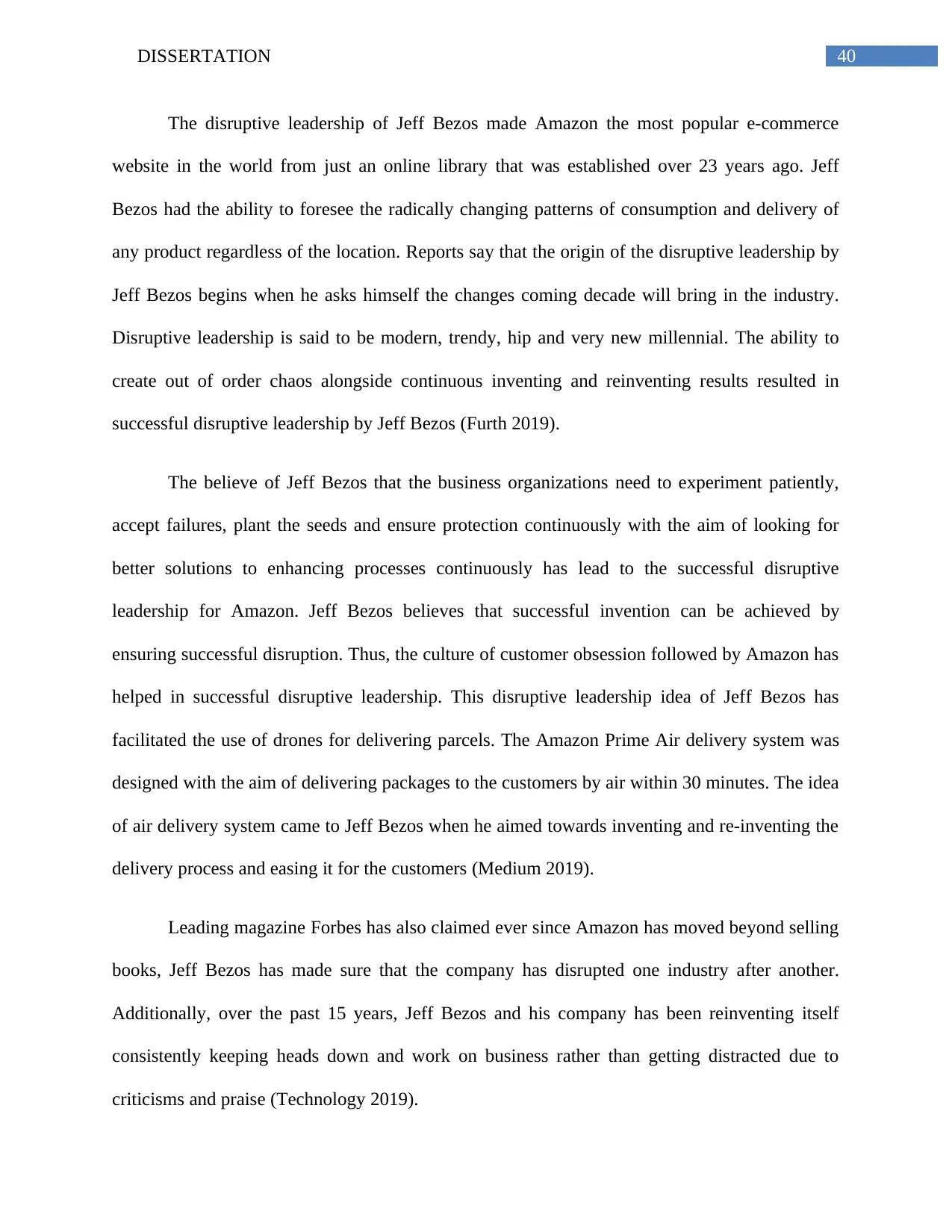
40DISSERTATION
The disruptive leadership of Jeff Bezos made Amazon the most popular e-commerce
website in the world from just an online library that was established over 23 years ago. Jeff
Bezos had the ability to foresee the radically changing patterns of consumption and delivery of
any product regardless of the location. Reports say that the origin of the disruptive leadership by
Jeff Bezos begins when he asks himself the changes coming decade will bring in the industry.
Disruptive leadership is said to be modern, trendy, hip and very new millennial. The ability to
create out of order chaos alongside continuous inventing and reinventing results resulted in
successful disruptive leadership by Jeff Bezos (Furth 2019).
The believe of Jeff Bezos that the business organizations need to experiment patiently,
accept failures, plant the seeds and ensure protection continuously with the aim of looking for
better solutions to enhancing processes continuously has lead to the successful disruptive
leadership for Amazon. Jeff Bezos believes that successful invention can be achieved by
ensuring successful disruption. Thus, the culture of customer obsession followed by Amazon has
helped in successful disruptive leadership. This disruptive leadership idea of Jeff Bezos has
facilitated the use of drones for delivering parcels. The Amazon Prime Air delivery system was
designed with the aim of delivering packages to the customers by air within 30 minutes. The idea
of air delivery system came to Jeff Bezos when he aimed towards inventing and re-inventing the
delivery process and easing it for the customers (Medium 2019).
Leading magazine Forbes has also claimed ever since Amazon has moved beyond selling
books, Jeff Bezos has made sure that the company has disrupted one industry after another.
Additionally, over the past 15 years, Jeff Bezos and his company has been reinventing itself
consistently keeping heads down and work on business rather than getting distracted due to
criticisms and praise (Technology 2019).
The disruptive leadership of Jeff Bezos made Amazon the most popular e-commerce
website in the world from just an online library that was established over 23 years ago. Jeff
Bezos had the ability to foresee the radically changing patterns of consumption and delivery of
any product regardless of the location. Reports say that the origin of the disruptive leadership by
Jeff Bezos begins when he asks himself the changes coming decade will bring in the industry.
Disruptive leadership is said to be modern, trendy, hip and very new millennial. The ability to
create out of order chaos alongside continuous inventing and reinventing results resulted in
successful disruptive leadership by Jeff Bezos (Furth 2019).
The believe of Jeff Bezos that the business organizations need to experiment patiently,
accept failures, plant the seeds and ensure protection continuously with the aim of looking for
better solutions to enhancing processes continuously has lead to the successful disruptive
leadership for Amazon. Jeff Bezos believes that successful invention can be achieved by
ensuring successful disruption. Thus, the culture of customer obsession followed by Amazon has
helped in successful disruptive leadership. This disruptive leadership idea of Jeff Bezos has
facilitated the use of drones for delivering parcels. The Amazon Prime Air delivery system was
designed with the aim of delivering packages to the customers by air within 30 minutes. The idea
of air delivery system came to Jeff Bezos when he aimed towards inventing and re-inventing the
delivery process and easing it for the customers (Medium 2019).
Leading magazine Forbes has also claimed ever since Amazon has moved beyond selling
books, Jeff Bezos has made sure that the company has disrupted one industry after another.
Additionally, over the past 15 years, Jeff Bezos and his company has been reinventing itself
consistently keeping heads down and work on business rather than getting distracted due to
criticisms and praise (Technology 2019).
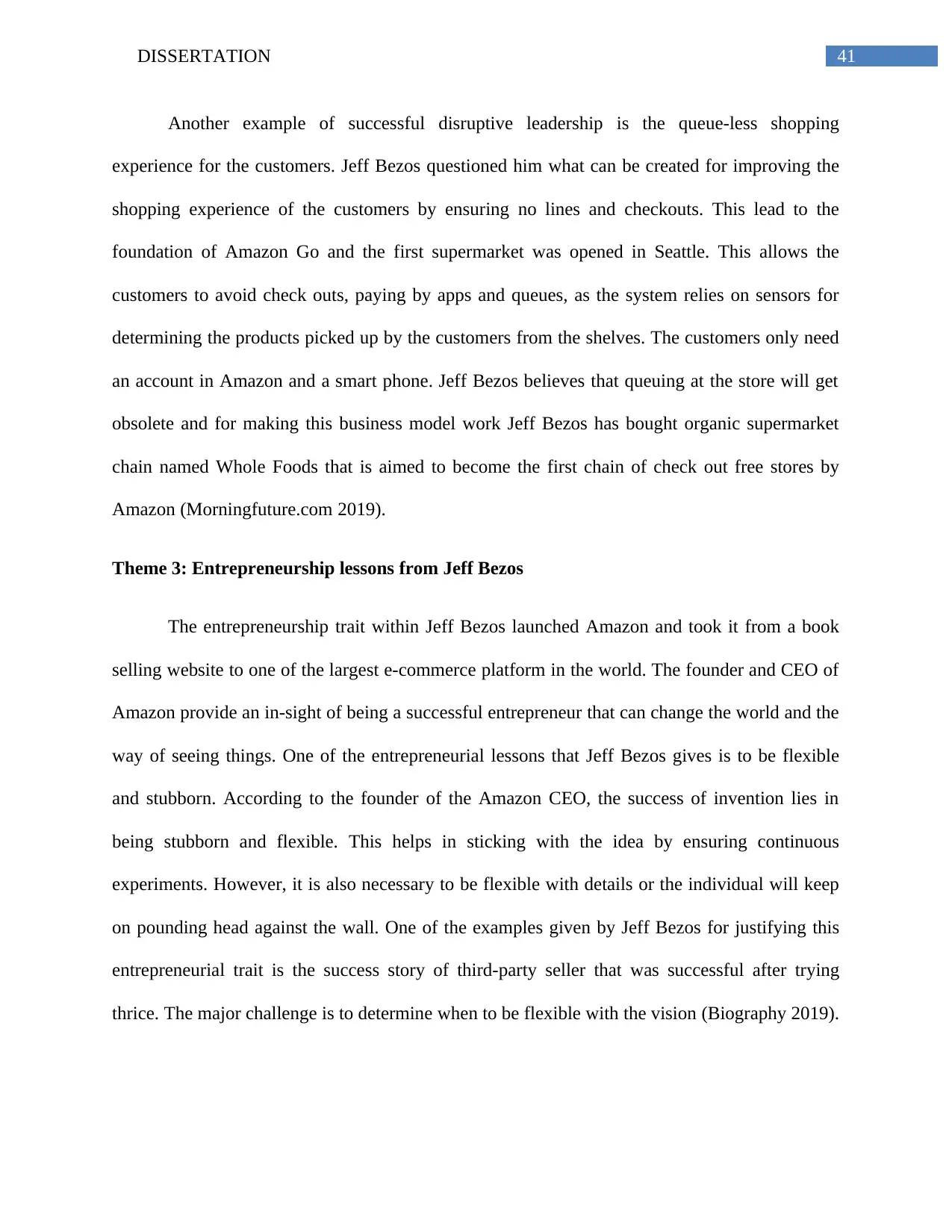
41DISSERTATION
Another example of successful disruptive leadership is the queue-less shopping
experience for the customers. Jeff Bezos questioned him what can be created for improving the
shopping experience of the customers by ensuring no lines and checkouts. This lead to the
foundation of Amazon Go and the first supermarket was opened in Seattle. This allows the
customers to avoid check outs, paying by apps and queues, as the system relies on sensors for
determining the products picked up by the customers from the shelves. The customers only need
an account in Amazon and a smart phone. Jeff Bezos believes that queuing at the store will get
obsolete and for making this business model work Jeff Bezos has bought organic supermarket
chain named Whole Foods that is aimed to become the first chain of check out free stores by
Amazon (Morningfuture.com 2019).
Theme 3: Entrepreneurship lessons from Jeff Bezos
The entrepreneurship trait within Jeff Bezos launched Amazon and took it from a book
selling website to one of the largest e-commerce platform in the world. The founder and CEO of
Amazon provide an in-sight of being a successful entrepreneur that can change the world and the
way of seeing things. One of the entrepreneurial lessons that Jeff Bezos gives is to be flexible
and stubborn. According to the founder of the Amazon CEO, the success of invention lies in
being stubborn and flexible. This helps in sticking with the idea by ensuring continuous
experiments. However, it is also necessary to be flexible with details or the individual will keep
on pounding head against the wall. One of the examples given by Jeff Bezos for justifying this
entrepreneurial trait is the success story of third-party seller that was successful after trying
thrice. The major challenge is to determine when to be flexible with the vision (Biography 2019).
Another example of successful disruptive leadership is the queue-less shopping
experience for the customers. Jeff Bezos questioned him what can be created for improving the
shopping experience of the customers by ensuring no lines and checkouts. This lead to the
foundation of Amazon Go and the first supermarket was opened in Seattle. This allows the
customers to avoid check outs, paying by apps and queues, as the system relies on sensors for
determining the products picked up by the customers from the shelves. The customers only need
an account in Amazon and a smart phone. Jeff Bezos believes that queuing at the store will get
obsolete and for making this business model work Jeff Bezos has bought organic supermarket
chain named Whole Foods that is aimed to become the first chain of check out free stores by
Amazon (Morningfuture.com 2019).
Theme 3: Entrepreneurship lessons from Jeff Bezos
The entrepreneurship trait within Jeff Bezos launched Amazon and took it from a book
selling website to one of the largest e-commerce platform in the world. The founder and CEO of
Amazon provide an in-sight of being a successful entrepreneur that can change the world and the
way of seeing things. One of the entrepreneurial lessons that Jeff Bezos gives is to be flexible
and stubborn. According to the founder of the Amazon CEO, the success of invention lies in
being stubborn and flexible. This helps in sticking with the idea by ensuring continuous
experiments. However, it is also necessary to be flexible with details or the individual will keep
on pounding head against the wall. One of the examples given by Jeff Bezos for justifying this
entrepreneurial trait is the success story of third-party seller that was successful after trying
thrice. The major challenge is to determine when to be flexible with the vision (Biography 2019).
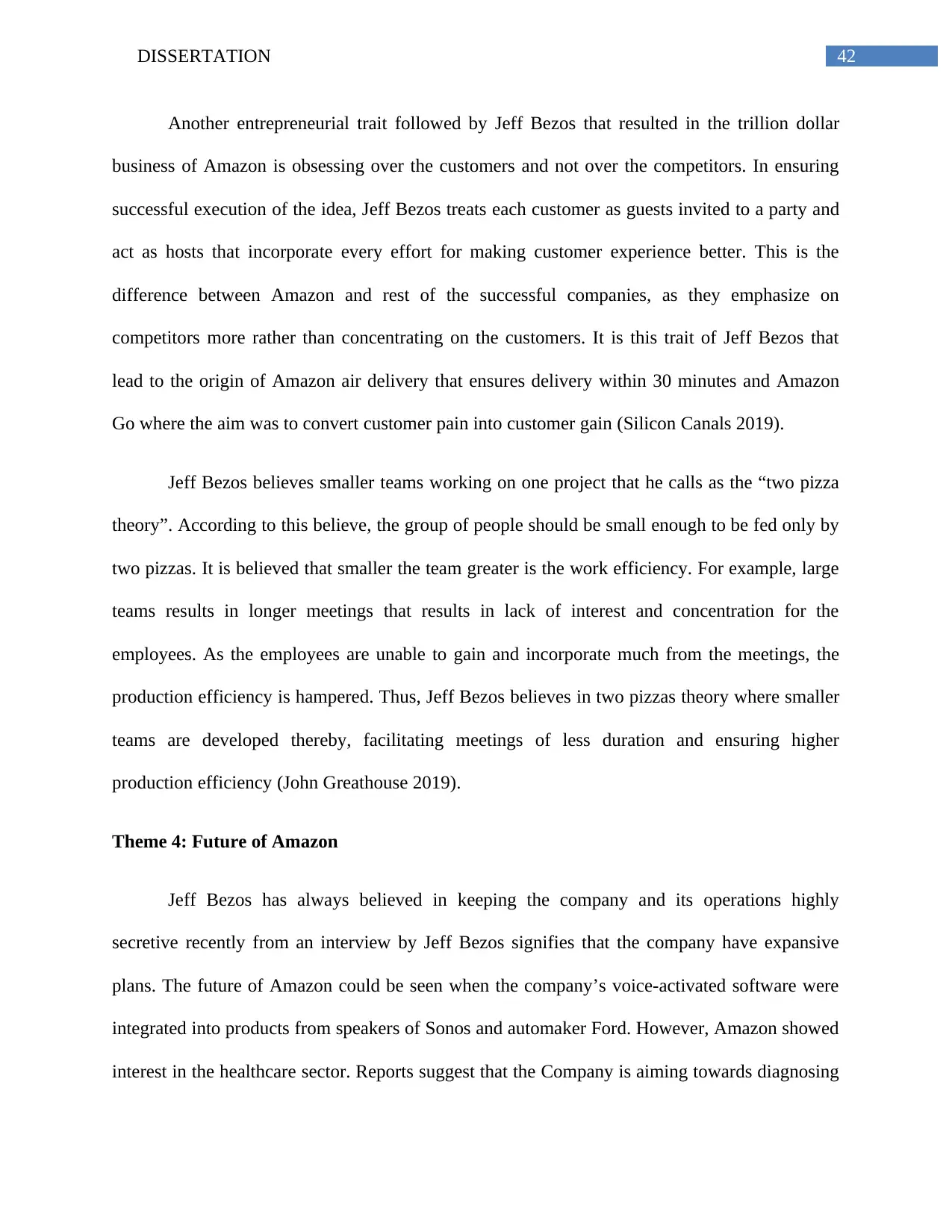
42DISSERTATION
Another entrepreneurial trait followed by Jeff Bezos that resulted in the trillion dollar
business of Amazon is obsessing over the customers and not over the competitors. In ensuring
successful execution of the idea, Jeff Bezos treats each customer as guests invited to a party and
act as hosts that incorporate every effort for making customer experience better. This is the
difference between Amazon and rest of the successful companies, as they emphasize on
competitors more rather than concentrating on the customers. It is this trait of Jeff Bezos that
lead to the origin of Amazon air delivery that ensures delivery within 30 minutes and Amazon
Go where the aim was to convert customer pain into customer gain (Silicon Canals 2019).
Jeff Bezos believes smaller teams working on one project that he calls as the “two pizza
theory”. According to this believe, the group of people should be small enough to be fed only by
two pizzas. It is believed that smaller the team greater is the work efficiency. For example, large
teams results in longer meetings that results in lack of interest and concentration for the
employees. As the employees are unable to gain and incorporate much from the meetings, the
production efficiency is hampered. Thus, Jeff Bezos believes in two pizzas theory where smaller
teams are developed thereby, facilitating meetings of less duration and ensuring higher
production efficiency (John Greathouse 2019).
Theme 4: Future of Amazon
Jeff Bezos has always believed in keeping the company and its operations highly
secretive recently from an interview by Jeff Bezos signifies that the company have expansive
plans. The future of Amazon could be seen when the company’s voice-activated software were
integrated into products from speakers of Sonos and automaker Ford. However, Amazon showed
interest in the healthcare sector. Reports suggest that the Company is aiming towards diagnosing
Another entrepreneurial trait followed by Jeff Bezos that resulted in the trillion dollar
business of Amazon is obsessing over the customers and not over the competitors. In ensuring
successful execution of the idea, Jeff Bezos treats each customer as guests invited to a party and
act as hosts that incorporate every effort for making customer experience better. This is the
difference between Amazon and rest of the successful companies, as they emphasize on
competitors more rather than concentrating on the customers. It is this trait of Jeff Bezos that
lead to the origin of Amazon air delivery that ensures delivery within 30 minutes and Amazon
Go where the aim was to convert customer pain into customer gain (Silicon Canals 2019).
Jeff Bezos believes smaller teams working on one project that he calls as the “two pizza
theory”. According to this believe, the group of people should be small enough to be fed only by
two pizzas. It is believed that smaller the team greater is the work efficiency. For example, large
teams results in longer meetings that results in lack of interest and concentration for the
employees. As the employees are unable to gain and incorporate much from the meetings, the
production efficiency is hampered. Thus, Jeff Bezos believes in two pizzas theory where smaller
teams are developed thereby, facilitating meetings of less duration and ensuring higher
production efficiency (John Greathouse 2019).
Theme 4: Future of Amazon
Jeff Bezos has always believed in keeping the company and its operations highly
secretive recently from an interview by Jeff Bezos signifies that the company have expansive
plans. The future of Amazon could be seen when the company’s voice-activated software were
integrated into products from speakers of Sonos and automaker Ford. However, Amazon showed
interest in the healthcare sector. Reports suggest that the Company is aiming towards diagnosing
Paraphrase This Document
Need a fresh take? Get an instant paraphrase of this document with our AI Paraphraser

43DISSERTATION
physical and mental health from voice recordings as well as selling clothes of Seismic, clothing
brand that offers greater mobility. The company has already taken its steps into healthcare and
aim towards innovating lot of areas from subsidizing healthy food to pharmacy (The Verge
2019).
Amazon has partnered with J.P Morgan and Berkshire Hathaway for an employer health
program. The first internet foray has been been initiated by the company by taking over internet
pharmacy start-up, PillPack. The company has also applied for patent for its Alexa, the voice
software for diagnosing cough and cold. The company also aims towards venturing to medical
diagnostics for at-home testing and employee health clinic in the future.
Figure 3: Amazon’s Vision of Healthcare
(Source: Snow 2019)
physical and mental health from voice recordings as well as selling clothes of Seismic, clothing
brand that offers greater mobility. The company has already taken its steps into healthcare and
aim towards innovating lot of areas from subsidizing healthy food to pharmacy (The Verge
2019).
Amazon has partnered with J.P Morgan and Berkshire Hathaway for an employer health
program. The first internet foray has been been initiated by the company by taking over internet
pharmacy start-up, PillPack. The company has also applied for patent for its Alexa, the voice
software for diagnosing cough and cold. The company also aims towards venturing to medical
diagnostics for at-home testing and employee health clinic in the future.
Figure 3: Amazon’s Vision of Healthcare
(Source: Snow 2019)
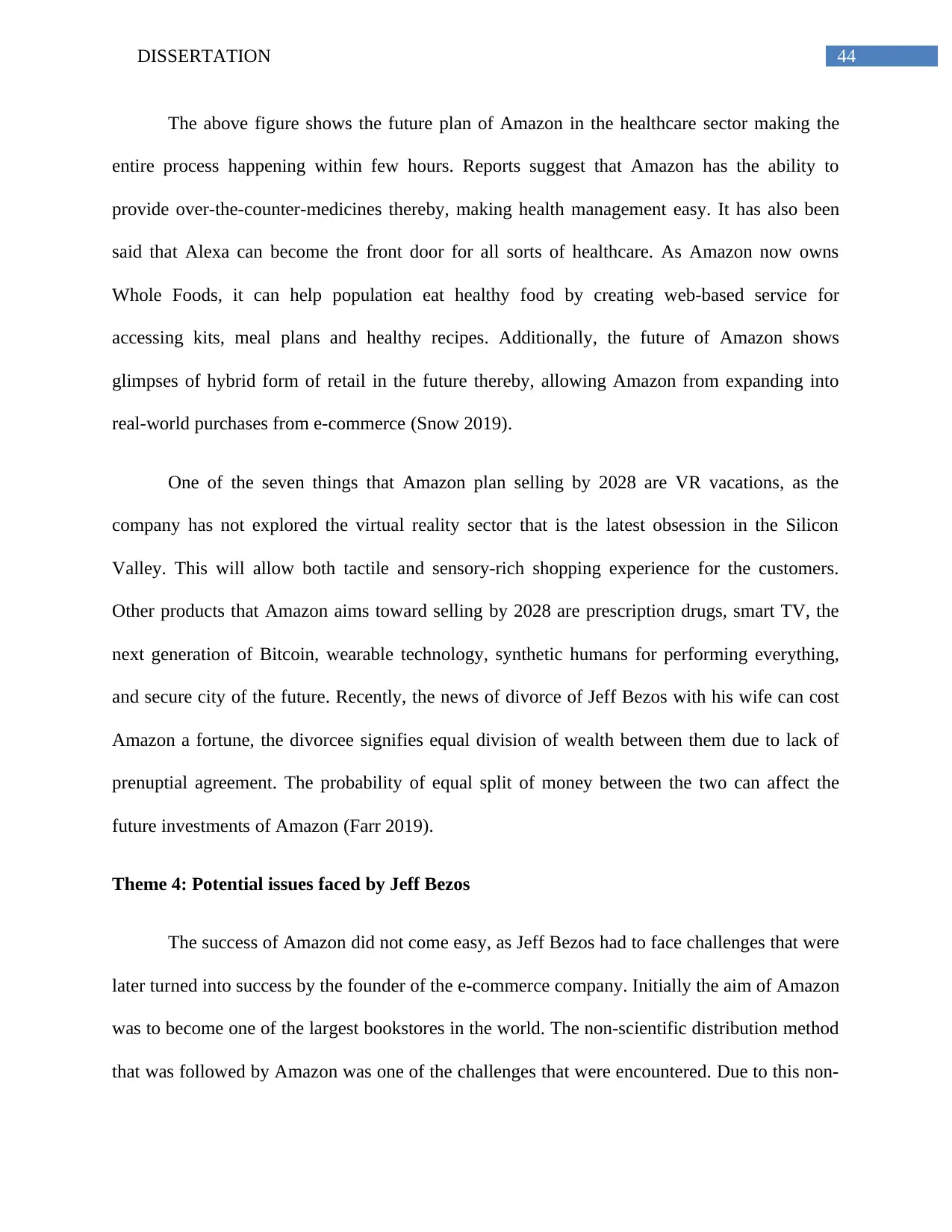
44DISSERTATION
The above figure shows the future plan of Amazon in the healthcare sector making the
entire process happening within few hours. Reports suggest that Amazon has the ability to
provide over-the-counter-medicines thereby, making health management easy. It has also been
said that Alexa can become the front door for all sorts of healthcare. As Amazon now owns
Whole Foods, it can help population eat healthy food by creating web-based service for
accessing kits, meal plans and healthy recipes. Additionally, the future of Amazon shows
glimpses of hybrid form of retail in the future thereby, allowing Amazon from expanding into
real-world purchases from e-commerce (Snow 2019).
One of the seven things that Amazon plan selling by 2028 are VR vacations, as the
company has not explored the virtual reality sector that is the latest obsession in the Silicon
Valley. This will allow both tactile and sensory-rich shopping experience for the customers.
Other products that Amazon aims toward selling by 2028 are prescription drugs, smart TV, the
next generation of Bitcoin, wearable technology, synthetic humans for performing everything,
and secure city of the future. Recently, the news of divorce of Jeff Bezos with his wife can cost
Amazon a fortune, the divorcee signifies equal division of wealth between them due to lack of
prenuptial agreement. The probability of equal split of money between the two can affect the
future investments of Amazon (Farr 2019).
Theme 4: Potential issues faced by Jeff Bezos
The success of Amazon did not come easy, as Jeff Bezos had to face challenges that were
later turned into success by the founder of the e-commerce company. Initially the aim of Amazon
was to become one of the largest bookstores in the world. The non-scientific distribution method
that was followed by Amazon was one of the challenges that were encountered. Due to this non-
The above figure shows the future plan of Amazon in the healthcare sector making the
entire process happening within few hours. Reports suggest that Amazon has the ability to
provide over-the-counter-medicines thereby, making health management easy. It has also been
said that Alexa can become the front door for all sorts of healthcare. As Amazon now owns
Whole Foods, it can help population eat healthy food by creating web-based service for
accessing kits, meal plans and healthy recipes. Additionally, the future of Amazon shows
glimpses of hybrid form of retail in the future thereby, allowing Amazon from expanding into
real-world purchases from e-commerce (Snow 2019).
One of the seven things that Amazon plan selling by 2028 are VR vacations, as the
company has not explored the virtual reality sector that is the latest obsession in the Silicon
Valley. This will allow both tactile and sensory-rich shopping experience for the customers.
Other products that Amazon aims toward selling by 2028 are prescription drugs, smart TV, the
next generation of Bitcoin, wearable technology, synthetic humans for performing everything,
and secure city of the future. Recently, the news of divorce of Jeff Bezos with his wife can cost
Amazon a fortune, the divorcee signifies equal division of wealth between them due to lack of
prenuptial agreement. The probability of equal split of money between the two can affect the
future investments of Amazon (Farr 2019).
Theme 4: Potential issues faced by Jeff Bezos
The success of Amazon did not come easy, as Jeff Bezos had to face challenges that were
later turned into success by the founder of the e-commerce company. Initially the aim of Amazon
was to become one of the largest bookstores in the world. The non-scientific distribution method
that was followed by Amazon was one of the challenges that were encountered. Due to this non-
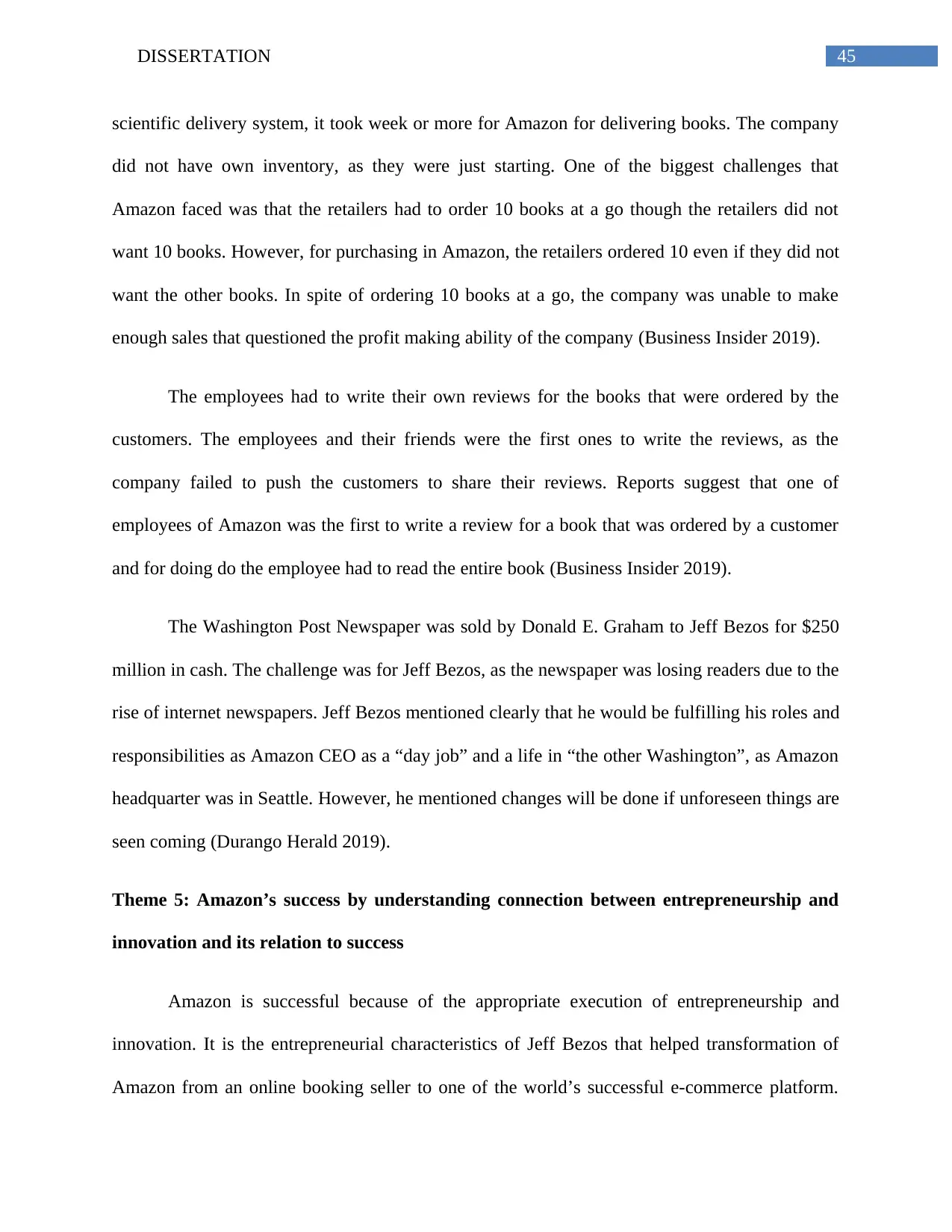
45DISSERTATION
scientific delivery system, it took week or more for Amazon for delivering books. The company
did not have own inventory, as they were just starting. One of the biggest challenges that
Amazon faced was that the retailers had to order 10 books at a go though the retailers did not
want 10 books. However, for purchasing in Amazon, the retailers ordered 10 even if they did not
want the other books. In spite of ordering 10 books at a go, the company was unable to make
enough sales that questioned the profit making ability of the company (Business Insider 2019).
The employees had to write their own reviews for the books that were ordered by the
customers. The employees and their friends were the first ones to write the reviews, as the
company failed to push the customers to share their reviews. Reports suggest that one of
employees of Amazon was the first to write a review for a book that was ordered by a customer
and for doing do the employee had to read the entire book (Business Insider 2019).
The Washington Post Newspaper was sold by Donald E. Graham to Jeff Bezos for $250
million in cash. The challenge was for Jeff Bezos, as the newspaper was losing readers due to the
rise of internet newspapers. Jeff Bezos mentioned clearly that he would be fulfilling his roles and
responsibilities as Amazon CEO as a “day job” and a life in “the other Washington”, as Amazon
headquarter was in Seattle. However, he mentioned changes will be done if unforeseen things are
seen coming (Durango Herald 2019).
Theme 5: Amazon’s success by understanding connection between entrepreneurship and
innovation and its relation to success
Amazon is successful because of the appropriate execution of entrepreneurship and
innovation. It is the entrepreneurial characteristics of Jeff Bezos that helped transformation of
Amazon from an online booking seller to one of the world’s successful e-commerce platform.
scientific delivery system, it took week or more for Amazon for delivering books. The company
did not have own inventory, as they were just starting. One of the biggest challenges that
Amazon faced was that the retailers had to order 10 books at a go though the retailers did not
want 10 books. However, for purchasing in Amazon, the retailers ordered 10 even if they did not
want the other books. In spite of ordering 10 books at a go, the company was unable to make
enough sales that questioned the profit making ability of the company (Business Insider 2019).
The employees had to write their own reviews for the books that were ordered by the
customers. The employees and their friends were the first ones to write the reviews, as the
company failed to push the customers to share their reviews. Reports suggest that one of
employees of Amazon was the first to write a review for a book that was ordered by a customer
and for doing do the employee had to read the entire book (Business Insider 2019).
The Washington Post Newspaper was sold by Donald E. Graham to Jeff Bezos for $250
million in cash. The challenge was for Jeff Bezos, as the newspaper was losing readers due to the
rise of internet newspapers. Jeff Bezos mentioned clearly that he would be fulfilling his roles and
responsibilities as Amazon CEO as a “day job” and a life in “the other Washington”, as Amazon
headquarter was in Seattle. However, he mentioned changes will be done if unforeseen things are
seen coming (Durango Herald 2019).
Theme 5: Amazon’s success by understanding connection between entrepreneurship and
innovation and its relation to success
Amazon is successful because of the appropriate execution of entrepreneurship and
innovation. It is the entrepreneurial characteristics of Jeff Bezos that helped transformation of
Amazon from an online booking seller to one of the world’s successful e-commerce platform.
Secure Best Marks with AI Grader
Need help grading? Try our AI Grader for instant feedback on your assignments.
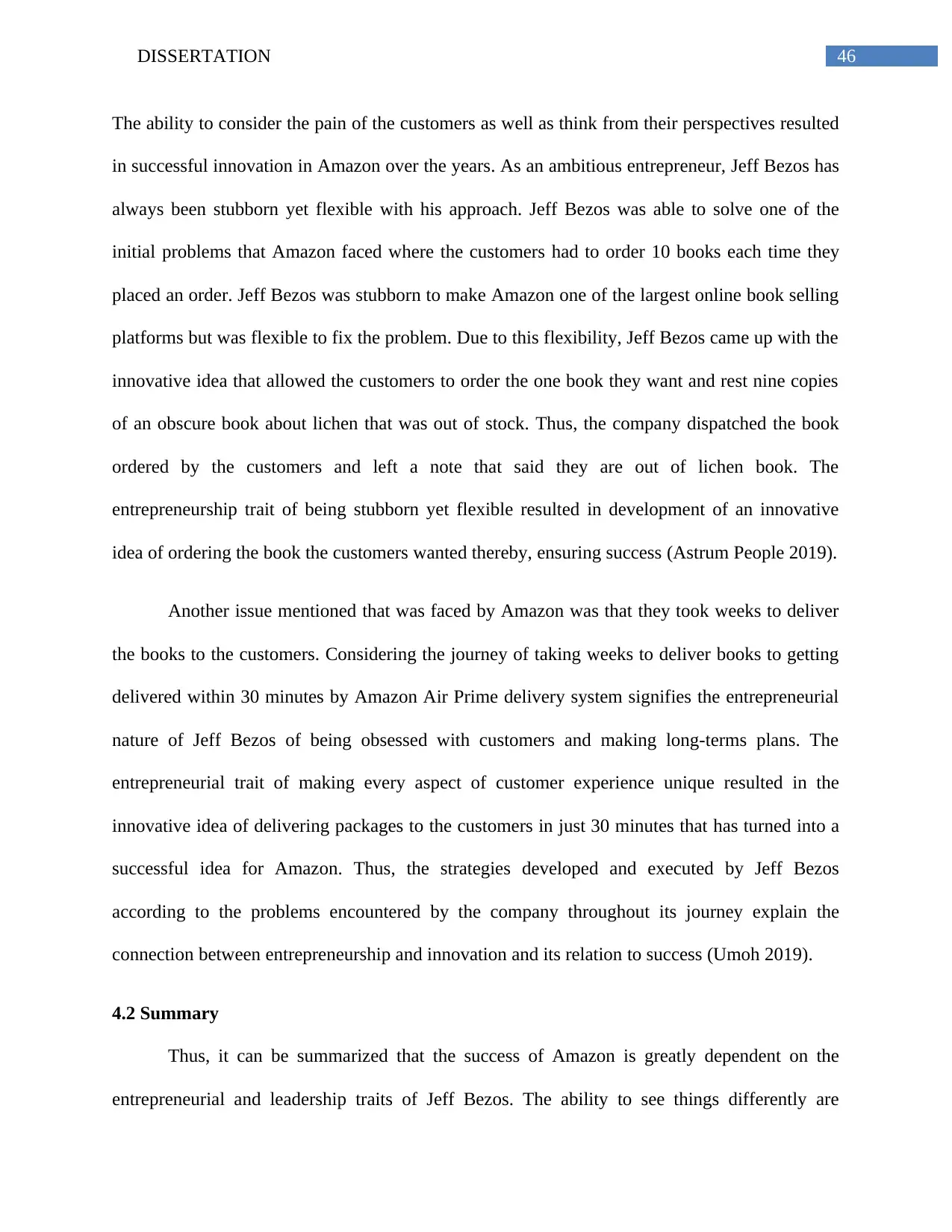
46DISSERTATION
The ability to consider the pain of the customers as well as think from their perspectives resulted
in successful innovation in Amazon over the years. As an ambitious entrepreneur, Jeff Bezos has
always been stubborn yet flexible with his approach. Jeff Bezos was able to solve one of the
initial problems that Amazon faced where the customers had to order 10 books each time they
placed an order. Jeff Bezos was stubborn to make Amazon one of the largest online book selling
platforms but was flexible to fix the problem. Due to this flexibility, Jeff Bezos came up with the
innovative idea that allowed the customers to order the one book they want and rest nine copies
of an obscure book about lichen that was out of stock. Thus, the company dispatched the book
ordered by the customers and left a note that said they are out of lichen book. The
entrepreneurship trait of being stubborn yet flexible resulted in development of an innovative
idea of ordering the book the customers wanted thereby, ensuring success (Astrum People 2019).
Another issue mentioned that was faced by Amazon was that they took weeks to deliver
the books to the customers. Considering the journey of taking weeks to deliver books to getting
delivered within 30 minutes by Amazon Air Prime delivery system signifies the entrepreneurial
nature of Jeff Bezos of being obsessed with customers and making long-terms plans. The
entrepreneurial trait of making every aspect of customer experience unique resulted in the
innovative idea of delivering packages to the customers in just 30 minutes that has turned into a
successful idea for Amazon. Thus, the strategies developed and executed by Jeff Bezos
according to the problems encountered by the company throughout its journey explain the
connection between entrepreneurship and innovation and its relation to success (Umoh 2019).
4.2 Summary
Thus, it can be summarized that the success of Amazon is greatly dependent on the
entrepreneurial and leadership traits of Jeff Bezos. The ability to see things differently are
The ability to consider the pain of the customers as well as think from their perspectives resulted
in successful innovation in Amazon over the years. As an ambitious entrepreneur, Jeff Bezos has
always been stubborn yet flexible with his approach. Jeff Bezos was able to solve one of the
initial problems that Amazon faced where the customers had to order 10 books each time they
placed an order. Jeff Bezos was stubborn to make Amazon one of the largest online book selling
platforms but was flexible to fix the problem. Due to this flexibility, Jeff Bezos came up with the
innovative idea that allowed the customers to order the one book they want and rest nine copies
of an obscure book about lichen that was out of stock. Thus, the company dispatched the book
ordered by the customers and left a note that said they are out of lichen book. The
entrepreneurship trait of being stubborn yet flexible resulted in development of an innovative
idea of ordering the book the customers wanted thereby, ensuring success (Astrum People 2019).
Another issue mentioned that was faced by Amazon was that they took weeks to deliver
the books to the customers. Considering the journey of taking weeks to deliver books to getting
delivered within 30 minutes by Amazon Air Prime delivery system signifies the entrepreneurial
nature of Jeff Bezos of being obsessed with customers and making long-terms plans. The
entrepreneurial trait of making every aspect of customer experience unique resulted in the
innovative idea of delivering packages to the customers in just 30 minutes that has turned into a
successful idea for Amazon. Thus, the strategies developed and executed by Jeff Bezos
according to the problems encountered by the company throughout its journey explain the
connection between entrepreneurship and innovation and its relation to success (Umoh 2019).
4.2 Summary
Thus, it can be summarized that the success of Amazon is greatly dependent on the
entrepreneurial and leadership traits of Jeff Bezos. The ability to see things differently are
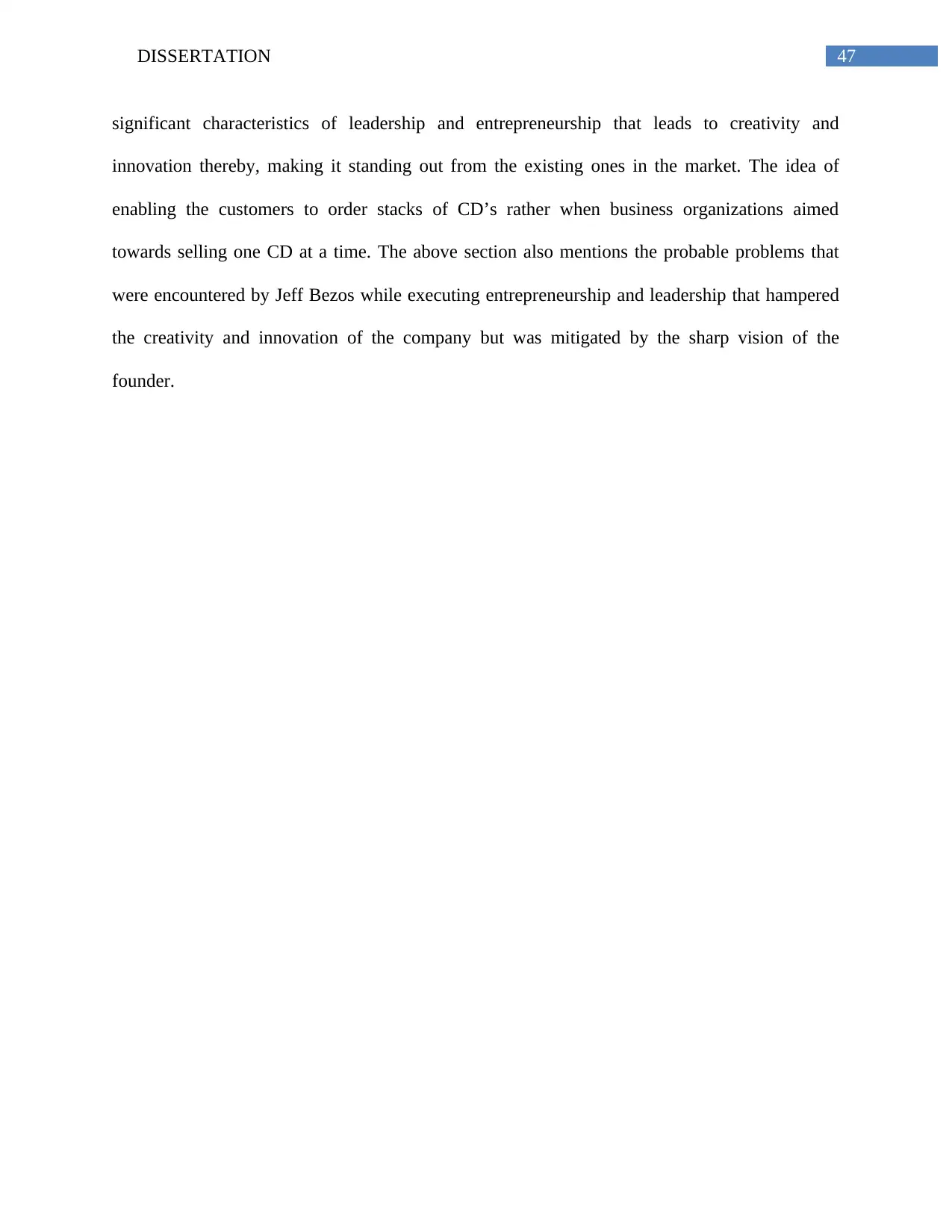
47DISSERTATION
significant characteristics of leadership and entrepreneurship that leads to creativity and
innovation thereby, making it standing out from the existing ones in the market. The idea of
enabling the customers to order stacks of CD’s rather when business organizations aimed
towards selling one CD at a time. The above section also mentions the probable problems that
were encountered by Jeff Bezos while executing entrepreneurship and leadership that hampered
the creativity and innovation of the company but was mitigated by the sharp vision of the
founder.
significant characteristics of leadership and entrepreneurship that leads to creativity and
innovation thereby, making it standing out from the existing ones in the market. The idea of
enabling the customers to order stacks of CD’s rather when business organizations aimed
towards selling one CD at a time. The above section also mentions the probable problems that
were encountered by Jeff Bezos while executing entrepreneurship and leadership that hampered
the creativity and innovation of the company but was mitigated by the sharp vision of the
founder.
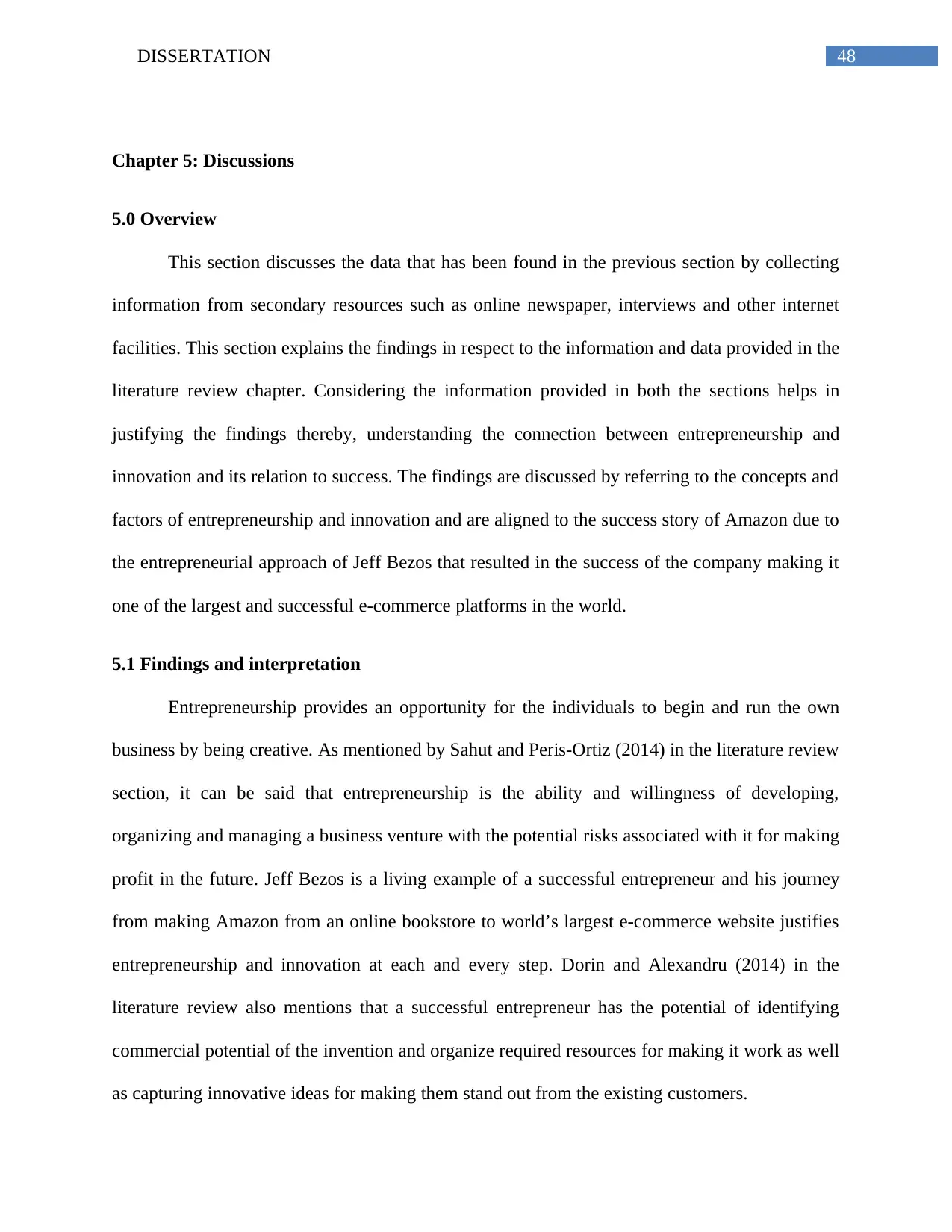
48DISSERTATION
Chapter 5: Discussions
5.0 Overview
This section discusses the data that has been found in the previous section by collecting
information from secondary resources such as online newspaper, interviews and other internet
facilities. This section explains the findings in respect to the information and data provided in the
literature review chapter. Considering the information provided in both the sections helps in
justifying the findings thereby, understanding the connection between entrepreneurship and
innovation and its relation to success. The findings are discussed by referring to the concepts and
factors of entrepreneurship and innovation and are aligned to the success story of Amazon due to
the entrepreneurial approach of Jeff Bezos that resulted in the success of the company making it
one of the largest and successful e-commerce platforms in the world.
5.1 Findings and interpretation
Entrepreneurship provides an opportunity for the individuals to begin and run the own
business by being creative. As mentioned by Sahut and Peris-Ortiz (2014) in the literature review
section, it can be said that entrepreneurship is the ability and willingness of developing,
organizing and managing a business venture with the potential risks associated with it for making
profit in the future. Jeff Bezos is a living example of a successful entrepreneur and his journey
from making Amazon from an online bookstore to world’s largest e-commerce website justifies
entrepreneurship and innovation at each and every step. Dorin and Alexandru (2014) in the
literature review also mentions that a successful entrepreneur has the potential of identifying
commercial potential of the invention and organize required resources for making it work as well
as capturing innovative ideas for making them stand out from the existing customers.
Chapter 5: Discussions
5.0 Overview
This section discusses the data that has been found in the previous section by collecting
information from secondary resources such as online newspaper, interviews and other internet
facilities. This section explains the findings in respect to the information and data provided in the
literature review chapter. Considering the information provided in both the sections helps in
justifying the findings thereby, understanding the connection between entrepreneurship and
innovation and its relation to success. The findings are discussed by referring to the concepts and
factors of entrepreneurship and innovation and are aligned to the success story of Amazon due to
the entrepreneurial approach of Jeff Bezos that resulted in the success of the company making it
one of the largest and successful e-commerce platforms in the world.
5.1 Findings and interpretation
Entrepreneurship provides an opportunity for the individuals to begin and run the own
business by being creative. As mentioned by Sahut and Peris-Ortiz (2014) in the literature review
section, it can be said that entrepreneurship is the ability and willingness of developing,
organizing and managing a business venture with the potential risks associated with it for making
profit in the future. Jeff Bezos is a living example of a successful entrepreneur and his journey
from making Amazon from an online bookstore to world’s largest e-commerce website justifies
entrepreneurship and innovation at each and every step. Dorin and Alexandru (2014) in the
literature review also mentions that a successful entrepreneur has the potential of identifying
commercial potential of the invention and organize required resources for making it work as well
as capturing innovative ideas for making them stand out from the existing customers.
Paraphrase This Document
Need a fresh take? Get an instant paraphrase of this document with our AI Paraphraser
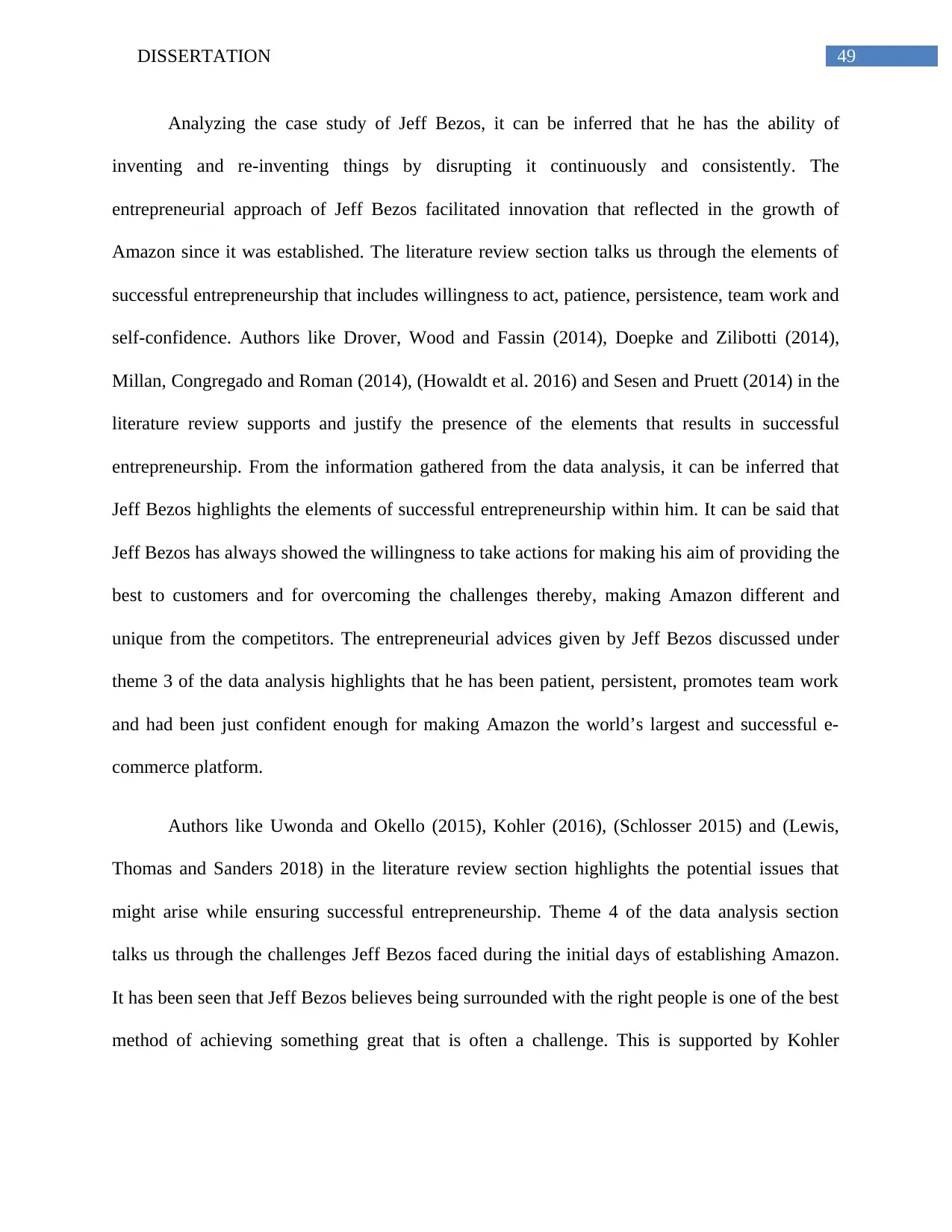
49DISSERTATION
Analyzing the case study of Jeff Bezos, it can be inferred that he has the ability of
inventing and re-inventing things by disrupting it continuously and consistently. The
entrepreneurial approach of Jeff Bezos facilitated innovation that reflected in the growth of
Amazon since it was established. The literature review section talks us through the elements of
successful entrepreneurship that includes willingness to act, patience, persistence, team work and
self-confidence. Authors like Drover, Wood and Fassin (2014), Doepke and Zilibotti (2014),
Millan, Congregado and Roman (2014), (Howaldt et al. 2016) and Sesen and Pruett (2014) in the
literature review supports and justify the presence of the elements that results in successful
entrepreneurship. From the information gathered from the data analysis, it can be inferred that
Jeff Bezos highlights the elements of successful entrepreneurship within him. It can be said that
Jeff Bezos has always showed the willingness to take actions for making his aim of providing the
best to customers and for overcoming the challenges thereby, making Amazon different and
unique from the competitors. The entrepreneurial advices given by Jeff Bezos discussed under
theme 3 of the data analysis highlights that he has been patient, persistent, promotes team work
and had been just confident enough for making Amazon the world’s largest and successful e-
commerce platform.
Authors like Uwonda and Okello (2015), Kohler (2016), (Schlosser 2015) and (Lewis,
Thomas and Sanders 2018) in the literature review section highlights the potential issues that
might arise while ensuring successful entrepreneurship. Theme 4 of the data analysis section
talks us through the challenges Jeff Bezos faced during the initial days of establishing Amazon.
It has been seen that Jeff Bezos believes being surrounded with the right people is one of the best
method of achieving something great that is often a challenge. This is supported by Kohler
Analyzing the case study of Jeff Bezos, it can be inferred that he has the ability of
inventing and re-inventing things by disrupting it continuously and consistently. The
entrepreneurial approach of Jeff Bezos facilitated innovation that reflected in the growth of
Amazon since it was established. The literature review section talks us through the elements of
successful entrepreneurship that includes willingness to act, patience, persistence, team work and
self-confidence. Authors like Drover, Wood and Fassin (2014), Doepke and Zilibotti (2014),
Millan, Congregado and Roman (2014), (Howaldt et al. 2016) and Sesen and Pruett (2014) in the
literature review supports and justify the presence of the elements that results in successful
entrepreneurship. From the information gathered from the data analysis, it can be inferred that
Jeff Bezos highlights the elements of successful entrepreneurship within him. It can be said that
Jeff Bezos has always showed the willingness to take actions for making his aim of providing the
best to customers and for overcoming the challenges thereby, making Amazon different and
unique from the competitors. The entrepreneurial advices given by Jeff Bezos discussed under
theme 3 of the data analysis highlights that he has been patient, persistent, promotes team work
and had been just confident enough for making Amazon the world’s largest and successful e-
commerce platform.
Authors like Uwonda and Okello (2015), Kohler (2016), (Schlosser 2015) and (Lewis,
Thomas and Sanders 2018) in the literature review section highlights the potential issues that
might arise while ensuring successful entrepreneurship. Theme 4 of the data analysis section
talks us through the challenges Jeff Bezos faced during the initial days of establishing Amazon.
It has been seen that Jeff Bezos believes being surrounded with the right people is one of the best
method of achieving something great that is often a challenge. This is supported by Kohler

50DISSERTATION
(2016) in the literature review section that mentions recruiting the right employees is extremely
challenging.
In the literature review section, Ghasabeh, Soosay and Reaiche (2015) and McCleskey
(2014) has described leadership as the set of practical skills possessed by the individuals that
ensures guidance, achieving mission successfully and ability to guide group of people. The
section also describes the leadership principles followed by Amazon that has ushered success for
the company. Theme 2 of the data analysis successfully discusses the disruptive leadership
followed by Jeff Bezos that helped in craving the path of success for Amazon. The data provided
in the section mentions that Jeff Bezos has claimed that disruption leadership helped him lead
Amazon to success. Jeff Bezos keeps on asking himself the changes coming decade will bring in
the industry for ensuring unique customer experience. Additionally, Jeff Bezos also believes that
business organizations need to experiment patiently and accept failures for providing better
solutions for enhancing the existing process. Disruptive leadership of Jeff Bezos allowed
Amazon to overcome one of its biggest challenges from the initial days. Successful execution of
disruptive leadership helped Amazon overcoming the hurdle of taking weeks to deliver books to
getting delivered within 30 minutes by Amazon Air Prime delivery system.
For the Amazon founder Jeff Bezos, customers have been the top priority that influenced
and encouraged him to think from their perspective of the customers. One of the most significant
leadership principles followed in Amazon is customer obsession that makes it different from the
competitors. This disruptive leadership of Jeff Bezos led to the foundation of Alexa, voice
controlling software and Amazon Go Convenience that allowed the customers to walk in, grab
their needful and walk out without having to deal with any queue or cashier. These were
(2016) in the literature review section that mentions recruiting the right employees is extremely
challenging.
In the literature review section, Ghasabeh, Soosay and Reaiche (2015) and McCleskey
(2014) has described leadership as the set of practical skills possessed by the individuals that
ensures guidance, achieving mission successfully and ability to guide group of people. The
section also describes the leadership principles followed by Amazon that has ushered success for
the company. Theme 2 of the data analysis successfully discusses the disruptive leadership
followed by Jeff Bezos that helped in craving the path of success for Amazon. The data provided
in the section mentions that Jeff Bezos has claimed that disruption leadership helped him lead
Amazon to success. Jeff Bezos keeps on asking himself the changes coming decade will bring in
the industry for ensuring unique customer experience. Additionally, Jeff Bezos also believes that
business organizations need to experiment patiently and accept failures for providing better
solutions for enhancing the existing process. Disruptive leadership of Jeff Bezos allowed
Amazon to overcome one of its biggest challenges from the initial days. Successful execution of
disruptive leadership helped Amazon overcoming the hurdle of taking weeks to deliver books to
getting delivered within 30 minutes by Amazon Air Prime delivery system.
For the Amazon founder Jeff Bezos, customers have been the top priority that influenced
and encouraged him to think from their perspective of the customers. One of the most significant
leadership principles followed in Amazon is customer obsession that makes it different from the
competitors. This disruptive leadership of Jeff Bezos led to the foundation of Alexa, voice
controlling software and Amazon Go Convenience that allowed the customers to walk in, grab
their needful and walk out without having to deal with any queue or cashier. These were
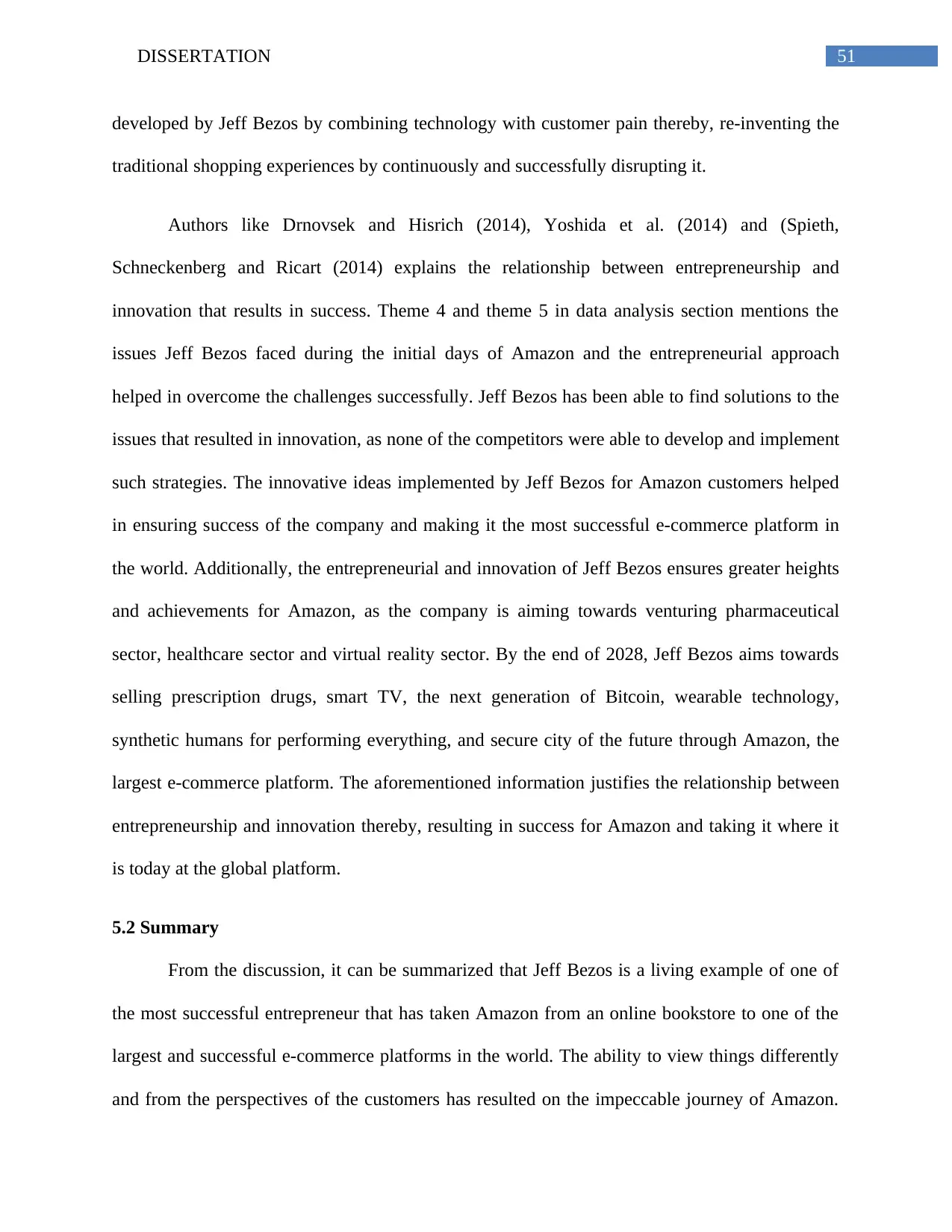
51DISSERTATION
developed by Jeff Bezos by combining technology with customer pain thereby, re-inventing the
traditional shopping experiences by continuously and successfully disrupting it.
Authors like Drnovsek and Hisrich (2014), Yoshida et al. (2014) and (Spieth,
Schneckenberg and Ricart (2014) explains the relationship between entrepreneurship and
innovation that results in success. Theme 4 and theme 5 in data analysis section mentions the
issues Jeff Bezos faced during the initial days of Amazon and the entrepreneurial approach
helped in overcome the challenges successfully. Jeff Bezos has been able to find solutions to the
issues that resulted in innovation, as none of the competitors were able to develop and implement
such strategies. The innovative ideas implemented by Jeff Bezos for Amazon customers helped
in ensuring success of the company and making it the most successful e-commerce platform in
the world. Additionally, the entrepreneurial and innovation of Jeff Bezos ensures greater heights
and achievements for Amazon, as the company is aiming towards venturing pharmaceutical
sector, healthcare sector and virtual reality sector. By the end of 2028, Jeff Bezos aims towards
selling prescription drugs, smart TV, the next generation of Bitcoin, wearable technology,
synthetic humans for performing everything, and secure city of the future through Amazon, the
largest e-commerce platform. The aforementioned information justifies the relationship between
entrepreneurship and innovation thereby, resulting in success for Amazon and taking it where it
is today at the global platform.
5.2 Summary
From the discussion, it can be summarized that Jeff Bezos is a living example of one of
the most successful entrepreneur that has taken Amazon from an online bookstore to one of the
largest and successful e-commerce platforms in the world. The ability to view things differently
and from the perspectives of the customers has resulted on the impeccable journey of Amazon.
developed by Jeff Bezos by combining technology with customer pain thereby, re-inventing the
traditional shopping experiences by continuously and successfully disrupting it.
Authors like Drnovsek and Hisrich (2014), Yoshida et al. (2014) and (Spieth,
Schneckenberg and Ricart (2014) explains the relationship between entrepreneurship and
innovation that results in success. Theme 4 and theme 5 in data analysis section mentions the
issues Jeff Bezos faced during the initial days of Amazon and the entrepreneurial approach
helped in overcome the challenges successfully. Jeff Bezos has been able to find solutions to the
issues that resulted in innovation, as none of the competitors were able to develop and implement
such strategies. The innovative ideas implemented by Jeff Bezos for Amazon customers helped
in ensuring success of the company and making it the most successful e-commerce platform in
the world. Additionally, the entrepreneurial and innovation of Jeff Bezos ensures greater heights
and achievements for Amazon, as the company is aiming towards venturing pharmaceutical
sector, healthcare sector and virtual reality sector. By the end of 2028, Jeff Bezos aims towards
selling prescription drugs, smart TV, the next generation of Bitcoin, wearable technology,
synthetic humans for performing everything, and secure city of the future through Amazon, the
largest e-commerce platform. The aforementioned information justifies the relationship between
entrepreneurship and innovation thereby, resulting in success for Amazon and taking it where it
is today at the global platform.
5.2 Summary
From the discussion, it can be summarized that Jeff Bezos is a living example of one of
the most successful entrepreneur that has taken Amazon from an online bookstore to one of the
largest and successful e-commerce platforms in the world. The ability to view things differently
and from the perspectives of the customers has resulted on the impeccable journey of Amazon.
Secure Best Marks with AI Grader
Need help grading? Try our AI Grader for instant feedback on your assignments.

52DISSERTATION
The company has been able to overcome every challenge that was encountered throughout the
journey due to the entrepreneurial characteristics of Jeff Bezos thereby, resulting in innovations
and ensuring success for the company.
The company has been able to overcome every challenge that was encountered throughout the
journey due to the entrepreneurial characteristics of Jeff Bezos thereby, resulting in innovations
and ensuring success for the company.
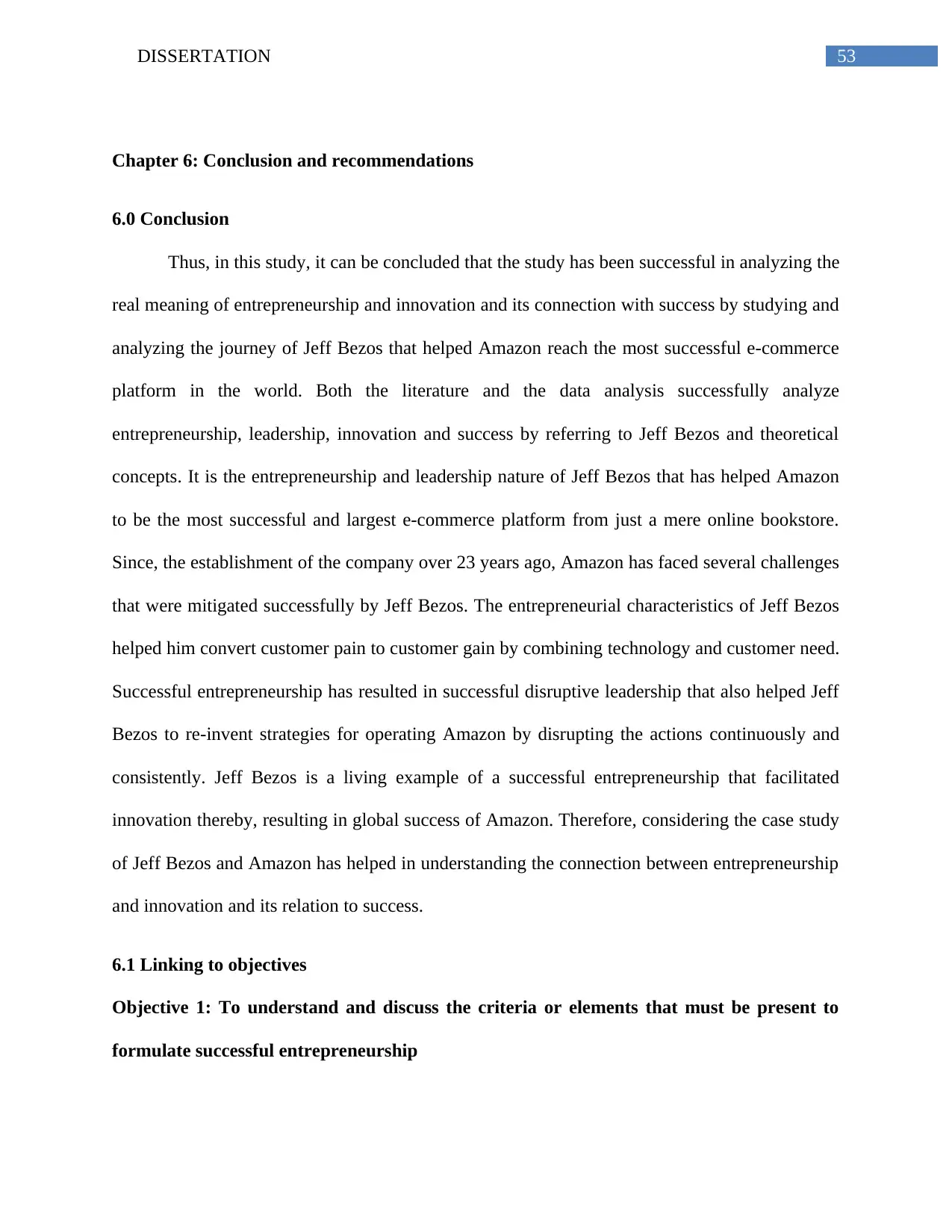
53DISSERTATION
Chapter 6: Conclusion and recommendations
6.0 Conclusion
Thus, in this study, it can be concluded that the study has been successful in analyzing the
real meaning of entrepreneurship and innovation and its connection with success by studying and
analyzing the journey of Jeff Bezos that helped Amazon reach the most successful e-commerce
platform in the world. Both the literature and the data analysis successfully analyze
entrepreneurship, leadership, innovation and success by referring to Jeff Bezos and theoretical
concepts. It is the entrepreneurship and leadership nature of Jeff Bezos that has helped Amazon
to be the most successful and largest e-commerce platform from just a mere online bookstore.
Since, the establishment of the company over 23 years ago, Amazon has faced several challenges
that were mitigated successfully by Jeff Bezos. The entrepreneurial characteristics of Jeff Bezos
helped him convert customer pain to customer gain by combining technology and customer need.
Successful entrepreneurship has resulted in successful disruptive leadership that also helped Jeff
Bezos to re-invent strategies for operating Amazon by disrupting the actions continuously and
consistently. Jeff Bezos is a living example of a successful entrepreneurship that facilitated
innovation thereby, resulting in global success of Amazon. Therefore, considering the case study
of Jeff Bezos and Amazon has helped in understanding the connection between entrepreneurship
and innovation and its relation to success.
6.1 Linking to objectives
Objective 1: To understand and discuss the criteria or elements that must be present to
formulate successful entrepreneurship
Chapter 6: Conclusion and recommendations
6.0 Conclusion
Thus, in this study, it can be concluded that the study has been successful in analyzing the
real meaning of entrepreneurship and innovation and its connection with success by studying and
analyzing the journey of Jeff Bezos that helped Amazon reach the most successful e-commerce
platform in the world. Both the literature and the data analysis successfully analyze
entrepreneurship, leadership, innovation and success by referring to Jeff Bezos and theoretical
concepts. It is the entrepreneurship and leadership nature of Jeff Bezos that has helped Amazon
to be the most successful and largest e-commerce platform from just a mere online bookstore.
Since, the establishment of the company over 23 years ago, Amazon has faced several challenges
that were mitigated successfully by Jeff Bezos. The entrepreneurial characteristics of Jeff Bezos
helped him convert customer pain to customer gain by combining technology and customer need.
Successful entrepreneurship has resulted in successful disruptive leadership that also helped Jeff
Bezos to re-invent strategies for operating Amazon by disrupting the actions continuously and
consistently. Jeff Bezos is a living example of a successful entrepreneurship that facilitated
innovation thereby, resulting in global success of Amazon. Therefore, considering the case study
of Jeff Bezos and Amazon has helped in understanding the connection between entrepreneurship
and innovation and its relation to success.
6.1 Linking to objectives
Objective 1: To understand and discuss the criteria or elements that must be present to
formulate successful entrepreneurship
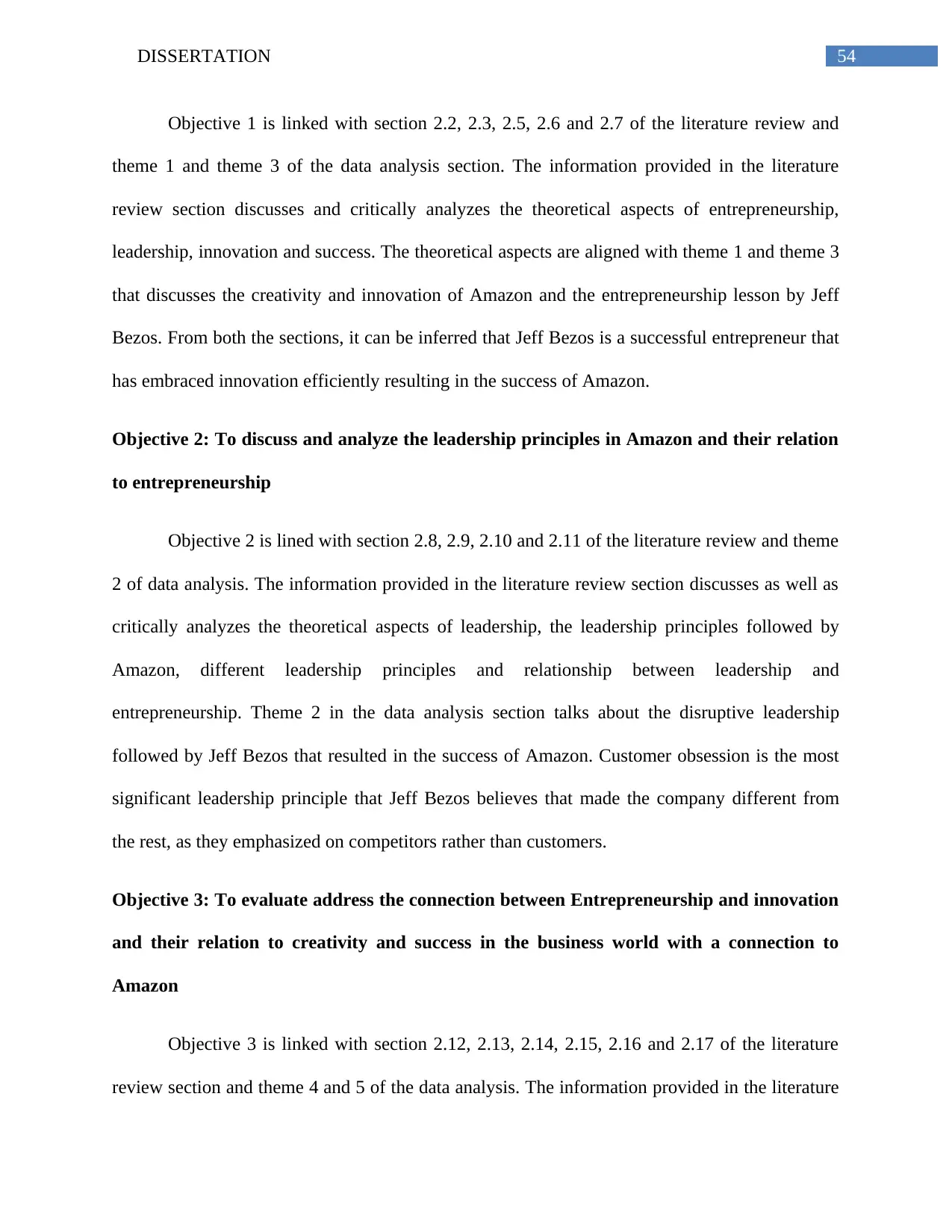
54DISSERTATION
Objective 1 is linked with section 2.2, 2.3, 2.5, 2.6 and 2.7 of the literature review and
theme 1 and theme 3 of the data analysis section. The information provided in the literature
review section discusses and critically analyzes the theoretical aspects of entrepreneurship,
leadership, innovation and success. The theoretical aspects are aligned with theme 1 and theme 3
that discusses the creativity and innovation of Amazon and the entrepreneurship lesson by Jeff
Bezos. From both the sections, it can be inferred that Jeff Bezos is a successful entrepreneur that
has embraced innovation efficiently resulting in the success of Amazon.
Objective 2: To discuss and analyze the leadership principles in Amazon and their relation
to entrepreneurship
Objective 2 is lined with section 2.8, 2.9, 2.10 and 2.11 of the literature review and theme
2 of data analysis. The information provided in the literature review section discusses as well as
critically analyzes the theoretical aspects of leadership, the leadership principles followed by
Amazon, different leadership principles and relationship between leadership and
entrepreneurship. Theme 2 in the data analysis section talks about the disruptive leadership
followed by Jeff Bezos that resulted in the success of Amazon. Customer obsession is the most
significant leadership principle that Jeff Bezos believes that made the company different from
the rest, as they emphasized on competitors rather than customers.
Objective 3: To evaluate address the connection between Entrepreneurship and innovation
and their relation to creativity and success in the business world with a connection to
Amazon
Objective 3 is linked with section 2.12, 2.13, 2.14, 2.15, 2.16 and 2.17 of the literature
review section and theme 4 and 5 of the data analysis. The information provided in the literature
Objective 1 is linked with section 2.2, 2.3, 2.5, 2.6 and 2.7 of the literature review and
theme 1 and theme 3 of the data analysis section. The information provided in the literature
review section discusses and critically analyzes the theoretical aspects of entrepreneurship,
leadership, innovation and success. The theoretical aspects are aligned with theme 1 and theme 3
that discusses the creativity and innovation of Amazon and the entrepreneurship lesson by Jeff
Bezos. From both the sections, it can be inferred that Jeff Bezos is a successful entrepreneur that
has embraced innovation efficiently resulting in the success of Amazon.
Objective 2: To discuss and analyze the leadership principles in Amazon and their relation
to entrepreneurship
Objective 2 is lined with section 2.8, 2.9, 2.10 and 2.11 of the literature review and theme
2 of data analysis. The information provided in the literature review section discusses as well as
critically analyzes the theoretical aspects of leadership, the leadership principles followed by
Amazon, different leadership principles and relationship between leadership and
entrepreneurship. Theme 2 in the data analysis section talks about the disruptive leadership
followed by Jeff Bezos that resulted in the success of Amazon. Customer obsession is the most
significant leadership principle that Jeff Bezos believes that made the company different from
the rest, as they emphasized on competitors rather than customers.
Objective 3: To evaluate address the connection between Entrepreneurship and innovation
and their relation to creativity and success in the business world with a connection to
Amazon
Objective 3 is linked with section 2.12, 2.13, 2.14, 2.15, 2.16 and 2.17 of the literature
review section and theme 4 and 5 of the data analysis. The information provided in the literature
Paraphrase This Document
Need a fresh take? Get an instant paraphrase of this document with our AI Paraphraser
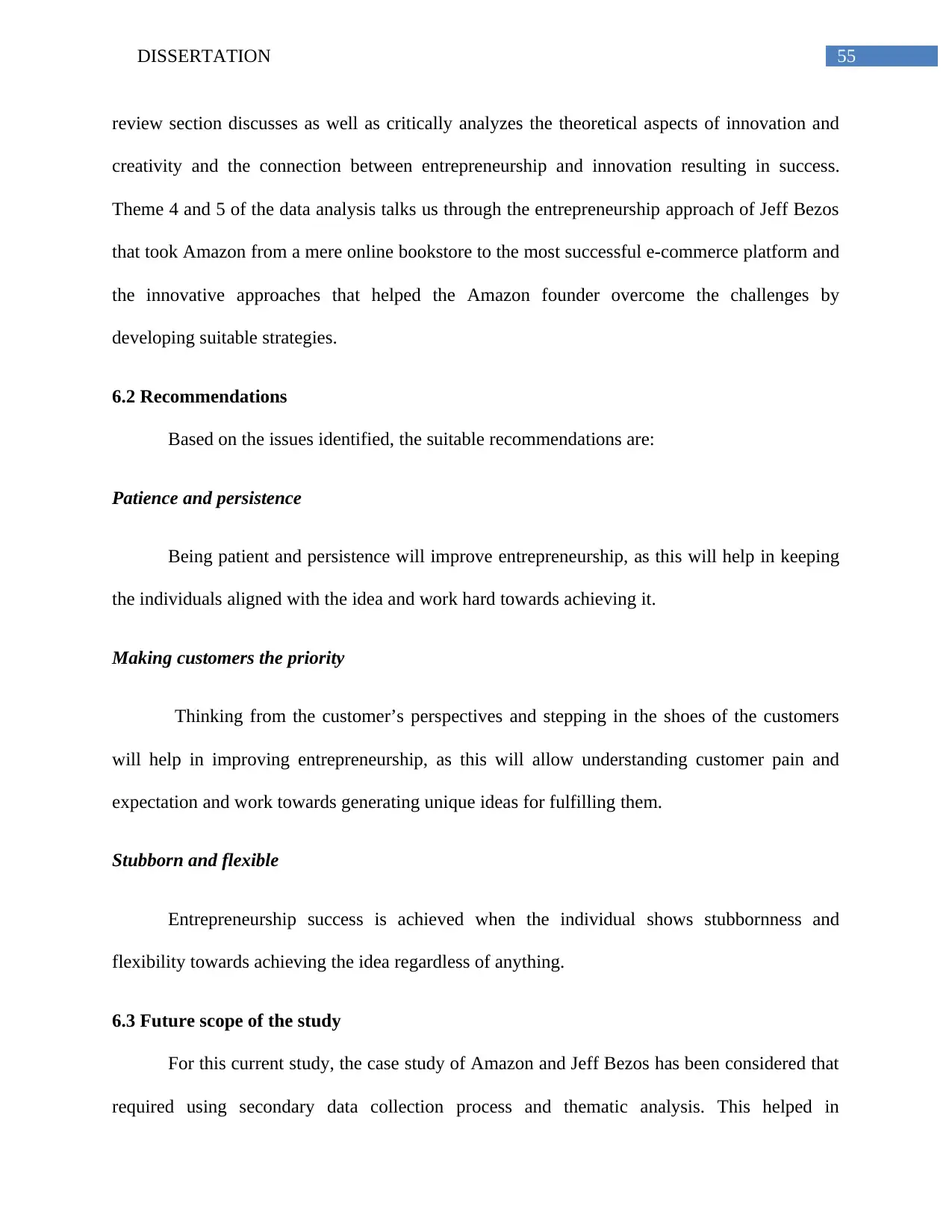
55DISSERTATION
review section discusses as well as critically analyzes the theoretical aspects of innovation and
creativity and the connection between entrepreneurship and innovation resulting in success.
Theme 4 and 5 of the data analysis talks us through the entrepreneurship approach of Jeff Bezos
that took Amazon from a mere online bookstore to the most successful e-commerce platform and
the innovative approaches that helped the Amazon founder overcome the challenges by
developing suitable strategies.
6.2 Recommendations
Based on the issues identified, the suitable recommendations are:
Patience and persistence
Being patient and persistence will improve entrepreneurship, as this will help in keeping
the individuals aligned with the idea and work hard towards achieving it.
Making customers the priority
Thinking from the customer’s perspectives and stepping in the shoes of the customers
will help in improving entrepreneurship, as this will allow understanding customer pain and
expectation and work towards generating unique ideas for fulfilling them.
Stubborn and flexible
Entrepreneurship success is achieved when the individual shows stubbornness and
flexibility towards achieving the idea regardless of anything.
6.3 Future scope of the study
For this current study, the case study of Amazon and Jeff Bezos has been considered that
required using secondary data collection process and thematic analysis. This helped in
review section discusses as well as critically analyzes the theoretical aspects of innovation and
creativity and the connection between entrepreneurship and innovation resulting in success.
Theme 4 and 5 of the data analysis talks us through the entrepreneurship approach of Jeff Bezos
that took Amazon from a mere online bookstore to the most successful e-commerce platform and
the innovative approaches that helped the Amazon founder overcome the challenges by
developing suitable strategies.
6.2 Recommendations
Based on the issues identified, the suitable recommendations are:
Patience and persistence
Being patient and persistence will improve entrepreneurship, as this will help in keeping
the individuals aligned with the idea and work hard towards achieving it.
Making customers the priority
Thinking from the customer’s perspectives and stepping in the shoes of the customers
will help in improving entrepreneurship, as this will allow understanding customer pain and
expectation and work towards generating unique ideas for fulfilling them.
Stubborn and flexible
Entrepreneurship success is achieved when the individual shows stubbornness and
flexibility towards achieving the idea regardless of anything.
6.3 Future scope of the study
For this current study, the case study of Amazon and Jeff Bezos has been considered that
required using secondary data collection process and thematic analysis. This helped in
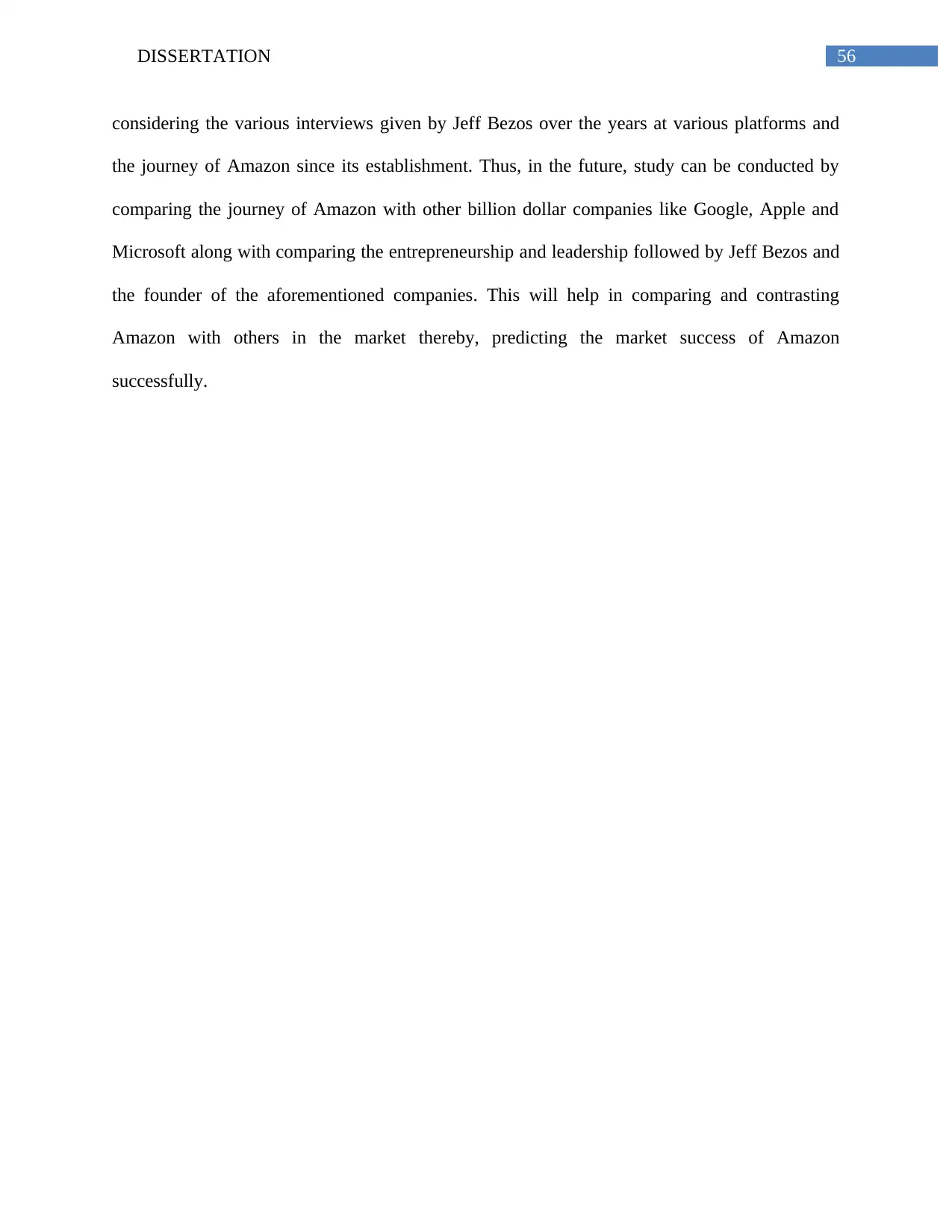
56DISSERTATION
considering the various interviews given by Jeff Bezos over the years at various platforms and
the journey of Amazon since its establishment. Thus, in the future, study can be conducted by
comparing the journey of Amazon with other billion dollar companies like Google, Apple and
Microsoft along with comparing the entrepreneurship and leadership followed by Jeff Bezos and
the founder of the aforementioned companies. This will help in comparing and contrasting
Amazon with others in the market thereby, predicting the market success of Amazon
successfully.
considering the various interviews given by Jeff Bezos over the years at various platforms and
the journey of Amazon since its establishment. Thus, in the future, study can be conducted by
comparing the journey of Amazon with other billion dollar companies like Google, Apple and
Microsoft along with comparing the entrepreneurship and leadership followed by Jeff Bezos and
the founder of the aforementioned companies. This will help in comparing and contrasting
Amazon with others in the market thereby, predicting the market success of Amazon
successfully.
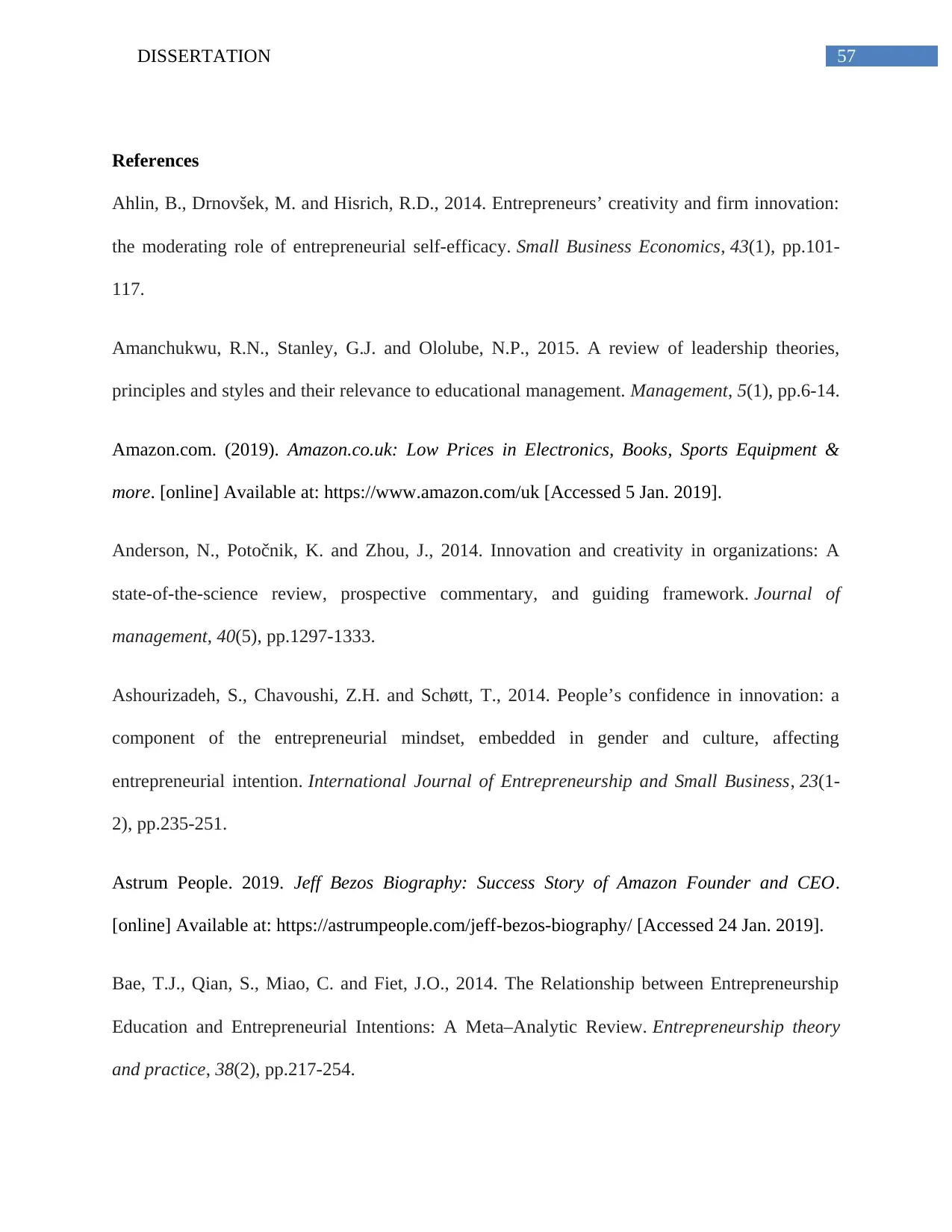
57DISSERTATION
References
Ahlin, B., Drnovšek, M. and Hisrich, R.D., 2014. Entrepreneurs’ creativity and firm innovation:
the moderating role of entrepreneurial self-efficacy. Small Business Economics, 43(1), pp.101-
117.
Amanchukwu, R.N., Stanley, G.J. and Ololube, N.P., 2015. A review of leadership theories,
principles and styles and their relevance to educational management. Management, 5(1), pp.6-14.
Amazon.com. (2019). Amazon.co.uk: Low Prices in Electronics, Books, Sports Equipment &
more. [online] Available at: https://www.amazon.com/uk [Accessed 5 Jan. 2019].
Anderson, N., Potočnik, K. and Zhou, J., 2014. Innovation and creativity in organizations: A
state-of-the-science review, prospective commentary, and guiding framework. Journal of
management, 40(5), pp.1297-1333.
Ashourizadeh, S., Chavoushi, Z.H. and Schøtt, T., 2014. People’s confidence in innovation: a
component of the entrepreneurial mindset, embedded in gender and culture, affecting
entrepreneurial intention. International Journal of Entrepreneurship and Small Business, 23(1-
2), pp.235-251.
Astrum People. 2019. Jeff Bezos Biography: Success Story of Amazon Founder and CEO.
[online] Available at: https://astrumpeople.com/jeff-bezos-biography/ [Accessed 24 Jan. 2019].
Bae, T.J., Qian, S., Miao, C. and Fiet, J.O., 2014. The Relationship between Entrepreneurship
Education and Entrepreneurial Intentions: A Meta–Analytic Review. Entrepreneurship theory
and practice, 38(2), pp.217-254.
References
Ahlin, B., Drnovšek, M. and Hisrich, R.D., 2014. Entrepreneurs’ creativity and firm innovation:
the moderating role of entrepreneurial self-efficacy. Small Business Economics, 43(1), pp.101-
117.
Amanchukwu, R.N., Stanley, G.J. and Ololube, N.P., 2015. A review of leadership theories,
principles and styles and their relevance to educational management. Management, 5(1), pp.6-14.
Amazon.com. (2019). Amazon.co.uk: Low Prices in Electronics, Books, Sports Equipment &
more. [online] Available at: https://www.amazon.com/uk [Accessed 5 Jan. 2019].
Anderson, N., Potočnik, K. and Zhou, J., 2014. Innovation and creativity in organizations: A
state-of-the-science review, prospective commentary, and guiding framework. Journal of
management, 40(5), pp.1297-1333.
Ashourizadeh, S., Chavoushi, Z.H. and Schøtt, T., 2014. People’s confidence in innovation: a
component of the entrepreneurial mindset, embedded in gender and culture, affecting
entrepreneurial intention. International Journal of Entrepreneurship and Small Business, 23(1-
2), pp.235-251.
Astrum People. 2019. Jeff Bezos Biography: Success Story of Amazon Founder and CEO.
[online] Available at: https://astrumpeople.com/jeff-bezos-biography/ [Accessed 24 Jan. 2019].
Bae, T.J., Qian, S., Miao, C. and Fiet, J.O., 2014. The Relationship between Entrepreneurship
Education and Entrepreneurial Intentions: A Meta–Analytic Review. Entrepreneurship theory
and practice, 38(2), pp.217-254.
Secure Best Marks with AI Grader
Need help grading? Try our AI Grader for instant feedback on your assignments.

58DISSERTATION
Bauer, G.R., 2014. Incorporating intersectionality theory into population health research
methodology: Challenges and the potential to advance health equity. Social science &
medicine, 110, pp.10-17.
Biography. 2019. Jeff Bezos. [online] Available at: https://www.biography.com/people/jeff-
bezos-9542209 [Accessed 24 Jan. 2019].
Blok, V. and Lemmens, P., 2015. The emerging concept of responsible innovation. Three
reasons why it is questionable and calls for a radical transformation of the concept of innovation.
In Responsible Innovation 2 (pp. 19-35). Springer, Cham.
Braunerhjelm, P. and Eklund, J.E., 2014. Taxes, tax administrative burdens and new firm
formation. Kyklos, 67(1), pp.1-11.
Bresler, L. and Stake, R.E., 2017. Qualitative research methodology in music education.
In Critical Essays in Music Education (pp. 113-128). Routledge.
Business Insider. 2019. Here Are The Challenges Facing Jeff Bezos As He Takes Over The
Washington Post. [online] Available at: https://www.businessinsider.in/Here-Are-The-
Challenges-Facing-Jeff-Bezos-As-He-Takes-Over-The-Washington-Post/articleshow/
21649978.cms [Accessed 24 Jan. 2019].
Business Insider. 2019. One of Amazon's biggest challenges in its early days was solved by an
obscure book about lichen. [online] Available at: https://www.businessinsider.in/One-of-
Amazons-biggest-challenges-in-its-early-days-was-solved-by-an-obscure-book-about-lichen/
articleshow/63860057.cms [Accessed 24 Jan. 2019].
Bauer, G.R., 2014. Incorporating intersectionality theory into population health research
methodology: Challenges and the potential to advance health equity. Social science &
medicine, 110, pp.10-17.
Biography. 2019. Jeff Bezos. [online] Available at: https://www.biography.com/people/jeff-
bezos-9542209 [Accessed 24 Jan. 2019].
Blok, V. and Lemmens, P., 2015. The emerging concept of responsible innovation. Three
reasons why it is questionable and calls for a radical transformation of the concept of innovation.
In Responsible Innovation 2 (pp. 19-35). Springer, Cham.
Braunerhjelm, P. and Eklund, J.E., 2014. Taxes, tax administrative burdens and new firm
formation. Kyklos, 67(1), pp.1-11.
Bresler, L. and Stake, R.E., 2017. Qualitative research methodology in music education.
In Critical Essays in Music Education (pp. 113-128). Routledge.
Business Insider. 2019. Here Are The Challenges Facing Jeff Bezos As He Takes Over The
Washington Post. [online] Available at: https://www.businessinsider.in/Here-Are-The-
Challenges-Facing-Jeff-Bezos-As-He-Takes-Over-The-Washington-Post/articleshow/
21649978.cms [Accessed 24 Jan. 2019].
Business Insider. 2019. One of Amazon's biggest challenges in its early days was solved by an
obscure book about lichen. [online] Available at: https://www.businessinsider.in/One-of-
Amazons-biggest-challenges-in-its-early-days-was-solved-by-an-obscure-book-about-lichen/
articleshow/63860057.cms [Accessed 24 Jan. 2019].
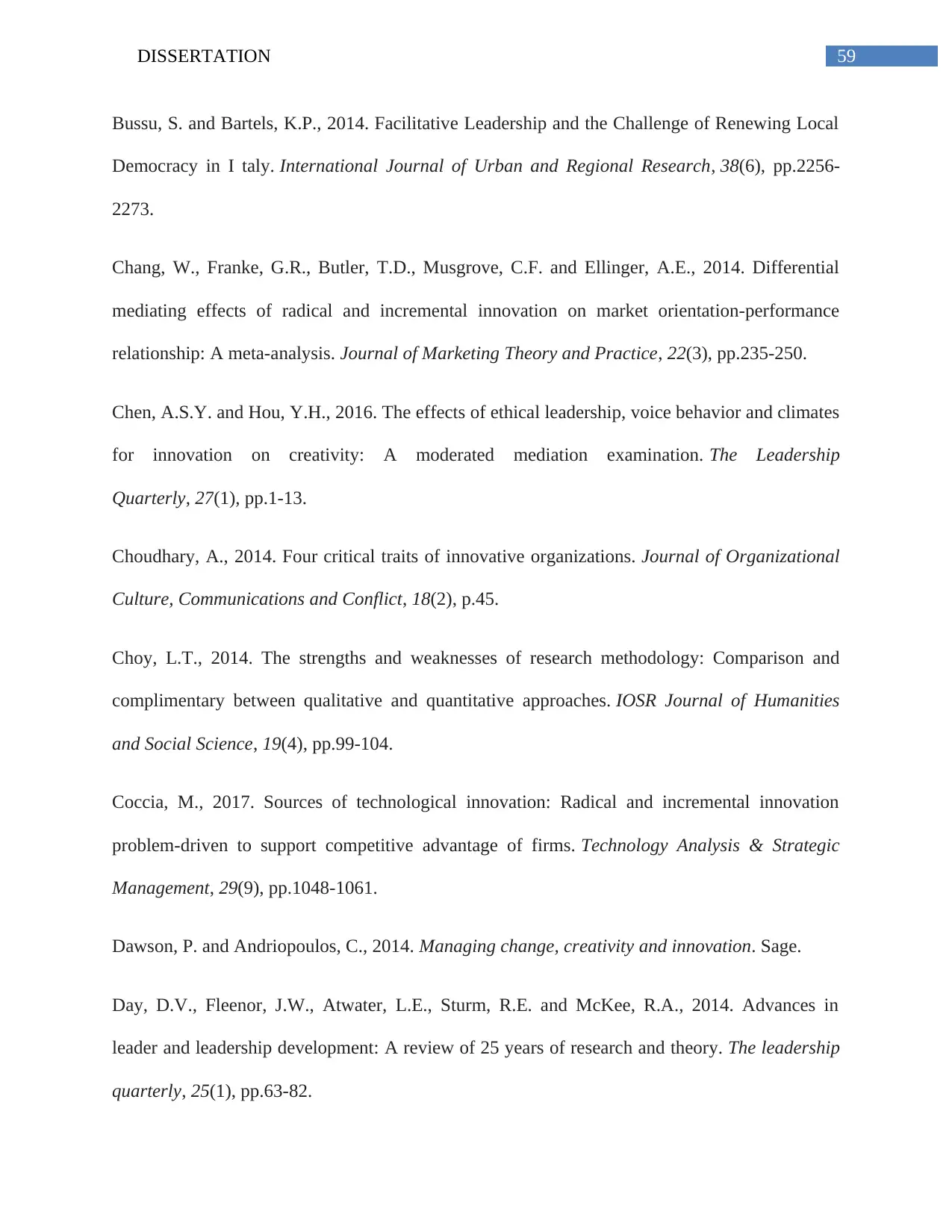
59DISSERTATION
Bussu, S. and Bartels, K.P., 2014. Facilitative Leadership and the Challenge of Renewing Local
Democracy in I taly. International Journal of Urban and Regional Research, 38(6), pp.2256-
2273.
Chang, W., Franke, G.R., Butler, T.D., Musgrove, C.F. and Ellinger, A.E., 2014. Differential
mediating effects of radical and incremental innovation on market orientation-performance
relationship: A meta-analysis. Journal of Marketing Theory and Practice, 22(3), pp.235-250.
Chen, A.S.Y. and Hou, Y.H., 2016. The effects of ethical leadership, voice behavior and climates
for innovation on creativity: A moderated mediation examination. The Leadership
Quarterly, 27(1), pp.1-13.
Choudhary, A., 2014. Four critical traits of innovative organizations. Journal of Organizational
Culture, Communications and Conflict, 18(2), p.45.
Choy, L.T., 2014. The strengths and weaknesses of research methodology: Comparison and
complimentary between qualitative and quantitative approaches. IOSR Journal of Humanities
and Social Science, 19(4), pp.99-104.
Coccia, M., 2017. Sources of technological innovation: Radical and incremental innovation
problem-driven to support competitive advantage of firms. Technology Analysis & Strategic
Management, 29(9), pp.1048-1061.
Dawson, P. and Andriopoulos, C., 2014. Managing change, creativity and innovation. Sage.
Day, D.V., Fleenor, J.W., Atwater, L.E., Sturm, R.E. and McKee, R.A., 2014. Advances in
leader and leadership development: A review of 25 years of research and theory. The leadership
quarterly, 25(1), pp.63-82.
Bussu, S. and Bartels, K.P., 2014. Facilitative Leadership and the Challenge of Renewing Local
Democracy in I taly. International Journal of Urban and Regional Research, 38(6), pp.2256-
2273.
Chang, W., Franke, G.R., Butler, T.D., Musgrove, C.F. and Ellinger, A.E., 2014. Differential
mediating effects of radical and incremental innovation on market orientation-performance
relationship: A meta-analysis. Journal of Marketing Theory and Practice, 22(3), pp.235-250.
Chen, A.S.Y. and Hou, Y.H., 2016. The effects of ethical leadership, voice behavior and climates
for innovation on creativity: A moderated mediation examination. The Leadership
Quarterly, 27(1), pp.1-13.
Choudhary, A., 2014. Four critical traits of innovative organizations. Journal of Organizational
Culture, Communications and Conflict, 18(2), p.45.
Choy, L.T., 2014. The strengths and weaknesses of research methodology: Comparison and
complimentary between qualitative and quantitative approaches. IOSR Journal of Humanities
and Social Science, 19(4), pp.99-104.
Coccia, M., 2017. Sources of technological innovation: Radical and incremental innovation
problem-driven to support competitive advantage of firms. Technology Analysis & Strategic
Management, 29(9), pp.1048-1061.
Dawson, P. and Andriopoulos, C., 2014. Managing change, creativity and innovation. Sage.
Day, D.V., Fleenor, J.W., Atwater, L.E., Sturm, R.E. and McKee, R.A., 2014. Advances in
leader and leadership development: A review of 25 years of research and theory. The leadership
quarterly, 25(1), pp.63-82.
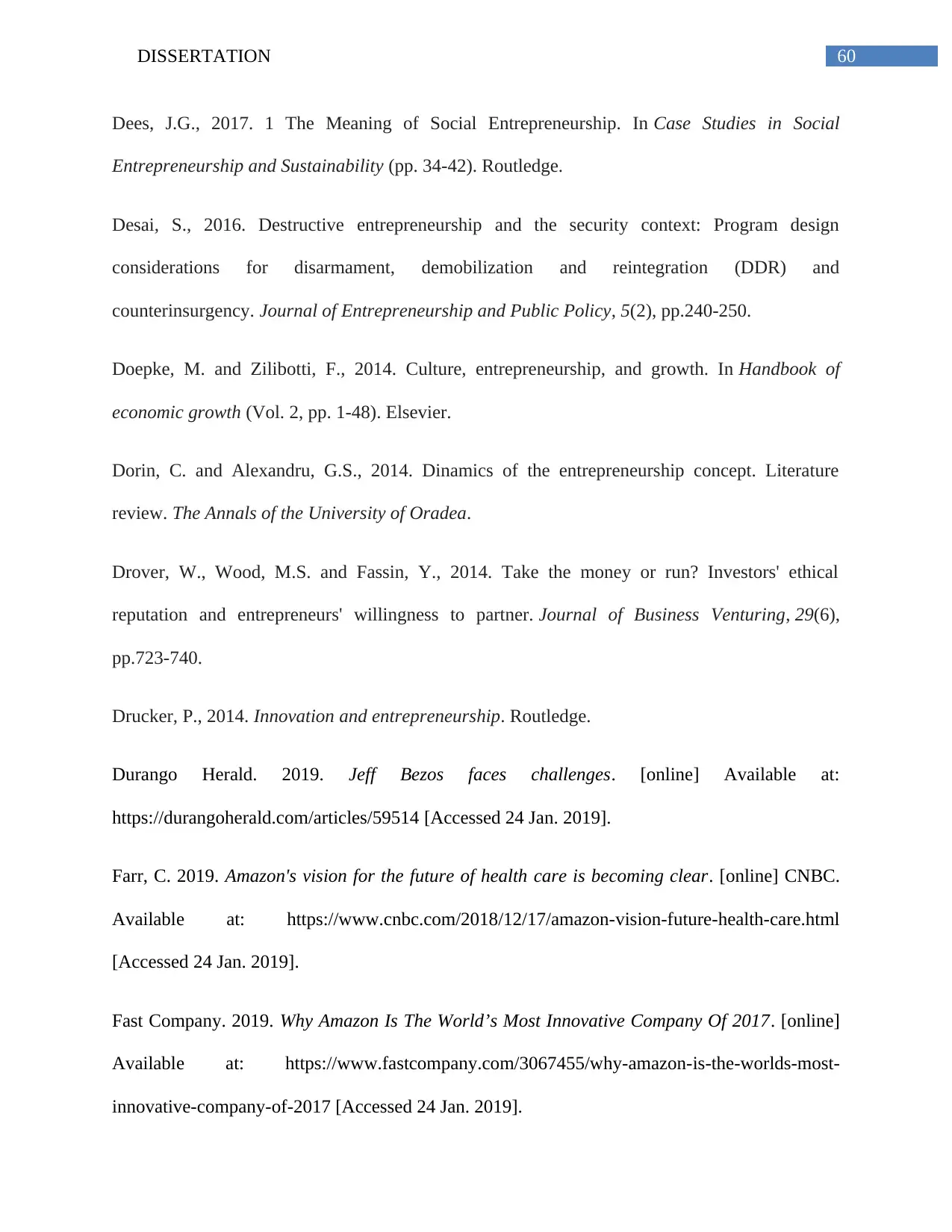
60DISSERTATION
Dees, J.G., 2017. 1 The Meaning of Social Entrepreneurship. In Case Studies in Social
Entrepreneurship and Sustainability (pp. 34-42). Routledge.
Desai, S., 2016. Destructive entrepreneurship and the security context: Program design
considerations for disarmament, demobilization and reintegration (DDR) and
counterinsurgency. Journal of Entrepreneurship and Public Policy, 5(2), pp.240-250.
Doepke, M. and Zilibotti, F., 2014. Culture, entrepreneurship, and growth. In Handbook of
economic growth (Vol. 2, pp. 1-48). Elsevier.
Dorin, C. and Alexandru, G.S., 2014. Dinamics of the entrepreneurship concept. Literature
review. The Annals of the University of Oradea.
Drover, W., Wood, M.S. and Fassin, Y., 2014. Take the money or run? Investors' ethical
reputation and entrepreneurs' willingness to partner. Journal of Business Venturing, 29(6),
pp.723-740.
Drucker, P., 2014. Innovation and entrepreneurship. Routledge.
Durango Herald. 2019. Jeff Bezos faces challenges. [online] Available at:
https://durangoherald.com/articles/59514 [Accessed 24 Jan. 2019].
Farr, C. 2019. Amazon's vision for the future of health care is becoming clear. [online] CNBC.
Available at: https://www.cnbc.com/2018/12/17/amazon-vision-future-health-care.html
[Accessed 24 Jan. 2019].
Fast Company. 2019. Why Amazon Is The World’s Most Innovative Company Of 2017. [online]
Available at: https://www.fastcompany.com/3067455/why-amazon-is-the-worlds-most-
innovative-company-of-2017 [Accessed 24 Jan. 2019].
Dees, J.G., 2017. 1 The Meaning of Social Entrepreneurship. In Case Studies in Social
Entrepreneurship and Sustainability (pp. 34-42). Routledge.
Desai, S., 2016. Destructive entrepreneurship and the security context: Program design
considerations for disarmament, demobilization and reintegration (DDR) and
counterinsurgency. Journal of Entrepreneurship and Public Policy, 5(2), pp.240-250.
Doepke, M. and Zilibotti, F., 2014. Culture, entrepreneurship, and growth. In Handbook of
economic growth (Vol. 2, pp. 1-48). Elsevier.
Dorin, C. and Alexandru, G.S., 2014. Dinamics of the entrepreneurship concept. Literature
review. The Annals of the University of Oradea.
Drover, W., Wood, M.S. and Fassin, Y., 2014. Take the money or run? Investors' ethical
reputation and entrepreneurs' willingness to partner. Journal of Business Venturing, 29(6),
pp.723-740.
Drucker, P., 2014. Innovation and entrepreneurship. Routledge.
Durango Herald. 2019. Jeff Bezos faces challenges. [online] Available at:
https://durangoherald.com/articles/59514 [Accessed 24 Jan. 2019].
Farr, C. 2019. Amazon's vision for the future of health care is becoming clear. [online] CNBC.
Available at: https://www.cnbc.com/2018/12/17/amazon-vision-future-health-care.html
[Accessed 24 Jan. 2019].
Fast Company. 2019. Why Amazon Is The World’s Most Innovative Company Of 2017. [online]
Available at: https://www.fastcompany.com/3067455/why-amazon-is-the-worlds-most-
innovative-company-of-2017 [Accessed 24 Jan. 2019].
Paraphrase This Document
Need a fresh take? Get an instant paraphrase of this document with our AI Paraphraser

61DISSERTATION
Flick, U., 2015. Introducing research methodology: A beginner's guide to doing a research
project. Sage.
Fojo, T., Mailankody, S. and Lo, A., 2014. Unintended consequences of expensive cancer
therapeutics—the pursuit of marginal indications and a me-too mentality that stifles innovation
and creativity: the John Conley Lecture. JAMA Otolaryngology–Head & Neck Surgery, 140(12),
pp.1225-1236.
Foray, D., 2014. Smart specialisation: Opportunities and challenges for regional innovation
policy. Routledge.
Furth, J. 2019. Why Amazon and Jeff Bezos Are So Successful at Disruption. [online]
Entrepreneur. Available at: https://www.entrepreneur.com/article/312481 [Accessed 24 Jan.
2019].
Ghasabeh, M.S., Soosay, C. and Reaiche, C., 2015. The emerging role of transformational
leadership. The Journal of Developing Areas, 49(6), pp.459-467.
Glassdoor.com. 2019. [online] Available at: https://www.glassdoor.com/Reviews/Employee-
Review-Amazon-RVW18048928.htm [Accessed 24 Jan. 2019].
Gundry, L.K., Ofstein, L.F. and Kickul, J.R., 2014. Seeing around corners: How creativity skills
in entrepreneurship education influence innovation in business. The International Journal of
Management Education, 12(3), pp.529-538.
Harriss, D.J. and Atkinson, G., 2015. Ethical standards in sport and exercise science research:
2016 update. Int J Sports Med, 36(14), pp.1121-1124.
Flick, U., 2015. Introducing research methodology: A beginner's guide to doing a research
project. Sage.
Fojo, T., Mailankody, S. and Lo, A., 2014. Unintended consequences of expensive cancer
therapeutics—the pursuit of marginal indications and a me-too mentality that stifles innovation
and creativity: the John Conley Lecture. JAMA Otolaryngology–Head & Neck Surgery, 140(12),
pp.1225-1236.
Foray, D., 2014. Smart specialisation: Opportunities and challenges for regional innovation
policy. Routledge.
Furth, J. 2019. Why Amazon and Jeff Bezos Are So Successful at Disruption. [online]
Entrepreneur. Available at: https://www.entrepreneur.com/article/312481 [Accessed 24 Jan.
2019].
Ghasabeh, M.S., Soosay, C. and Reaiche, C., 2015. The emerging role of transformational
leadership. The Journal of Developing Areas, 49(6), pp.459-467.
Glassdoor.com. 2019. [online] Available at: https://www.glassdoor.com/Reviews/Employee-
Review-Amazon-RVW18048928.htm [Accessed 24 Jan. 2019].
Gundry, L.K., Ofstein, L.F. and Kickul, J.R., 2014. Seeing around corners: How creativity skills
in entrepreneurship education influence innovation in business. The International Journal of
Management Education, 12(3), pp.529-538.
Harriss, D.J. and Atkinson, G., 2015. Ethical standards in sport and exercise science research:
2016 update. Int J Sports Med, 36(14), pp.1121-1124.
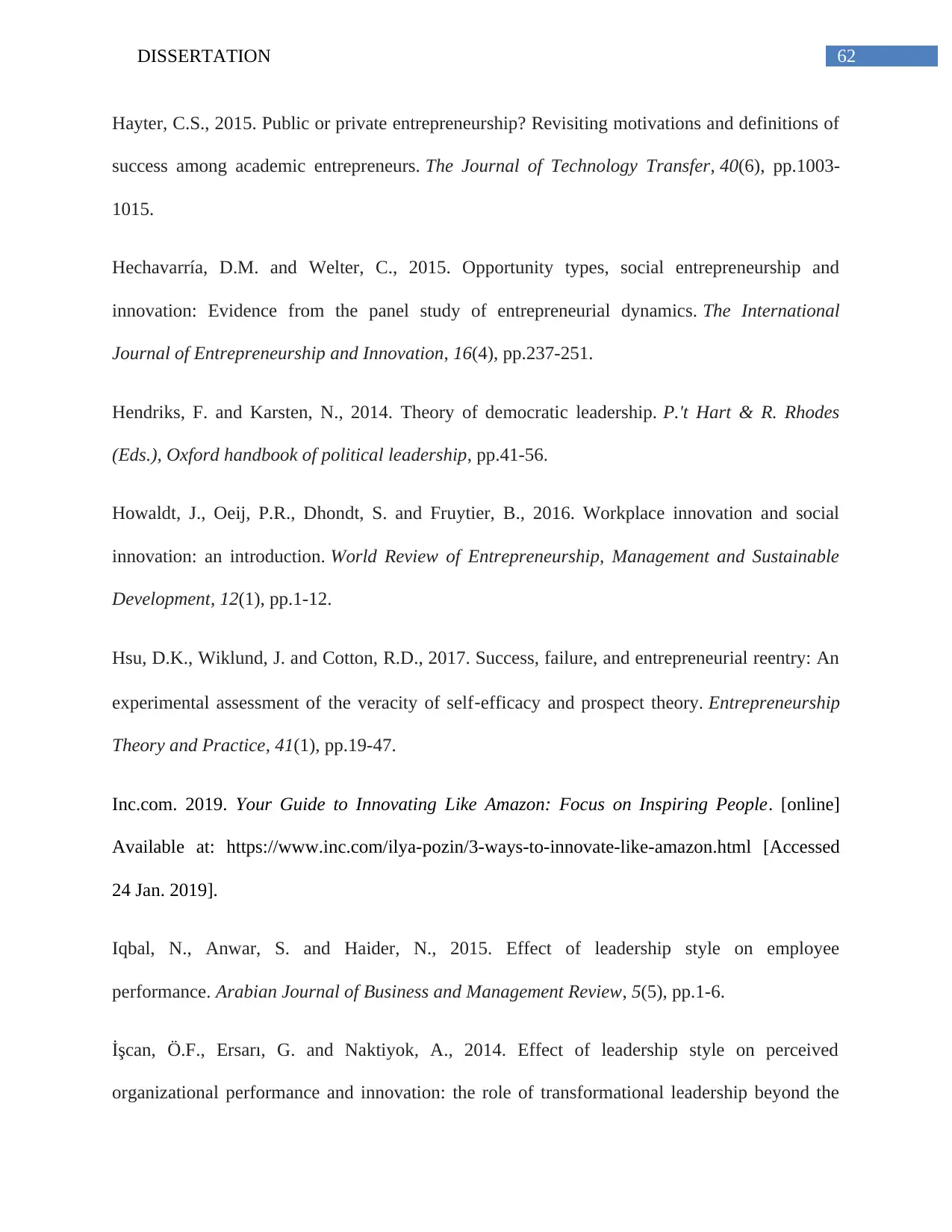
62DISSERTATION
Hayter, C.S., 2015. Public or private entrepreneurship? Revisiting motivations and definitions of
success among academic entrepreneurs. The Journal of Technology Transfer, 40(6), pp.1003-
1015.
Hechavarría, D.M. and Welter, C., 2015. Opportunity types, social entrepreneurship and
innovation: Evidence from the panel study of entrepreneurial dynamics. The International
Journal of Entrepreneurship and Innovation, 16(4), pp.237-251.
Hendriks, F. and Karsten, N., 2014. Theory of democratic leadership. P.'t Hart & R. Rhodes
(Eds.), Oxford handbook of political leadership, pp.41-56.
Howaldt, J., Oeij, P.R., Dhondt, S. and Fruytier, B., 2016. Workplace innovation and social
innovation: an introduction. World Review of Entrepreneurship, Management and Sustainable
Development, 12(1), pp.1-12.
Hsu, D.K., Wiklund, J. and Cotton, R.D., 2017. Success, failure, and entrepreneurial reentry: An
experimental assessment of the veracity of self‐efficacy and prospect theory. Entrepreneurship
Theory and Practice, 41(1), pp.19-47.
Inc.com. 2019. Your Guide to Innovating Like Amazon: Focus on Inspiring People. [online]
Available at: https://www.inc.com/ilya-pozin/3-ways-to-innovate-like-amazon.html [Accessed
24 Jan. 2019].
Iqbal, N., Anwar, S. and Haider, N., 2015. Effect of leadership style on employee
performance. Arabian Journal of Business and Management Review, 5(5), pp.1-6.
İşcan, Ö.F., Ersarı, G. and Naktiyok, A., 2014. Effect of leadership style on perceived
organizational performance and innovation: the role of transformational leadership beyond the
Hayter, C.S., 2015. Public or private entrepreneurship? Revisiting motivations and definitions of
success among academic entrepreneurs. The Journal of Technology Transfer, 40(6), pp.1003-
1015.
Hechavarría, D.M. and Welter, C., 2015. Opportunity types, social entrepreneurship and
innovation: Evidence from the panel study of entrepreneurial dynamics. The International
Journal of Entrepreneurship and Innovation, 16(4), pp.237-251.
Hendriks, F. and Karsten, N., 2014. Theory of democratic leadership. P.'t Hart & R. Rhodes
(Eds.), Oxford handbook of political leadership, pp.41-56.
Howaldt, J., Oeij, P.R., Dhondt, S. and Fruytier, B., 2016. Workplace innovation and social
innovation: an introduction. World Review of Entrepreneurship, Management and Sustainable
Development, 12(1), pp.1-12.
Hsu, D.K., Wiklund, J. and Cotton, R.D., 2017. Success, failure, and entrepreneurial reentry: An
experimental assessment of the veracity of self‐efficacy and prospect theory. Entrepreneurship
Theory and Practice, 41(1), pp.19-47.
Inc.com. 2019. Your Guide to Innovating Like Amazon: Focus on Inspiring People. [online]
Available at: https://www.inc.com/ilya-pozin/3-ways-to-innovate-like-amazon.html [Accessed
24 Jan. 2019].
Iqbal, N., Anwar, S. and Haider, N., 2015. Effect of leadership style on employee
performance. Arabian Journal of Business and Management Review, 5(5), pp.1-6.
İşcan, Ö.F., Ersarı, G. and Naktiyok, A., 2014. Effect of leadership style on perceived
organizational performance and innovation: the role of transformational leadership beyond the
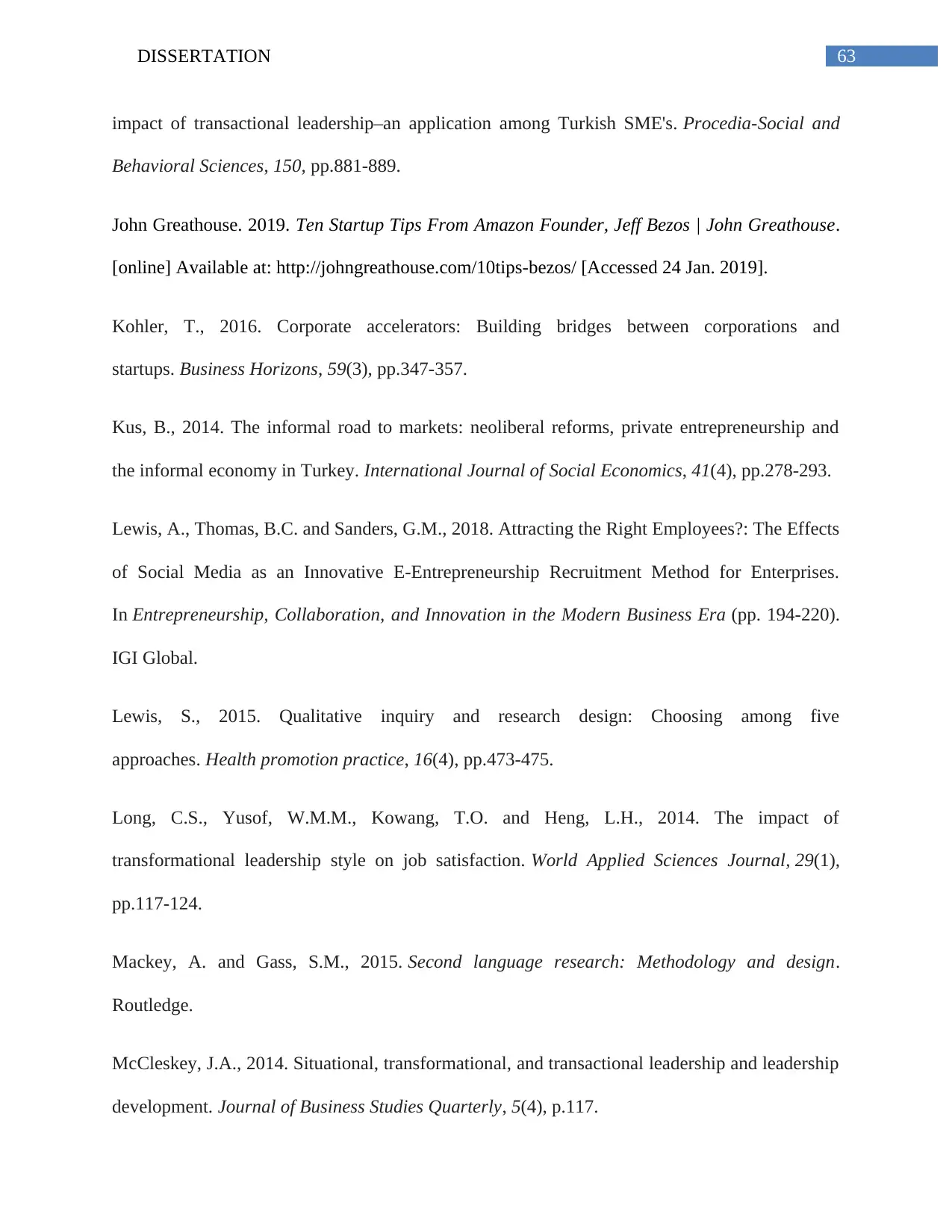
63DISSERTATION
impact of transactional leadership–an application among Turkish SME's. Procedia-Social and
Behavioral Sciences, 150, pp.881-889.
John Greathouse. 2019. Ten Startup Tips From Amazon Founder, Jeff Bezos | John Greathouse.
[online] Available at: http://johngreathouse.com/10tips-bezos/ [Accessed 24 Jan. 2019].
Kohler, T., 2016. Corporate accelerators: Building bridges between corporations and
startups. Business Horizons, 59(3), pp.347-357.
Kus, B., 2014. The informal road to markets: neoliberal reforms, private entrepreneurship and
the informal economy in Turkey. International Journal of Social Economics, 41(4), pp.278-293.
Lewis, A., Thomas, B.C. and Sanders, G.M., 2018. Attracting the Right Employees?: The Effects
of Social Media as an Innovative E-Entrepreneurship Recruitment Method for Enterprises.
In Entrepreneurship, Collaboration, and Innovation in the Modern Business Era (pp. 194-220).
IGI Global.
Lewis, S., 2015. Qualitative inquiry and research design: Choosing among five
approaches. Health promotion practice, 16(4), pp.473-475.
Long, C.S., Yusof, W.M.M., Kowang, T.O. and Heng, L.H., 2014. The impact of
transformational leadership style on job satisfaction. World Applied Sciences Journal, 29(1),
pp.117-124.
Mackey, A. and Gass, S.M., 2015. Second language research: Methodology and design.
Routledge.
McCleskey, J.A., 2014. Situational, transformational, and transactional leadership and leadership
development. Journal of Business Studies Quarterly, 5(4), p.117.
impact of transactional leadership–an application among Turkish SME's. Procedia-Social and
Behavioral Sciences, 150, pp.881-889.
John Greathouse. 2019. Ten Startup Tips From Amazon Founder, Jeff Bezos | John Greathouse.
[online] Available at: http://johngreathouse.com/10tips-bezos/ [Accessed 24 Jan. 2019].
Kohler, T., 2016. Corporate accelerators: Building bridges between corporations and
startups. Business Horizons, 59(3), pp.347-357.
Kus, B., 2014. The informal road to markets: neoliberal reforms, private entrepreneurship and
the informal economy in Turkey. International Journal of Social Economics, 41(4), pp.278-293.
Lewis, A., Thomas, B.C. and Sanders, G.M., 2018. Attracting the Right Employees?: The Effects
of Social Media as an Innovative E-Entrepreneurship Recruitment Method for Enterprises.
In Entrepreneurship, Collaboration, and Innovation in the Modern Business Era (pp. 194-220).
IGI Global.
Lewis, S., 2015. Qualitative inquiry and research design: Choosing among five
approaches. Health promotion practice, 16(4), pp.473-475.
Long, C.S., Yusof, W.M.M., Kowang, T.O. and Heng, L.H., 2014. The impact of
transformational leadership style on job satisfaction. World Applied Sciences Journal, 29(1),
pp.117-124.
Mackey, A. and Gass, S.M., 2015. Second language research: Methodology and design.
Routledge.
McCleskey, J.A., 2014. Situational, transformational, and transactional leadership and leadership
development. Journal of Business Studies Quarterly, 5(4), p.117.
Secure Best Marks with AI Grader
Need help grading? Try our AI Grader for instant feedback on your assignments.
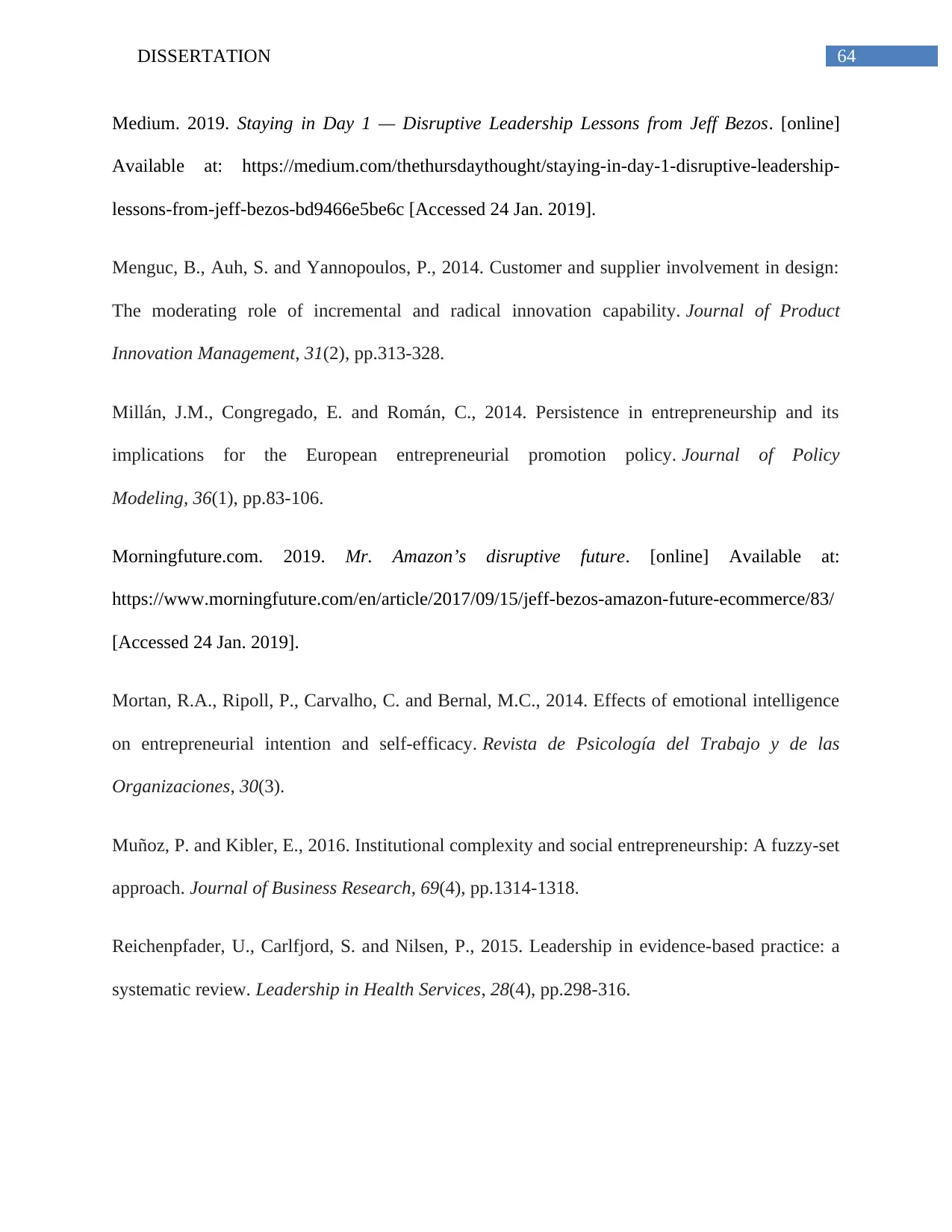
64DISSERTATION
Medium. 2019. Staying in Day 1 — Disruptive Leadership Lessons from Jeff Bezos. [online]
Available at: https://medium.com/thethursdaythought/staying-in-day-1-disruptive-leadership-
lessons-from-jeff-bezos-bd9466e5be6c [Accessed 24 Jan. 2019].
Menguc, B., Auh, S. and Yannopoulos, P., 2014. Customer and supplier involvement in design:
The moderating role of incremental and radical innovation capability. Journal of Product
Innovation Management, 31(2), pp.313-328.
Millán, J.M., Congregado, E. and Román, C., 2014. Persistence in entrepreneurship and its
implications for the European entrepreneurial promotion policy. Journal of Policy
Modeling, 36(1), pp.83-106.
Morningfuture.com. 2019. Mr. Amazon’s disruptive future. [online] Available at:
https://www.morningfuture.com/en/article/2017/09/15/jeff-bezos-amazon-future-ecommerce/83/
[Accessed 24 Jan. 2019].
Mortan, R.A., Ripoll, P., Carvalho, C. and Bernal, M.C., 2014. Effects of emotional intelligence
on entrepreneurial intention and self-efficacy. Revista de Psicología del Trabajo y de las
Organizaciones, 30(3).
Muñoz, P. and Kibler, E., 2016. Institutional complexity and social entrepreneurship: A fuzzy-set
approach. Journal of Business Research, 69(4), pp.1314-1318.
Reichenpfader, U., Carlfjord, S. and Nilsen, P., 2015. Leadership in evidence-based practice: a
systematic review. Leadership in Health Services, 28(4), pp.298-316.
Medium. 2019. Staying in Day 1 — Disruptive Leadership Lessons from Jeff Bezos. [online]
Available at: https://medium.com/thethursdaythought/staying-in-day-1-disruptive-leadership-
lessons-from-jeff-bezos-bd9466e5be6c [Accessed 24 Jan. 2019].
Menguc, B., Auh, S. and Yannopoulos, P., 2014. Customer and supplier involvement in design:
The moderating role of incremental and radical innovation capability. Journal of Product
Innovation Management, 31(2), pp.313-328.
Millán, J.M., Congregado, E. and Román, C., 2014. Persistence in entrepreneurship and its
implications for the European entrepreneurial promotion policy. Journal of Policy
Modeling, 36(1), pp.83-106.
Morningfuture.com. 2019. Mr. Amazon’s disruptive future. [online] Available at:
https://www.morningfuture.com/en/article/2017/09/15/jeff-bezos-amazon-future-ecommerce/83/
[Accessed 24 Jan. 2019].
Mortan, R.A., Ripoll, P., Carvalho, C. and Bernal, M.C., 2014. Effects of emotional intelligence
on entrepreneurial intention and self-efficacy. Revista de Psicología del Trabajo y de las
Organizaciones, 30(3).
Muñoz, P. and Kibler, E., 2016. Institutional complexity and social entrepreneurship: A fuzzy-set
approach. Journal of Business Research, 69(4), pp.1314-1318.
Reichenpfader, U., Carlfjord, S. and Nilsen, P., 2015. Leadership in evidence-based practice: a
systematic review. Leadership in Health Services, 28(4), pp.298-316.
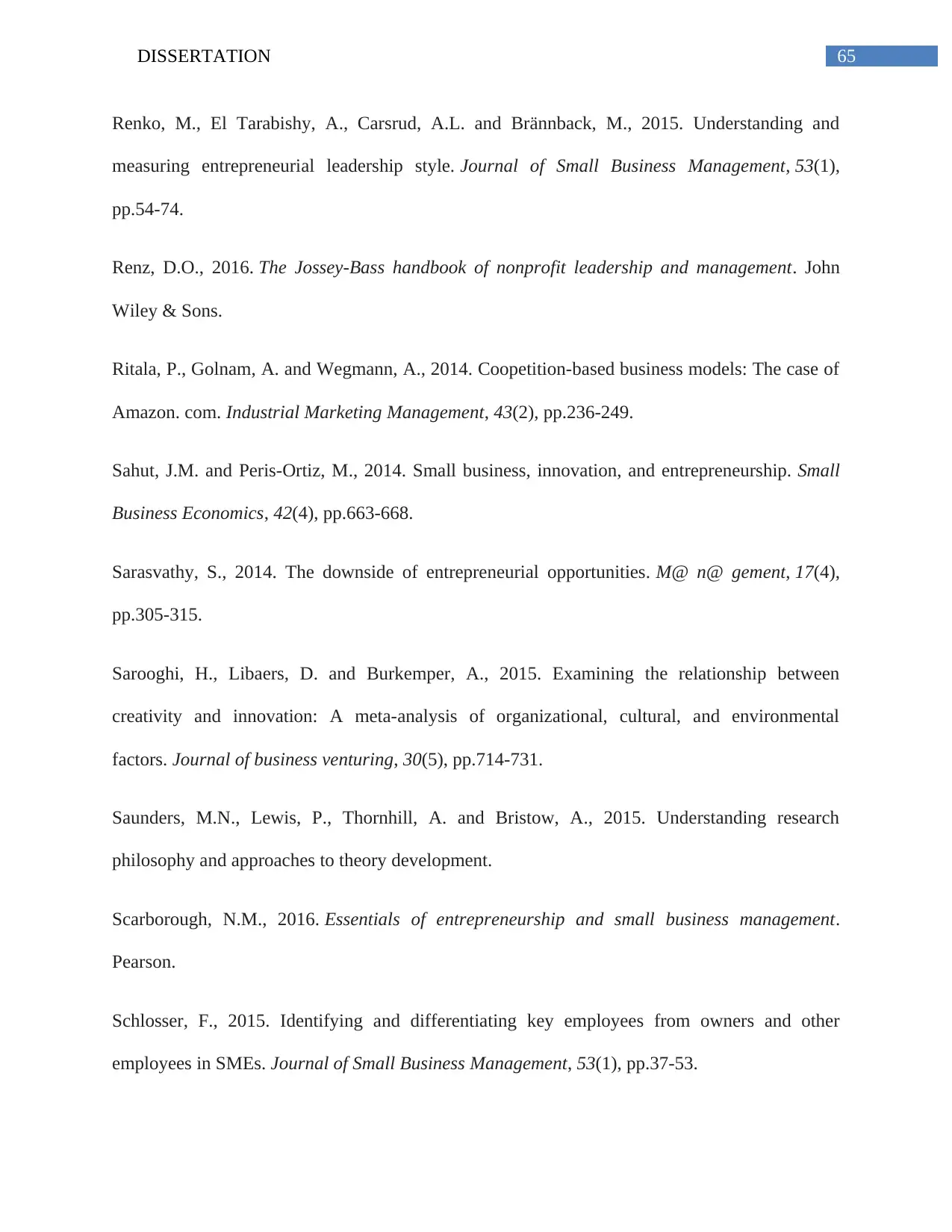
65DISSERTATION
Renko, M., El Tarabishy, A., Carsrud, A.L. and Brännback, M., 2015. Understanding and
measuring entrepreneurial leadership style. Journal of Small Business Management, 53(1),
pp.54-74.
Renz, D.O., 2016. The Jossey-Bass handbook of nonprofit leadership and management. John
Wiley & Sons.
Ritala, P., Golnam, A. and Wegmann, A., 2014. Coopetition-based business models: The case of
Amazon. com. Industrial Marketing Management, 43(2), pp.236-249.
Sahut, J.M. and Peris-Ortiz, M., 2014. Small business, innovation, and entrepreneurship. Small
Business Economics, 42(4), pp.663-668.
Sarasvathy, S., 2014. The downside of entrepreneurial opportunities. M@ n@ gement, 17(4),
pp.305-315.
Sarooghi, H., Libaers, D. and Burkemper, A., 2015. Examining the relationship between
creativity and innovation: A meta-analysis of organizational, cultural, and environmental
factors. Journal of business venturing, 30(5), pp.714-731.
Saunders, M.N., Lewis, P., Thornhill, A. and Bristow, A., 2015. Understanding research
philosophy and approaches to theory development.
Scarborough, N.M., 2016. Essentials of entrepreneurship and small business management.
Pearson.
Schlosser, F., 2015. Identifying and differentiating key employees from owners and other
employees in SMEs. Journal of Small Business Management, 53(1), pp.37-53.
Renko, M., El Tarabishy, A., Carsrud, A.L. and Brännback, M., 2015. Understanding and
measuring entrepreneurial leadership style. Journal of Small Business Management, 53(1),
pp.54-74.
Renz, D.O., 2016. The Jossey-Bass handbook of nonprofit leadership and management. John
Wiley & Sons.
Ritala, P., Golnam, A. and Wegmann, A., 2014. Coopetition-based business models: The case of
Amazon. com. Industrial Marketing Management, 43(2), pp.236-249.
Sahut, J.M. and Peris-Ortiz, M., 2014. Small business, innovation, and entrepreneurship. Small
Business Economics, 42(4), pp.663-668.
Sarasvathy, S., 2014. The downside of entrepreneurial opportunities. M@ n@ gement, 17(4),
pp.305-315.
Sarooghi, H., Libaers, D. and Burkemper, A., 2015. Examining the relationship between
creativity and innovation: A meta-analysis of organizational, cultural, and environmental
factors. Journal of business venturing, 30(5), pp.714-731.
Saunders, M.N., Lewis, P., Thornhill, A. and Bristow, A., 2015. Understanding research
philosophy and approaches to theory development.
Scarborough, N.M., 2016. Essentials of entrepreneurship and small business management.
Pearson.
Schlosser, F., 2015. Identifying and differentiating key employees from owners and other
employees in SMEs. Journal of Small Business Management, 53(1), pp.37-53.
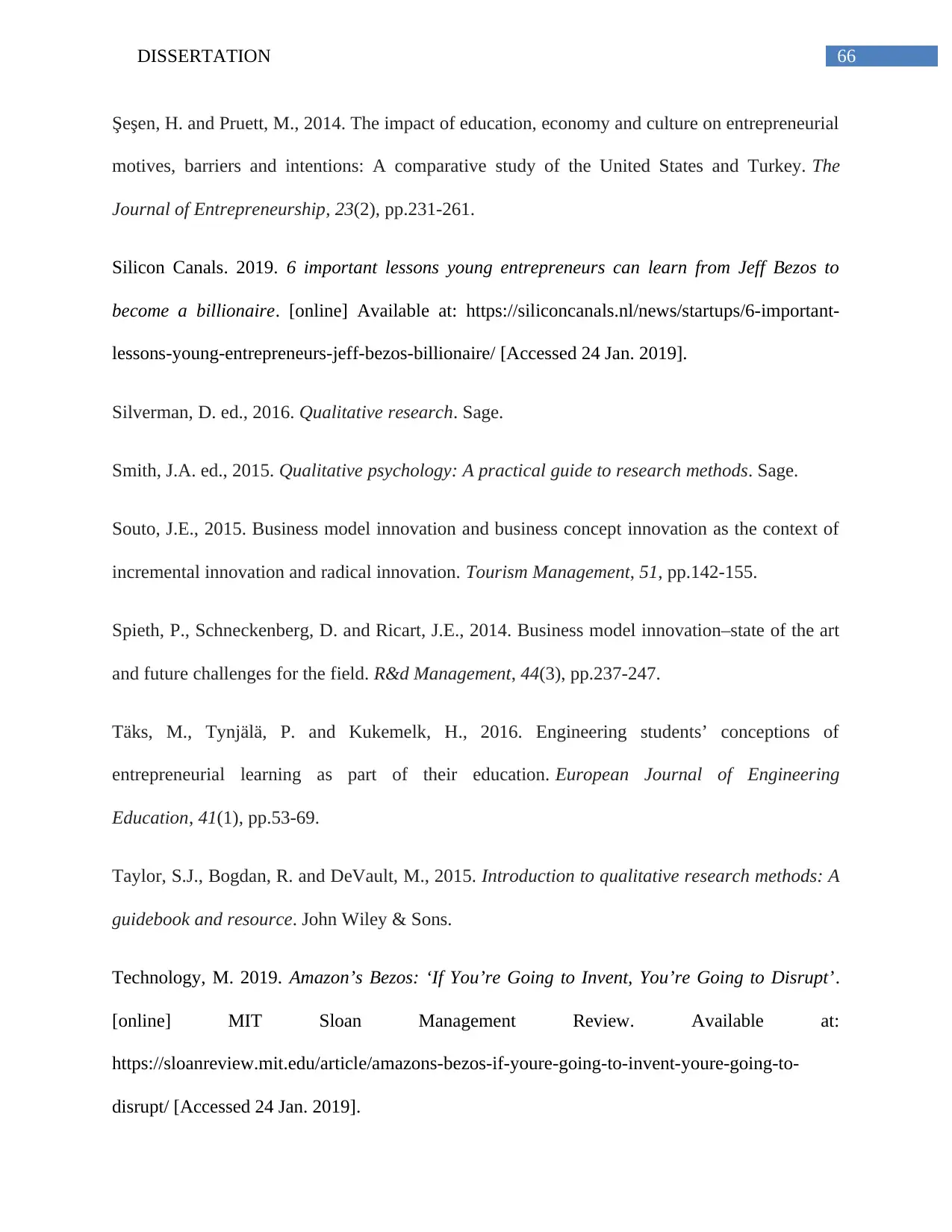
66DISSERTATION
Şeşen, H. and Pruett, M., 2014. The impact of education, economy and culture on entrepreneurial
motives, barriers and intentions: A comparative study of the United States and Turkey. The
Journal of Entrepreneurship, 23(2), pp.231-261.
Silicon Canals. 2019. 6 important lessons young entrepreneurs can learn from Jeff Bezos to
become a billionaire. [online] Available at: https://siliconcanals.nl/news/startups/6-important-
lessons-young-entrepreneurs-jeff-bezos-billionaire/ [Accessed 24 Jan. 2019].
Silverman, D. ed., 2016. Qualitative research. Sage.
Smith, J.A. ed., 2015. Qualitative psychology: A practical guide to research methods. Sage.
Souto, J.E., 2015. Business model innovation and business concept innovation as the context of
incremental innovation and radical innovation. Tourism Management, 51, pp.142-155.
Spieth, P., Schneckenberg, D. and Ricart, J.E., 2014. Business model innovation–state of the art
and future challenges for the field. R&d Management, 44(3), pp.237-247.
Täks, M., Tynjälä, P. and Kukemelk, H., 2016. Engineering students’ conceptions of
entrepreneurial learning as part of their education. European Journal of Engineering
Education, 41(1), pp.53-69.
Taylor, S.J., Bogdan, R. and DeVault, M., 2015. Introduction to qualitative research methods: A
guidebook and resource. John Wiley & Sons.
Technology, M. 2019. Amazon’s Bezos: ‘If You’re Going to Invent, You’re Going to Disrupt’.
[online] MIT Sloan Management Review. Available at:
https://sloanreview.mit.edu/article/amazons-bezos-if-youre-going-to-invent-youre-going-to-
disrupt/ [Accessed 24 Jan. 2019].
Şeşen, H. and Pruett, M., 2014. The impact of education, economy and culture on entrepreneurial
motives, barriers and intentions: A comparative study of the United States and Turkey. The
Journal of Entrepreneurship, 23(2), pp.231-261.
Silicon Canals. 2019. 6 important lessons young entrepreneurs can learn from Jeff Bezos to
become a billionaire. [online] Available at: https://siliconcanals.nl/news/startups/6-important-
lessons-young-entrepreneurs-jeff-bezos-billionaire/ [Accessed 24 Jan. 2019].
Silverman, D. ed., 2016. Qualitative research. Sage.
Smith, J.A. ed., 2015. Qualitative psychology: A practical guide to research methods. Sage.
Souto, J.E., 2015. Business model innovation and business concept innovation as the context of
incremental innovation and radical innovation. Tourism Management, 51, pp.142-155.
Spieth, P., Schneckenberg, D. and Ricart, J.E., 2014. Business model innovation–state of the art
and future challenges for the field. R&d Management, 44(3), pp.237-247.
Täks, M., Tynjälä, P. and Kukemelk, H., 2016. Engineering students’ conceptions of
entrepreneurial learning as part of their education. European Journal of Engineering
Education, 41(1), pp.53-69.
Taylor, S.J., Bogdan, R. and DeVault, M., 2015. Introduction to qualitative research methods: A
guidebook and resource. John Wiley & Sons.
Technology, M. 2019. Amazon’s Bezos: ‘If You’re Going to Invent, You’re Going to Disrupt’.
[online] MIT Sloan Management Review. Available at:
https://sloanreview.mit.edu/article/amazons-bezos-if-youre-going-to-invent-youre-going-to-
disrupt/ [Accessed 24 Jan. 2019].
Paraphrase This Document
Need a fresh take? Get an instant paraphrase of this document with our AI Paraphraser
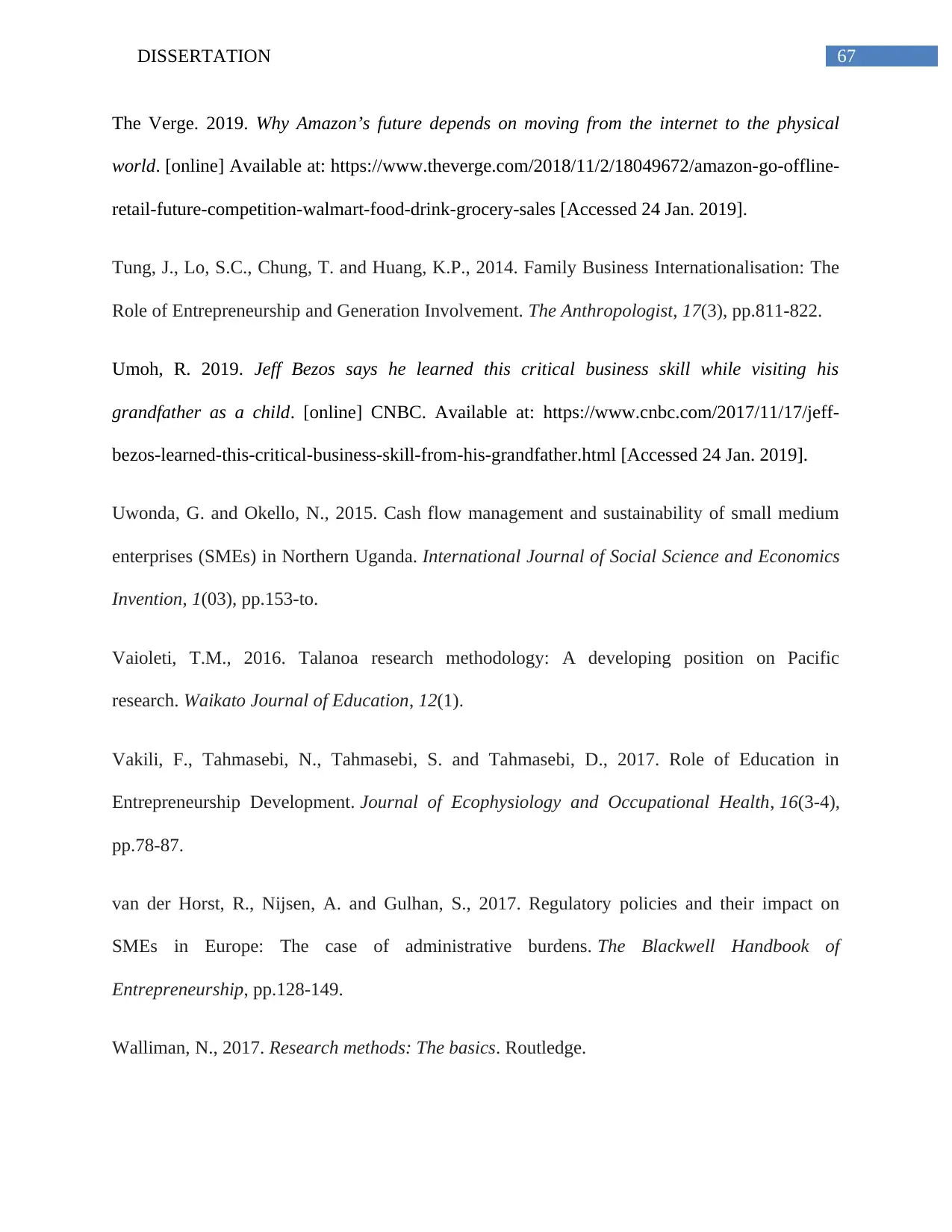
67DISSERTATION
The Verge. 2019. Why Amazon’s future depends on moving from the internet to the physical
world. [online] Available at: https://www.theverge.com/2018/11/2/18049672/amazon-go-offline-
retail-future-competition-walmart-food-drink-grocery-sales [Accessed 24 Jan. 2019].
Tung, J., Lo, S.C., Chung, T. and Huang, K.P., 2014. Family Business Internationalisation: The
Role of Entrepreneurship and Generation Involvement. The Anthropologist, 17(3), pp.811-822.
Umoh, R. 2019. Jeff Bezos says he learned this critical business skill while visiting his
grandfather as a child. [online] CNBC. Available at: https://www.cnbc.com/2017/11/17/jeff-
bezos-learned-this-critical-business-skill-from-his-grandfather.html [Accessed 24 Jan. 2019].
Uwonda, G. and Okello, N., 2015. Cash flow management and sustainability of small medium
enterprises (SMEs) in Northern Uganda. International Journal of Social Science and Economics
Invention, 1(03), pp.153-to.
Vaioleti, T.M., 2016. Talanoa research methodology: A developing position on Pacific
research. Waikato Journal of Education, 12(1).
Vakili, F., Tahmasebi, N., Tahmasebi, S. and Tahmasebi, D., 2017. Role of Education in
Entrepreneurship Development. Journal of Ecophysiology and Occupational Health, 16(3-4),
pp.78-87.
van der Horst, R., Nijsen, A. and Gulhan, S., 2017. Regulatory policies and their impact on
SMEs in Europe: The case of administrative burdens. The Blackwell Handbook of
Entrepreneurship, pp.128-149.
Walliman, N., 2017. Research methods: The basics. Routledge.
The Verge. 2019. Why Amazon’s future depends on moving from the internet to the physical
world. [online] Available at: https://www.theverge.com/2018/11/2/18049672/amazon-go-offline-
retail-future-competition-walmart-food-drink-grocery-sales [Accessed 24 Jan. 2019].
Tung, J., Lo, S.C., Chung, T. and Huang, K.P., 2014. Family Business Internationalisation: The
Role of Entrepreneurship and Generation Involvement. The Anthropologist, 17(3), pp.811-822.
Umoh, R. 2019. Jeff Bezos says he learned this critical business skill while visiting his
grandfather as a child. [online] CNBC. Available at: https://www.cnbc.com/2017/11/17/jeff-
bezos-learned-this-critical-business-skill-from-his-grandfather.html [Accessed 24 Jan. 2019].
Uwonda, G. and Okello, N., 2015. Cash flow management and sustainability of small medium
enterprises (SMEs) in Northern Uganda. International Journal of Social Science and Economics
Invention, 1(03), pp.153-to.
Vaioleti, T.M., 2016. Talanoa research methodology: A developing position on Pacific
research. Waikato Journal of Education, 12(1).
Vakili, F., Tahmasebi, N., Tahmasebi, S. and Tahmasebi, D., 2017. Role of Education in
Entrepreneurship Development. Journal of Ecophysiology and Occupational Health, 16(3-4),
pp.78-87.
van der Horst, R., Nijsen, A. and Gulhan, S., 2017. Regulatory policies and their impact on
SMEs in Europe: The case of administrative burdens. The Blackwell Handbook of
Entrepreneurship, pp.128-149.
Walliman, N., 2017. Research methods: The basics. Routledge.
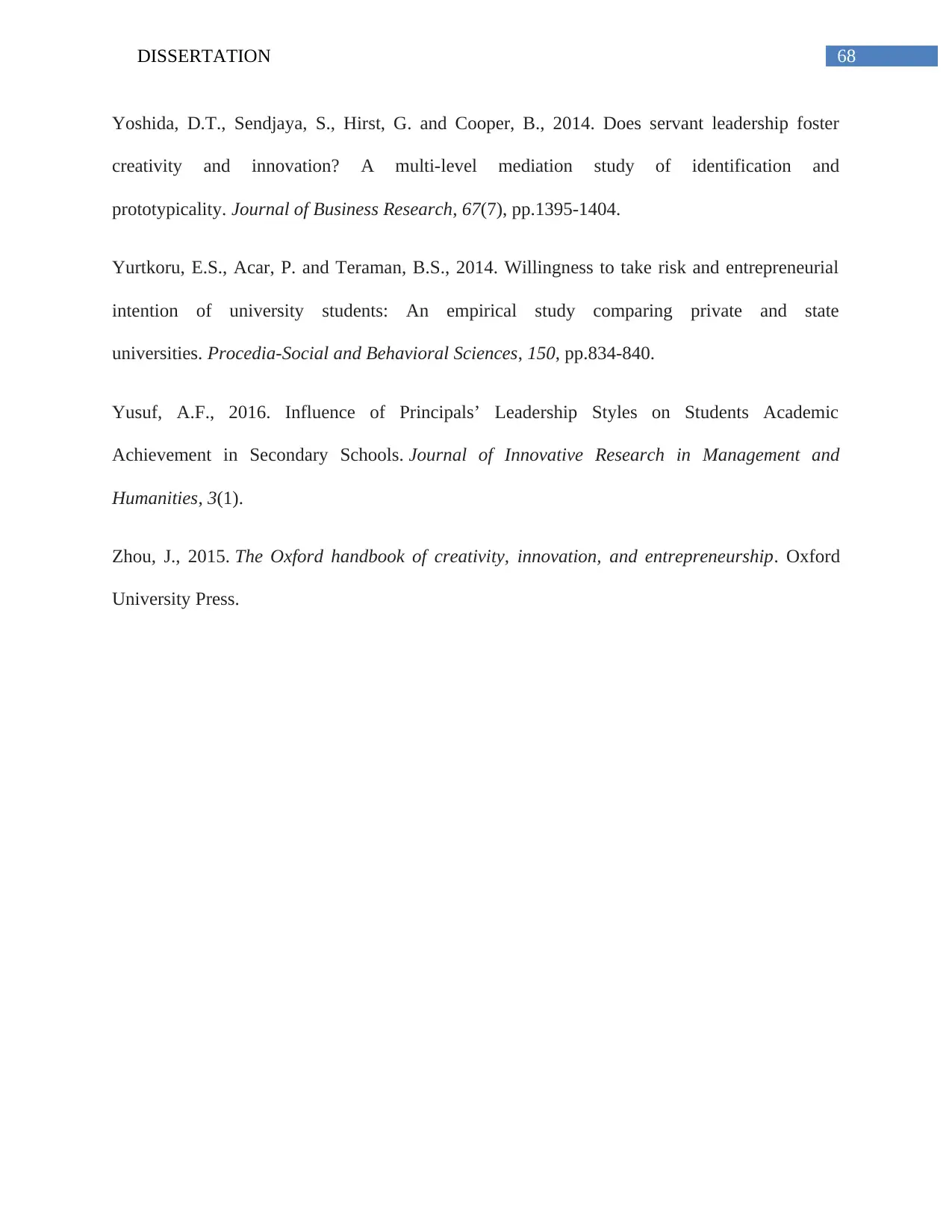
68DISSERTATION
Yoshida, D.T., Sendjaya, S., Hirst, G. and Cooper, B., 2014. Does servant leadership foster
creativity and innovation? A multi-level mediation study of identification and
prototypicality. Journal of Business Research, 67(7), pp.1395-1404.
Yurtkoru, E.S., Acar, P. and Teraman, B.S., 2014. Willingness to take risk and entrepreneurial
intention of university students: An empirical study comparing private and state
universities. Procedia-Social and Behavioral Sciences, 150, pp.834-840.
Yusuf, A.F., 2016. Influence of Principals’ Leadership Styles on Students Academic
Achievement in Secondary Schools. Journal of Innovative Research in Management and
Humanities, 3(1).
Zhou, J., 2015. The Oxford handbook of creativity, innovation, and entrepreneurship. Oxford
University Press.
Yoshida, D.T., Sendjaya, S., Hirst, G. and Cooper, B., 2014. Does servant leadership foster
creativity and innovation? A multi-level mediation study of identification and
prototypicality. Journal of Business Research, 67(7), pp.1395-1404.
Yurtkoru, E.S., Acar, P. and Teraman, B.S., 2014. Willingness to take risk and entrepreneurial
intention of university students: An empirical study comparing private and state
universities. Procedia-Social and Behavioral Sciences, 150, pp.834-840.
Yusuf, A.F., 2016. Influence of Principals’ Leadership Styles on Students Academic
Achievement in Secondary Schools. Journal of Innovative Research in Management and
Humanities, 3(1).
Zhou, J., 2015. The Oxford handbook of creativity, innovation, and entrepreneurship. Oxford
University Press.
1 out of 69
Related Documents
Your All-in-One AI-Powered Toolkit for Academic Success.
+13062052269
info@desklib.com
Available 24*7 on WhatsApp / Email
![[object Object]](/_next/static/media/star-bottom.7253800d.svg)
Unlock your academic potential
© 2024 | Zucol Services PVT LTD | All rights reserved.





